
The Project Gutenberg EBook of Thames Valley Villages, Volume 1 (of 2), by Charles G. Harper This eBook is for the use of anyone anywhere in the United States and most other parts of the world at no cost and with almost no restrictions whatsoever. You may copy it, give it away or re-use it under the terms of the Project Gutenberg License included with this eBook or online at www.gutenberg.org. If you are not located in the United States, you'll have to check the laws of the country where you are located before using this ebook. Title: Thames Valley Villages, Volume 1 (of 2) Author: Charles G. Harper Illustrator: W. S. Campbell Release Date: June 23, 2018 [EBook #57365] Language: English Character set encoding: UTF-8 *** START OF THIS PROJECT GUTENBERG EBOOK THAMES VALLEY VILLAGES, VOL 1 *** Produced by Chris Curnow and the Online Distributed Proofreading Team at http://www.pgdp.net (This file was produced from images generously made available by The Internet Archive)
Transcriber’s Note: Illustrations have been moved so as not to fall in the middle of paragraphs (leaving them as close to the original position in the book as possible). A few minor printing errors were corrected.
Volume II is available as Project Gutenberg ebook #57366.

THAMES VALLEY VILLAGES
WORKS BY CHARLES G. HARPER
The Portsmouth Road, and its Tributaries: To-day and in Days of Old.
The Dover Road: Annals of an Ancient Turnpike.
The Bath Road: History, Fashion, and Frivolity on an Old Highway.
The Exeter Road: The Story of the West of England Highway.
The Great North Road: The Old Mail Road to Scotland. Two Vols.
The Norwich Road: An East Anglian Highway.
The Holyhead Road: The Mail-Coach Road to Dublin. Two Vols.
The Cambridge, Ely, and King’s Lynn Road: The Great Fenland Highway.
The Newmarket, Bury, Thetford, and Cromer Road: Sport and History on an East Anglian Turnpike.
The Oxford, Gloucester, and Milford Haven Road: The Ready Way to South Wales. Two Vols.
The Brighton Road: Speed, Sport, and History on the Classic Highway.
The Hastings Road and the “Happy Springs of Tunbridge.”
Cycle Rides Round London.
A Practical Handbook of Drawing for Modern Methods of Reproduction.
Stage Coach and Mail in Days of Yore. Two Vols.
The Ingoldsby Country: Literary Landmarks of “The Ingoldsby Legends.”
The Hardy Country: Literary Landmarks of the Wessex Novels.
The Dorset Coast.
The South Devon Coast.
The Old Inns of Old England. Two Vols.
Love in the Harbour: a Longshore Comedy.
Rural Nooks Round London (Middlesex and Surrey).
Haunted Houses: Tales of the Supernatural.
The Manchester and Glasgow Road. This way to Gretna Green. Two Vols.
The North Devon Coast.
Half Hours with the Highwaymen. Two Vols.
The Autocar Road Book. Four Vols.
The Tower of London: Fortress, Palace, and Prison.
The Somerset Coast.
The Smugglers: Picturesque Chapters in the Story of an Ancient Craft.
The Cornish Coast. North.
The Cornish Coast. South.
The Kentish Coast. [In the Press.
The Sussex Coast. [In the Press.

AT ASHTON KEYNES.
THAMES VALLEY
VILLAGES
BY
CHARLES G. HARPER
VOL. I
ILLUSTRATED FROM PHOTOGRAPHS BY W. S. CAMPBELL
AND FROM DRAWINGS BY THE AUTHOR

ISIS
London: CHAPMAN & HALL, Ltd.
1910
PRINTED AND BOUND BY
HAZELL, WATSON AND VINEY, LD.,
LONDON AND AYLESBURY.
| PAGE | |
| Introduction | 1 |
| CHAPTER I | |
| Cirencester—Source of the Thames—Kemble—Ashton Keynes—Cricklade—St. Augustine’s Well | 8 |
| CHAPTER II | |
| Castle Eaton—Kempsford—By the Thames and Severn Canal to Inglesham Round House—Lechlade—Fairford—Eaton Hastings Weir—Kelmscott—Radcot Bridge | 50 |
| CHAPTER III | |
| Great Faringdon—Buckland—Bampton-in-the-Bush—Cote—Shifford | 110 |
| CHAPTER IV | |
| Harvests of the Thames: Willows, Osiers, Rushes | 128 |
| [viii]CHAPTER V | |
| New Bridge, The Oldest on the Thames—Standlake—Gaunt’s House—Northmoor—Stanton Harcourt—Besselsleigh | 138 |
| CHAPTER VI | |
| Cumnor, and the Tragedy of Amy Robsart | 161 |
| CHAPTER VII | |
| Wytham—The Old Road—Binsey and the Oratory of St. Frideswide—the Vanished Village of Seacourt—Godstow and “Fair Rosamond”—Medley—Folly Bridge | 186 |
| CHAPTER VIII | |
| Iffley, and the Way Thither—Nuneham, in Storm and in Sunshine | 200 |
| CHAPTER IX | |
| Abingdon | 216 |
| CHAPTER X | |
| Sutton Courtney—Long Wittenham—Little Wittenham—Clifton Hampden—Day’s Lock and Sinodun | 234 |
| [ix]CHAPTER XI | |
| Dorchester—Benson | 260 |
| CHAPTER XII | |
| Wallingford—Goring | 272 |
| CHAPTER XIII | |
| Streatley—Basildon—Pangbourne—Mapledurham—Purley | 293 |
| At Ashton Keynes | Frontispiece |
| PAGE | |
| Cirencester Church: Showing the Great Buttress | 11 |
| The Old Mill House, Ashton Keynes | 23 |
| The Infant Thames, Ashton Keynes | 31 |
| Approach to Cricklade | 35 |
| St. Sampson, Cricklade | 39 |
| Strainer-Buttress, St. Sampson’s, Cricklade | 43 |
| “Lertoll Well” | 43 |
| The Iron Girder Bridge, Castle Eaton | 51 |
| The Old Bridge, Castle Eaton | 51 |
| Castle Eaton Church: Showing Sanctus-Bell Turret | 55 |
| The Thames and Severn Canal, Near Kempsford | 55 |
| Kempsford Church | 61 |
| Inglesham Round House | 67 |
| A Street in Fairford | 71 |
| Lechlade | 75 |
| Fairford, from the River Coln | 79 |
| The Great West Window, Fairford, Displaying the “Doom” | 83 |
| Monument in the Park, Fairford, where the Famous Windows were Buried | 87 |
| Kelmscott Manor | 95 |
| [xii]Kelmscott Church | 99 |
| Radcot Bridge | 103 |
| A Thames-side Farm | 125 |
| Gateway, Cote House | 125 |
| A Thames-side Farm | 129 |
| New Bridge: the Oldest Bridge across the Thames | 139 |
| Northmoor: Church and Dovecote | 143 |
| Stanton Harcourt: Manor House and Church | 147 |
| Early English Screen (Unrestored), Stanton Harcourt | 153 |
| Cumnor Church | 163 |
| Statue of Queen Elizabeth, Cumnor Church | 167 |
| Tomb of Anthony Forster, Cumnor | 173 |
| Eynsham | 187 |
| Iffley Church: North Side | 201 |
| West Door, Iffley Church | 205 |
| The Bridge, Nuneham Courtney | 209 |
| Carfax Conduit, Nuneham Courtney | 213 |
| Abingdon | 217 |
| The Town Hall, Abingdon | 223 |
| St. Helen’s, Abingdon | 227 |
| Old Houses, Steventon Causeway | 231 |
| Sutton Courtney Church | 235 |
| Sutton Courtney | 239 |
| Interior, Sutton Courtney Church | 239 |
| Ancient Timber Porch, Long Wittenham (Unrestored) | 245 |
| Day’s Lock, and Sinodun Hill | 249 |
| Clifton Hampden | 257 |
| Sedilia, Dorchester Abbey | 261 |
| The East Window, Dorchester Abbey | 265 |
| The Jesse Window (on the left), Dorchester Abbey | 269 |
| Dorchester | 273 |
| Dorchester Abbey | 273 |
| [xiii]Wallingford | 277 |
| Wallingford: Town Hall, and Church of St. Mary-the-More | 281 |
| Goring Church | 285 |
| Hour-Glass Stand, South Stoke | 285 |
| Pangbourne Church | 291 |
| Basildon Church | 291 |
| Whitchurch | 297 |
| Mapledurham Mill | 301 |
| Mapledurham House | 305 |
| Near Kemble | 19 |
| At Ewen | 21 |
| At Ashton Keynes | 22 |
| Ashton Keynes Mill | 27 |
| Old Woodwork, Castle Eaton | 58 |
| Norman Porch, Kempsford | 60 |
| Inglesham Church | 65 |
| Ancient Carving, Lechlade Church | 73 |
| Fiends | 82, 85 |
| Faringdon Clump | 101 |
| St. Stephen | 107 |
| Clanfield Church | 108 |
| Faringdon Market House | 117 |
| Wooden Bridge across the Upper Thames | 118 |
| Bampton Church | 123 |
| The Kitchen, Stanton Harcourt | 150 |
| Besselsleigh: Church and Fragment of Manor House | 157 |
| Binsey Church | 192 |
| Christ’s Hospital, Abingdon | 221 |
| St. Nicholas, Abingdon | 225 |
| The “King’s Head and Bell,” Abingdon | 233 |
| Norman Belfry-window, Sutton Courtney | 238 |
| Little Wittenham | 245 |
| Wittenham Clumps | 253 |
The Thames we all know intimately, for the river was discovered by the holiday-maker in the ’seventies of the nineteenth century; but we do not all know the villages of the Thames Valley, and it was partly to satisfy a long-cherished curiosity on this point, and partly to make holiday in some of the little-known nooks yet remaining, that this tour was undertaken.
To one who lives, or exists, or resides—the reader is invited to choose his own epithet—beside the lower Thames, there must needs at times come a longing to know that upper stream whence these mighty waters originate, to find that fount where “Father Thames” starts forth in hesitating, infantile fashion; to seek that spot where the stream, instead of flowing, merely trickles. To such an one there comes, with every recurrent spring, the longing to penetrate to the Beyond, away past where the towns and villages, the water-works and breweries cluster thickly beside the river-banks; above the town of Reading, the Biscuit Town, and town of sauce and seeds; beyond the fashionable summer scene of Henley[2] Regatta, and past the city of Oxford, to the Upper River and its unconventionalised life.
When spring comes and wakes the meadows with delight, and the osiers and the rushes again feel life stirring in their dank roots, the old schoolboy feeling of curiosity, of mystery, of a desire for exploration, springs anew. You walk down, it may be, to some slipway or draw-dock by Richmond or Teddington, or wander along those shores contemplating the high-water-marks left by the late winter floods, which not even the elaborate locking of the river seems able to prevent; and observing the curious line of refuse of every description brought down by the waters, and now left, high and dry, a matted mass of broken rushes, water weeds, twigs, string and the like, marvel at the wealth of corks that displays itself there. Children have been known to make expedition towards the distant hills, seeking that place where the rainbow touches the ground; for the sly old legend tells us that on the spot where the glorious bow meets the earth there lies buried a crock of gold. An equally speculative quest would be to fare forth and seek the Place whence the Corks Come. There (not for children, but for “grown-ups”) should be, you think, the Land of Heart’s Desire.
There are, I take it, three chief things that the world of men most ardently wishes for. An unregenerate man’s first desires are to wealth, to a woman, and to a drink; or, in the words attributed to Martin Luther:
and the valley of the Thames, from Oxford to Richmond, would seem, by the evidence of these millions of corks of all kinds, to be a place flowing with champagne, light wines, all kinds of mineral waters, and bottled beers.
Corks, rubber rings from broken mineral-water bottles, and big bungs that hint of two-or three-gallon jars, abound; these last telling in no uncertain manner of the magnificent thirsts inspired among anglers who sit in punts all day long, and do nothing but keep an eye on the float, and maintain the glass circulating.
A thirsty person wandering by these bestrewn towing-paths must sigh to think of the exquisite drinks that have gone before, leaving in this multitude of corks the only evidence of their evanescent existence. Shall we not seek it, this land of the foaming champagne, that comes creaming to the brim of the generous glass; shall we not hope to locate those shores, far or near, where the bottled Bass, poured into the ready tumbler, tantalises the parched would-be drinker of it in the all-too-slowly-subsiding mass of froth that lies between him and his expectant palate? Shall we not, at least if we be of “temperance” leanings, quaff the cool and refreshing “stone-bottle” ginger-beer; or, failing that, the skimpy and deleterious “mineral-water” “lemonade” that is chiefly compounded of sugar and carbonic-acid gas, and blows painfully and at high-pressure through the titivated nostrils? Shall we not—— but hold there! Waiter, bring me—what shall it be?—an iced stone-bottle ginger!
That was the brave time, the golden age of the river, when, rather more than a generation ago, the discovery of the Thames as a holiday haunt was first made. The fine rapture of those early tourists, who, deserting the traditional seaside lounge for a cruise down along the placid bosom of the Thames, from Lechlade to Oxford, and from Oxford to Richmond, were (something after the Ancient Mariner sort) the first to burst into these hitherto unknown reaches, can never be recaptured. The bloom has been brushed from off the peach by the rude hands of crowds of later visitors. The waterside inns, once so simple under their heavy beetling eaves of thatch, are now modish, instead of modest; and Swiss and German waiters, clothed in deplorable reach-me-down dress-suits and lamentable English of the Whitechapel-atte-Bowe variety, have replaced the neat-handed—if heavy-footed—Phyllises, who were almost in the likeness of those who waited upon old Izaak Walton, two centuries and a quarter ago.
To-day, along the margin of the Thames below Oxford, some expectant mercenary awaits at every slipway and landing-place the arrival of the frequent row-boat and the plenteous and easily-earned tip; and the lawns of riparian villas on either hand exhibit a monotonous repetition of “No Landing-Place,” “Private,” and “Trespassers Prosecuted” notices; while side-channels are not infrequently marked “Private Backwater.”
All the villages immediately giving upon the stream have suffered an equally marked change, and have become uncharacteristic of their old selves, and converted[5] into the likeness of no other villages in this our England, in these our times. There is, for example, a kind of theatrical prettiness and pettiness about Whitchurch, over against Pangbourne; and instead of looking upon it as a real, living three-hundred-and-sixty-five-days-in-the-year kind of place, you are apt to think of what a pretty “set” it makes; and, doing so, to speak of its bearings in other than the usual geographical terms of east and west, north and south; and to refer to them, indeed, after the fashion of the stage, as “P.” or “O.P.” sides.
But if we find at Whitchurch a meticulous neatness, a compact and small-scale prettiness eminently theatrical, what shall we say of its neighbour, Pangbourne, on the Berkshire bank of the river? That is of the other modern riverain type: an old village spoiled by the expansion that comes of being situated on a beautiful reach of the Thames, and with a railway station in its very midst. Detestable so-styled “villas,” and that kind of shops you find nowhere else than in these Thames-side spots, have wrought Pangbourne into something new and strange; and motor-cars have put the final touch of sacrilege upon it.
Perhaps you would like to know of what type the typical Thames-side village shop may be, nowadays? Nothing easier than to draw its portrait in few words. It is, to begin with, inevitably a “Stores,” and is obviously stocked with the first object of supplying boating-parties and campers with the necessaries of life, as understood by campers and boating-parties. As tinned provisions take a prominent place in those[6] holiday commissariats, it follows that the shop-windows are almost completely furnished with supplies of tinned everything, festering in the sun. For the rest, you have cheap camp-kettles, spirit-stoves, tin enamelled cups and saucers, and the like utensils, hammocks and lounge-chairs.
Thus the modern riverside village is unpleasing to those who like to see places retain their old natural appearance, and dislike the modern fate that has given it a spurious activity in a boating-season of three months, with a deadly-dull off-season of nine other months every year. We may make shift to not actively dislike these sophisticated places in summer, but let us not, if we value our peace of mind, seek to know them in winter; when the sloppy street is empty, even of dogs and cats; when rain patters like small-shot on the roof of the inevitable tin-tabernacle that supplements the over-restored, and spoiled, parish church; and when the roar of the swollen weir fills the air with a thudding reverberance. Pah!
The villas, the “maisonettes,” are empty: the gardens draggle-tailed; the “Nest” is “To Let”; the “Moorings” “To be Sold”; and a general air of “has been” pervades the place, with a desolating feeling that “will again be” is impossible.
But let us put these things behind us, and come to the river itself; to the foaming weir under the lowering sky, where such a head of water comes hurrying down that no summer frequenter of the river can ever see. There is no dead, hopeless season in nature; for although the trees may be bare, and the groves dismantled, the wintry woods have their own beauty,[7] and even in mid-winter give promise of better times.
But along the uppermost Thames, from Thames Head to Lechlade and Oxford, the waterside villages are still very much what they have always been. All through the year they live their own life. Not there do the villas rise redundant, nor the old inns masquerade as hotels, nor chorus-girls inhabit at weekends, in imitative simplicity. A voyage along the thirty-two miles of narrow, winding river from Lechlade to Oxford has no incidents more exciting than the shooting of a weir, or the watching of a moor-hen and her brood.
Below Oxford, we have but to adventure some little way to right or left of the stream, and there, in the byways (for main roads do not often approach the higher reaches of the river), the unaltered villages abound.
CIRENCESTER—SOURCE OF THE THAMES—KEMBLE—ASHTON KEYNES—CRICKLADE—ST. AUGUSTINE’S WELL
The head-spring of the Thames is, in summer, not so easy a place to find. It rises on the borders of Wilts and Gloucestershire, and has been marked down and written about sufficiently often; but the exact spot is quested for with difficulty, and when the traveller has found it, he is, after all, not sure of his find, for the place is supplied, in these latter days, with no recognisable landmark, and even the road-men and the infrequent wayfarers along that ancient way, the Akeman Street, which runs close by, appear uncertain. That it is “over there, somewhere,” is the most exact information the enquirer is likely, at a venture, to obtain.
There are excellent reasons for this distressing incertitude. The winter reason is that Trewsbury Mead, the great flat meadow in which Thames Head is situated, is so water-logged that it is often a morass, and not infrequently a lake. In summer, on the other hand, the spot is so parched, partly on account of the season, but much more by reason of the pumping-works in the immediate neighbourhood, that not only[9] the Thames Head spring is quite dry, but the bed of the infant Thames itself is generally dry for the first two miles of its course.
Thames Head is situated three miles south-west of Cirencester, that beautiful old stone-built town whose name we are traditionally told to pronounce “Ciceter,” just as Shakespeare wrote it. That was the old popular way, before the folks of the surrounding country could read or write, and knew no better; but to-day, when “education” is the birthright of all, though culture be the acquisition of few, they are the rustic-folk—the “lower orders”—who say “Cirencester,” as my lords and gentlemen and ladies were wont to do; while nowadays the upper circles refer to “Ciceter.” It is a curious reversal. If you say, in these times, “Cirencester,” you, in so doing, proclaim yourself, socially, an outsider, fit only to feed out of the same trough as those creatures who pronounce “Marjoribanks,” “Cholmondeley,” or “Wemyss” as spelled. We all know—or ought—that “Marshbanks,” “Chumley,” and “Weems” are your only ways, if you would be socially saved. These are the last resorts of those who have no other distinction to mark them out from the common herd: just a verbal inflection, combined, possibly, with a method of hand-shaking. To what straits we are reduced, in these democratic times, to express our superiority!
There is another way to the pronunciation of “Cirencester,” lately come into favour with provincials of this neighbourhood. It is a method of the simplest: merely the adoption of the clipped[10] way common to the local milestones, which tell the tale of so many miles to “Ciren.”
The noblest thing in Cirencester is the beautiful old church, which rises in its midst, beside the remarkably broad High Street, with much of that scale and stateliness we commonly associate with a cathedral. It is one of the noblest works of the Perpendicular period, when architects grew aspiring, but did not always succeed in building artistically as well as big. Here the two aims have been achieved. But a third desideratum, that of building securely, was not originally included, it would appear, for one of the most astonishing things about this structure is the great masonry strut which would be called a “shore” if it were only in timber, and is so clearly for utility, and absolutely unbeautiful and unarchitectural, that to style it a buttress would be to disparage the exquisite adornments that buttresses at their best are capable of being. This great crutch for a noble tower in danger of falling so soon as it was built, nearly five hundred years ago, is, however, justified of its existence, for the lofty belfry yet stands securely. The ingenious way in which the supporting masonry is built diagonally through the west wall of the south aisle, down to the ground, compels admiration for the engineering skill displayed.

CIRENCESTER CHURCH: SHOWING THE GREAT BUTTRESS.
The great three-storeyed porch, by far the largest porch, and certainly the most singular, in England, built in advance of the south aisle, and looking proudly upon the street, would seem to have been built for the convenience of the many priests who served the large number of chantries established from time to time[13] in the church. It is a very late and very beautiful Perpendicular work. Not long after its completion the greasy rascals were sent packing, in the life-giving Reformation that saved the nation. It for long afterwards served as the Town Hall, but was commonly known as “the Vice”—a strange survival and corruption of “parvise.”
The interior of the church discloses a nave-arcade of very lofty and graceful proportions; a work probably as completely satisfactory as anything in this country. And there is very much else to study here. There are monuments, worn and battered, to knights and dames, wine-merchants, wool-merchants, grocers, and other old tradesmen of the town. Among them may be noticed the brass to Reginald Spycer, 1442, with his four wives—Reginald in the middle, and the four ladies beside him, two and two. A late example is that of Philip Marner, 1587, representing him full-length, robed, with staff in one hand and a flower in the other. A dog sits beside him. In the upper left-hand is a pair of shears, indicating that he was a clothier. The rhymed inscription says:—
In a glazed frame is preserved an ancient blue velvet pulpit-cloth, given in 1478 by Ralph Parsons, a priest, whose cope it had been.
The road that runs, white and broad, in a straight[14] undeviating line, from Cirencester to Thames Head, and so on at last, after many miles, to Bath—the “Akemanceaster” that has given the Akeman Street its name—comes in three miles to a stone bridge spanning a canal. This is “Thames Head Bridge,” and the canal is the Thames and Severn Canal, which, beginning at Inglesham, just above Lechlade, ends at Stroud. The length of this water-way is thirty miles. The works were begun in 1783 and completed in 1789.
The object of the Thames and Severn Canal, which joins the Stroudwater Canal, and reaches the Severn at Framilode, was to provide a commercial water-way between the highest point of the navigable Thames, near Lechlade, and the Bristol Channel. Its course lies along some very high ground just beyond Thames Head, going westward, and in all there are forty-four locks, rising 241 ft. 3 in. There is also a remarkable piece of engineering in the Sapperton Tunnel, through which the canal takes its course. The tunnel is fifteen feet wide, and is driven through Sapperton Hill at a point 250 feet beneath its summit.
It follows that of necessity a canal, so elevated above the surrounding country, must be provided with water by artificial means, and a supply is provided by a pumping-station close at hand to Thames Head Bridge. This raises water to the extent of three million gallons a day: hence the dried-up character of the Thames Head spring, except in winter, and the usual summer phenomenon of the infant Thames being quite innocent of water for a distance of two miles from its source. Of late years the Great Western[15] Railway, which has a station at Kemble, a mile and a half away, has erected a still larger and more powerful pumping-station, for the purpose of supplying water for its own needs at Swindon, fourteen miles distant.
The Akeman Street here divides Wiltshire and Gloucestershire. If we descend from the Thames Head Canal bridge and follow the towing-path in a westerly direction, into Gloucestershire, for half a mile, we come, by scrambling down the canal-bank to the meadow below, to the source of the river, and at the same time to the destruction of a cherished illusion. Picturesque old histories of the Thames have made us familiar with Thames Head, and have shown us dainty vignettes of that spring. One such I have before me as I write these words. It shows a rustic well, overhung by graceful trees, with a little country-girl in homely pinafore dipping a foot in the water as it gushes forth. We need expect no such scene nowadays. The well is buried under fallen masses of the dull, ochre-coloured earth of Trewsbury Mead, and all we see is a rough, dry hollow, overhung by trees which refuse to live up to the grace suggested by the old illustrations. We need not wonder any more why so few people know Thames Head, or why the spot is unmarked. It is merely a memory, and Peacock’s charming verse has long ceased to be applicable:—
But although the pumping-stations so greedily suck up all the available moisture in summer, the spring is said often to burst out in winter, three feet high; and at such times it is only necessary to drive a walking-stick anywhere into the turf of this meadow for a little fount to spring up from the hole thus drilled.
The river thus originated is known alternatively as the “Isis,” and in the writings of old pedantic antiquaries retains that alternative name until Oxford is passed and Dorchester reached; where, according to such authorities, in the confluence of the Isis and the Thame, the “Thame-Isis,” becomes the “Tamesis,” or Thames. To the Oxford boating-man, however, the streams below and above Oxford are respectively the Lower and the Upper River, and “Isis” is reserved for the title of a University magazine, or the name of a boating-club.
“Isis” is, of course, a Latinised form of “Ouse,” which in its turn is a modified form of the Celtic “uisc,” for water, and gives us such other river-names as Usk, Axe, Exe, and Wye; while we find it hidden again in the names of Kirkby Wiske, in Yorkshire, and in that of “whisky,” deriving from “usquebaugh.”
The time when the Upper Thames was first called “Isis” is uncertain. The name is certainly a Latinised form of “Ouse”; but the Romans do not appear to have so styled it. Julius Cæsar, in his Commentaries, speaks only of “Tamesis”; and the Anglo-Saxon Chronicle, A.D. 905, mentions only the “Thames.” We do not, in fact, read of anything like “Isis” until 1359, when a monk of Chester,[17] Ranulphus Higden, wrote in his Polychronicon a passage which, rendered into English from his Latin original, runs thus: “Tamisa seems to be composed from the names of two rivers, the Ysa, or Usa, and the Thama. The Thama, running by Dorchester, falls into the Ysa; thence the whole river, from its source to the eastern sea, is called Thamisa.” A much later writer, Leland, I think, says, in that rarefied, detached way we expect in old writers, “The common people call it the ‘Thames,’ but scholars call it the ‘Isis.’”
The name of “Thames” is equally Celtic with that of the Latinised “Isis,” nor is it the only Thames in the country, for the river Tamar, dividing Devon and Cornwall; the Teme, in Shropshire and Herefordshire; and the Tame, in Staffordshire, are each closely allied in name.
The generally-accepted source of the Thames at Thames Head has by no means gone undisputed, and a rival exists at Seven Springs, three miles south-east of Cheltenham. This spot is the source of the river Churn, which, falling into the Thames at Cricklade, after a course of sixteen or seventeen miles, takes the stream some ten miles farther up-country than that which issues from Thames Head. Thus we have the singular paradox, that the Churn, this first tributary of the Thames, is considerably longer than the parent stream. This is a problem that would have desolated the logical mind of Euclid, and it has worried geographers and writers of books for uncounted years. No matter how diligently we may seek to track this heresy to its lair—to its original propagation—we shall inevitably be foiled; nor indeed (as in the case[18] of rival religious dogmas) shall we ever be able to definitely settle which of the two is the heresy, and which the true faith. If we rely upon the canon that the source of any river is that point which is situated farthest from its mouth, and then refer to the maps, there can be no doubt whatever that the Churn is the true Thames, and that the Seven Springs source is its head-spring. It is an unavoidable conclusion, like it or like it not; and if we take the trouble to visit Seven Springs, we shall discover that some one has been concerned to mark the spot prominently with the same belief, in the inscription set up there on a wall going down into the pool:—
or, in English,
We can only assume, in the difficulty with which we are thus faced, that the original error, of placing Thames Head at Trewsbury Mead, and naming the stream which issues from Seven Springs the “Churn,” arose in those very remote times, before even the Romans came to Britain, when surveying and map-making were unknown and relative distances were uncertain. That the river Churn bore its present name even at the period when the Romans descended upon Britain is an assured thing, for the Romans named Corinium—the present “Cirencester”—from[19] its situation on the Churn. The existing form of the place-name is of Saxon origin, and is really “Churnchester”—the “castle on the Churn.”
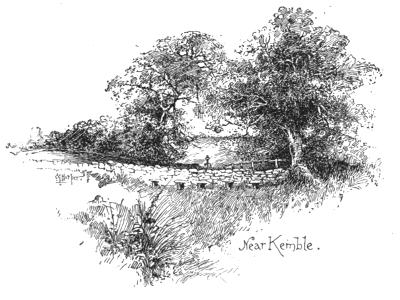
Near Kemble.
Kemble Junction, the railway station that dominates this neighbourhood, marks where the little four-mile branch of the Great Western Railway goes off to Cirencester from the line to Stroud and Gloucester. There is no likely expectation that Cirencester will begin to grow and to lose its old-world character while it remains, as now, at the loose end of this little single-track branch railway; and the hunting-men of this Vale of White Horse district remain quite unconcerned and unafraid of developments. This country, between Cirencester, Cricklade and Lechlade, is a hunting country and an agricultural country, and long centuries ago it lost to Leeds and Bradford, and other like centres, the clothing industry for which this Cotswold district was in mediæval times and after[20] famed. Thus Kemble Junction is by no means a junction of the Swindon or the Clapham Junction type, and is rather a peaceful than a bustling place. The village itself stands on rising ground above this district of springs. Even though it be more remarkable for its stone walls than for anything else, it is a not unpleasing village, for in a neighbourhood such as this, where laminated stone is easily dug out from a few feet below the level of the soil, we expect dry stone walling and stone-built houses; and certainly the hard stony effect is softened by the plentiful trees of the place. The Early English church, with tall spire, 120 feet high, has been so thoroughly “restored,” and swept and garnished, and so plentifully endued with plaster, that architects with a love of antiquity, and all antiquaries, looking upon it, can scarce refrain from tears. Inside the church is a curious monument—
Dedicated to the memory of Beatrice and Edward, the deare wife and son of Mr. Richard Pitt, both interred within these walls, shee the 26th day of Aprill 1650, hee the 29th day of March 1656
| who { | Conflicted | } in ye Church { | militant |
| were buried | materiall | ||
| Do reigne | triumphant. |
She died i’ th’ noone, he in the morne, of Age, yet virtue (though not yeres) fil’d their lives’ page.
We shall probably not be wrong in regarding this as one of the ultra-Puritan families of that Puritan age.
Just below Kemble, on the way to the hamlet of Ewen, the course of the Thames is in summer hardly to be distinguished in the meadows through which it runs. Grass covers it, in common with the meadows themselves; only the grass is of a ranker and coarser kind, and largely admixed with docks. The dry-walling of one of these meadows shows the winter direction of the stream clearly enough, in the row of holes left in building the wall for the water to pass through.
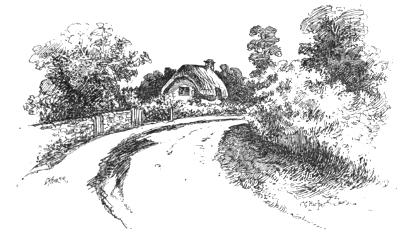
AT EWEN.
Ewen, standing by the roadside, is remarkable only for its rustic cottages, but they are particularly beautiful in their old unstudied way; heavily thatched, and surrounded with old-fashioned gardens. The Thames begins to flow, or to trickle, regularly at Upper Somerford Mill, whose water-wheel, immense in proportion to the little stream, is picturesquely sheltered under wide-spreading trees. The village of Somerford Keynes lies close at hand.
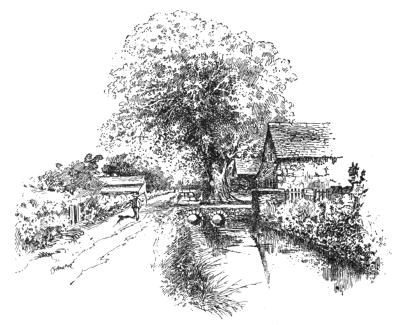
AT ASHTON KEYNES.
The way between this village and Ashton Keynes passes over rough common-land, and enters Ashton Keynes romantically, past the great church, and along a fine avenue of elms beside the manor-house, emerging at what, until a few years ago, was Ashton Keynes Mill. The elm avenue of Ashton Keynes is other than we should expect, if we come to the place primed with a knowledge of what the “Keynes” in the place-name signifies. Those elms should be oaks, for “Keynes” derives from the ancient Norman word for an oak-tree; in later French, “chênaie.” Hence also the name of Horsted Keynes, in Sussex.
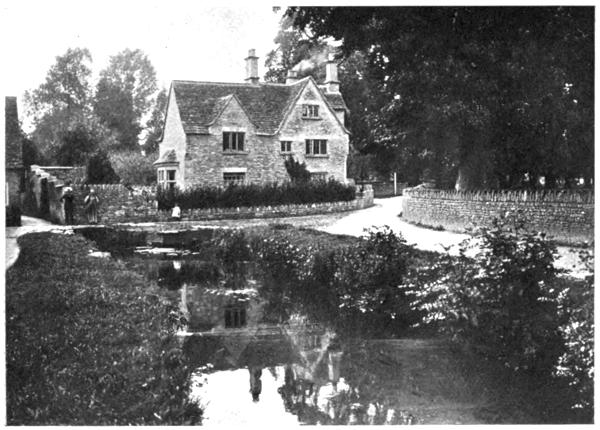
THE OLD MILL HOUSE, ASHTON KEYNES.
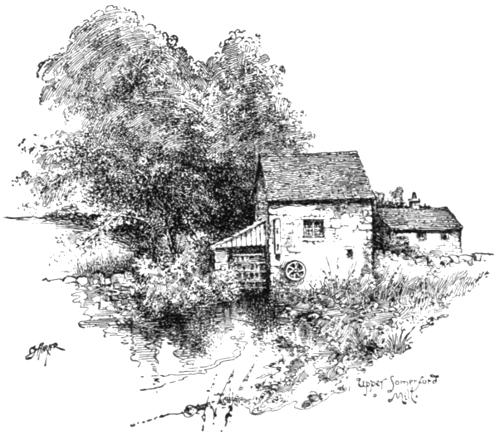
Upper Somerford Mill.
All the old mills that once made the Thames additionally picturesque are disappearing. Some go up in flame and smoke, like Iffley Mill, below Oxford, painted and sketched by a thousand artists, and described by a hundred writers of books and descriptive[25] articles, to whose lasting sorrow it was destroyed by fire in 1907. Shiplake Mill met a similar fate a little earlier, and modern milling conditions forbid their ever being rebuilt. Ashton Keynes Mill became disestablished, as a mill, because it could no longer compete with the modern steam-roller flour-mills, that nowadays grind flour much more expeditiously and cheaply than the old water-driven mills. But the old mill-house stands, little altered. It is built substantially, of stone, and has old peaked gables and casemented windows, and so, when its ancient commercial career came at last to an end, its own picturesqueness, and its strikingly beautiful setting, appealed irresistibly to some appreciative person seeking an old English home; with the result that it has been converted into a very charming private residence.
Little need be said about Ashton Keynes church, for it is of very late Gothic, and plentifully uninteresting; but the village itself is a delight. It is the queen of Upper Thames villages, with a picture at every turn. Here the Thames flows quietly down one side of the village street, and at the beginning of that rural, cottage-bordered, tree-shaded highway is the first bridge across the river; an ancient Gothic bridge, with a slipway beside it, where the horses are brought down to wash their legs in summer. Beside the bridge stand the remains of one of the three fifteenth-century wayside crosses which once gave Ashton Keynes a peculiarly sanctified look. The ruins of all three are still here,—smashed originally during the seventeenth-century troubles in which[26] King, Church, Parliament and Puritans contended violently together; and further damaged by the mischievous pranks of many generations of village children.
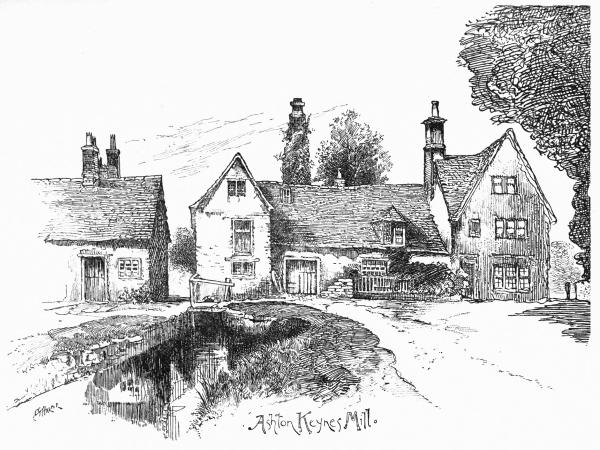
Ashton Keynes Mill.
There are many little bridges spanning the Thames at Ashton Keynes, for the stream washes the old stone garden-walls of a long line of cottages, and the entrance to each cottage necessitates a bridge of stone, of brick, or of timber. Stonecrop, candytuft, wallflowers, arabis, snapdragon, and many other semi-wild plants grow in the crevices of these old walls, and drape them all the summer with an unimaginable mantle of beauty; and where the cottages end, and the highway becomes a straight flat road, making for Cricklade, a modern country residence has been built, with the walls of it going down in the same way into the water, and the wild flowers encouraged in the like fashion to inhabit there. A contemplative person might pass a pleasant time at Ashton Keynes, where there is a homely inn, but none of those unamusing “amusements” which serve to render places of holiday resort unendurable. For those not very numerous persons who are satisfied with their own company Ashton Keynes affords decided attractions. No one ever goes there, for it is on the road to Nowhere in Particular, and not even the motor-car is a very familiar sight. Thus the ruminative stranger will have his privacy respected; unless indeed he happens to be either an artist or a photographer, when he is certain to be surrounded by a dense crowd of children, who seem to become instinctively aware of an open sketch-book or a camera at hand, and surround the owners[29] of them in most embarrassing fashion. The artist is the more fortunate of the two, for it is only an easily-satisfied curiosity to see what he is doing which attracts these unwelcome attentions; while the unfortunate photographer is pestered with requests to be “took,” and worried to extremity of despair by hordes of fleeting children obscuring his camera’s field of vision, or posing grotesquely and in most damaging fashion in his choicest foregrounds.
Below Ashton Keynes the Thames is joined by the little Swillbrook, and crossed at the confluence by the small, three-arched masonry Oaklade Bridge. A mile or so below this is Water Hay Bridge, a typical “county” bridge, whose frame of iron girders and railings, painted white, ill assorts with the luxuriance of swaying reeds and thickly-clustered alders that here enshrouds the stream.
We read in old accounts of the Thames that it was navigable for barges as far as this point, and “Water Hay” may possibly be a corruption of Water Hythe, indicating a wharf. It is in this connection to be noted that the Cricklade and Ashton Keynes road crosses here, and that however unlikely it may now seem that the stream could ever have been navigable to this spot for such heavy craft as barges, it must always be borne in mind that, in the many general causes that have led to the shrinkage of rivers throughout the country, and here in especial in the pumping away of the head-spring of the Thames, the stream cannot now closely compare with its old self of a hundred and fifty years ago. We may therefore very well believe those old writers who speak of the Thames[30] being navigable to this point, and imagine, readily enough, a rude wharf where goods were landed, and left for Ashton Keynes and surrounding villages, in days when even the few roads of the present time either did not exist at all, or were so bad that haulage along them was almost impossible, by reason either of the mud, or of the water that very often flooded them.
Between this and the little town of Cricklade the stream winds continually, but the road goes straight over Water Hay Bridge and makes direct for the townlet, three miles distant. The navigation of these first few miles of the Thames was long ago considered to be so irretrievably a thing of the past, that it was permitted the constructors of the North Wilts Canal, in crossing the stream, one mile above Cricklade, to build a brick bridge or aqueduct so low-pitched across it that the crown of the arch scarcely appears above water, and effectually stops any attempt to get even a canoe through.

THE INFANT THAMES, ASHTON KEYNES.
The approach to Cricklade from the west by road is a noble introduction to the town. It is a small town, of entirely agricultural character, yet it has been a place of importance in its day; and although that day has long passed, its two churches of St. Sampson and St. Mary prove it to have been once considerable. Cricklade, indeed, standing on the Ermine Way, the Roman road that led from Spinae to Corinium—or in modern terms, from Speen by Newbury to Cirencester—could not have been other than important. The invading Danes, making their way up the Thames Valley in A.D. 905, and again in 1016,[33] found it worth while plundering, and it has from very early times been a market-town. It prospered in a quiet way until the opening of the Thames and Severn Canal, in 1789, for it was, after the ancient wharf at Water Hay had been abandoned, at the head of the Thames navigation; but when the canal came past, outside the northern end of the town, the water-borne traffic halted here no more, and Cricklade was, in a minor-tragical way, ruined. Nor have railways served ever to redress the injustice. The Great Western comes no nearer than the small wayside station of Purton, four miles distant, and although the Midland and South-Western Junction Railway comes to Cricklade, and has a station here, the railway management—judging from the fact of its providing only one train a day each way, at inconvenient hours—would much rather you did not use it, you know, if you don’t mind. And the Cricklade people do not use it, and go the four miles to Purton, instead. We have, therefore, not the slightest prospect of Cricklade ever growing. It is quite in keeping with the rural look of the one long broad street of Cricklade, bordered by houses that are, for the most part, of cottage-like appearance, that it has for centuries been known as the “Peasant Borough”: the technical territorial “township” including no fewer than fifty-one surrounding parishes. That it should have been, until the passing of an early Reform Act, also a Parliamentary borough, returning members to Parliament, does not of itself seem remarkable, knowing as we do that places like Gatton and Old Sarum, with no inhabitants at all, shared the same privilege. Cricklade, however, lost its[34] representation through long-continued and shameless bribery.
Here, in the long silent streets of Cricklade, the stranger is noted curiously in summer, the local season being in winter; for this is now a hunting-centre of the divided Vale of White Horse country, and the hounds are kennelled here.
Cricklade, we are told, is properly “cerriglád”: an ancient British expression signifying a “stony ford”; but is it not, even more properly, “Cerrig-let,” i.e. the stony place where the river Churn has its outlet to the Thames? We have several places in England in which “cerrig” is hidden under various corruptions: notably Crick, in Northamptonshire, and numerous places named Creech, in widely-sundered districts; while in Wales we find Cerrig-y-Druidion in the north, and Crickhowell in the south. In Scotland the word is commonly rendered “Craig.”

APPROACH TO CRICKLADE.
But old writers who flourished before the science of place-names had come into existence generally guessed at the meaning of the names of those places of which they wrote; and extremely bad guesses they almost always made. Their way with “Cricklade” is a shocking example of a “reach-me-down” ready-made meaning, supplying a barbarous misfit. Cricklade, if you please, is, according to these seekers after truth who are content to pick up the first obvious lie that rests in their path, or to seize the first absurdity that suggests itself, is “Greeklade,” the site of a forgotten Greek university established here even before the coming of the Romans. Forgotten! yes: that university is easily forgotten which had never[37] any existence; but this derivation served its day, and was generally accepted. Thus we find the poet Drayton content to write in his Polyolbion:
But Drayton erred only where others had erred for some seven or eight hundred years; for indeed the absurd legend derives from the name of “Greek-islade,” given to the town in the time of Alfred the Great.
St. Sampson’s, the chief church of Cricklade, stands by the road as you enter from the direction of Ashton Keynes; its tall, curiously-panelled tower framed beautifully in the view by a noble group of hedgerow elms. This odd dedication puzzles most people, and in truth St. Sampson, or “Samson,” without the “p,” is a remote and obscure personage who flourished in the sixth century, and is thought to have died A.D. 560. He appears to have been a Breton who fled his country, and in after-years returned to Brittany and became Bishop of Dôl. Two other churches are dedicated to him: South Hill, by Launceston, and Golant, near Lostwithiel, in Cornwall; while the island of Samson, in the Scilly Isles, owes its name to this source. Milton Abbey, in Dorsetshire, was formerly quadruply dedicated to SS. Mary, Michael, Samson, and Bradwalladr; while there still exists a St. Sampson’s church in the City of York. But that owes its name to another fellow—an early Archbishop of York; so early, indeed, that he is not generally included among the primates. He, strangely enough,[38] appears to have been contemporary with, and a friend of, the other Sampson.

ST. SAMPSON, CRICKLADE.
This church of St. Sampson at Cricklade does the saint especial honour, for it is a much more than usually fine cruciform building, greatly superior to the usual parish type. It presents, in general, an exterior view of Perpendicular character, even though, on closer examination, the architectural expert may discover very considerable Early English and Decorated portions. The central tower is its great feature, for you not only see it from afar, but on a closer view it is found to be so strikingly individual that even those persons unusually well-versed in these things are puzzled to find anywhere its fellow. The detailed illustration of it in this book will render unnecessary any lengthy description; and will at the same time reveal the noble quality of its sturdy pinnacles and the exquisitely effective character of the deep panelling that covers the upper stage and mounts into the angle-turrets. It is a finely massive, robust design, to which the elegant light pierced parapet adds a contrasting note of airy grace. In the detailed view of this tower an empty niche will be seen, which probably once held a statue of the eponymous saint of this church. On the side of the tower not shown a keen eye may observe a pair of scissors sculptured at a considerable height from the ground: an indication, doubtless, that the tower, rebuilt in its present form, owed its existence to the benefaction of one of those wealthy clothiers who in the fifteenth century attained in the Cotswold and surrounding districts to their highest degree of prosperity, and gave liberally of their wealth to the[41] rebuilding of churches, the founding of almshouses, and other good deeds, and have left numerous records of their existence in the fine monumental brasses of Wiltshire and Gloucestershire, ensigned with their merchants’-marks or the emblems of their trade—the wool-pack and the shears, in place of the heraldic achievements of nobler persons.
The interior of this charming church is even more noble than the impressive exterior bids us expect. It is at once massive, and well-lighted, and graceful: the climax of its beauty found beneath the central tower, where the piers and arches and finely-ribbed vaulting go soaring up to form a handsome lantern, set about with many shields, sculptured with the arms of Edward the Confessor, of the diocese of Salisbury, and of the Dudleys, Earls of Warwick. Prominent here among these cognizances we shall find the intertwined sickles of the extinct, but once wealthy and powerful, Hungerford family, whose ancient badge is found plentifully all over Wiltshire, and frequently in Somerset. It is a Sir Walter Hungerford of the mid-fifteenth century who is here the subject of allusion in this shield, for he gave the presentation of the living of St. Sampson’s, together with the manor of Abington Court, to the Dean and Chapter of Salisbury, for the express purpose of maintaining the Hungerford Chantry in Salisbury Cathedral, and to assist in keeping in repair the Cathedral campanile.
Many changes have befallen since then: the Church has been reformed, and chantries are no longer possible; but the ancient, beautiful, and interesting detached campanile of Salisbury Cathedral was in[42] existence until nearly the close of the eighteenth century, when it was wantonly destroyed by Wyatt in the course of the disastrous “restorations” in which the Dean and Chapter, charged particularly to maintain the campanile, placidly betrayed their trust, and calmly saw it levelled with the ground. To-day the presentation belongs to the Dean and Chapter of Bristol.
A curious feature of the exterior of St. Sampson’s is the flying angle-buttress to the south-east, supporting a Perpendicular south-east chapel built very clumsily on to the already-existing Decorated chancel. The illustration clearly shows the awkward way in which the addition abuts upon the older building, partly blocking up a very fine window. The addition was obviously not built with good foundations, as the necessity for further adding the flying buttress, and the subsidence still evident in the distinctly out-of-plumb lines of the chapel, still show. The date of the buttress is still visible, carved on the stonework: “Anno Domini 1569.”
The tall canopied cross now standing in the churchyard was originally in the street, but was removed hither to preserve it from the injury it was there likely to suffer; and in its stead we find an object of a very different character, and warranted to withstand the ill-usage of many generations of mischievous children: nothing less than a Russian, or other, gun. The school-buildings immediately in the rear of the cross are the successors of those founded and endowed in 1652 by one Robert Jenner, goldsmith, of London.

STRAINER-BUTTRESS, ST. SAMPSON’S, CRICKLADE.

“LERTOLL WELL”
Another similar cross is to be seen in the little[45] churchyard of the curious old church of St. Mary at the other, the northern, extremity of the town, and immediately looking on to the street. St. Mary’s is altogether different in appearance from the noble, upstanding church of St. Sampson, but none the less interesting on that account. It is a huddled-together old building, with a squat tower, or remains of a tower, and altogether on a miniature scale. Queer little dormer windows start out of its broadly-sloping roofs, and they and the south porch are things of delight in the picturesque way. The interior is an affair of very slender Late Perpendicular nave piers and arcade, contrasting with a stern, sturdy Norman chancel-arch.
Proceeding still northward beyond this point, the Thames is seen, here reinforced by its confluence with the river Churn; and if we care further to proceed a few yards, the Thames and Severn Canal will be found.
A strange belief exists among the people of Cricklade, to the effect that any native of the town possesses, as his or her birthright, the privilege of selling anything without a licence in the streets, not only of Cricklade, but of any other town in England and Wales. This belief, although unsupported by any evidence, has been handed down from time immemorial. It would be curious if any native-born inhabitant of Cricklade were to test this by selling any articles in (say) the streets of London, without first providing himself with a hawker’s licence, so that this traditionary right could be proved still effective, or otherwise. The privilege is said to have been conferred by some unspecified king, in acknowledgment[46] of Cricklade having given shelter to his Queen “when in distress.”
In this connection we may profitably turn to the old farm-house, once a manor-house, in Cricklade, by the banks of the Thames, called “Abington Court,” once the property, as we have already seen, of the Dean and Chapter of Salisbury. This is said to have been formerly a Royal hunting-box, and tradition further tells us that Charles the Second was the last monarch to use it. History does not tell us of any Queen in distress at Cricklade, nor of any Queen ever here; but kings have ever been accustomed to maintain many queens (so, without offence, in these pure pages, to call them) from the time of Solomon and David, throughout the ages, and until modern times. It is a kingly privilege, not often allowed to lapse; and it is quite within the bounds of possibility that there was at some time one of these uncertificated consorts at Abington Court, and that here she gave birth to a child, and that this particular (or shall we say, this not very particular?) king thereupon celebrated the occasion by conferring the curious privilege already discussed.
There is something in this ancient house which seems to support the theory: a substantial something in the shape of a large and elaborately-carved old oaken four-poster bedstead, fine enough to have been used by such distinguished personages. No one knows how it came here, but here it remains, and goes with the property. Tenants may come and go, but the bedstead, left by the last royal occupant, stays.
An exceptionally interesting spot exists at a distance[47] of a mile-and-a-half to the north of Cricklade town, in the neighbourhood of Latton and Down Ampney. You will not easily discover this interesting spot, because no map marks it, no guide-book tells of it, and only very few among the older generation of the rural agricultural labourers cherish any recollection of it. The younger folk know nothing whatever of this historic landmark, which is so insignificant and elusive a thing that one might readily be in the same field with it, and yet not see it. It is the pure and never-failing spring of St. Augustine’s Well, once famed in all the country round about; either by that name, or by the alternative title of the “Lertoll Well,” or stream. This pure and cooling fount was long credited with medicinal virtues, less because of any properties in the water itself than because it was blessed by Saint Augustine. For it was to these parts that Augustine came, somewhere about thirteen hundred and twenty years ago, for his conference with the dignitaries of the native British Church. Augustine, accredited by the Pope, Gregory the Great, to England, on a mission to reconvert the Anglo-Saxons to Christianity, in addition sought to reconcile the early British Church, which had continued to survive in Wales, with the Church of Rome; and to that end he arranged a conference on or near this spot, beyond the then boundary of Saxon England, in the territory of the British clan known as the Hwiccas. Had Augustine been a different manner of man, the proposals he had to offer for a fusion of the Churches would probably have been entertained; but although long since canonised, he was really very[48] little of a saint, and by no means the eager missioner he is generally represented. He came to England, in the first instance, only because he was sent, very much against his inclination, by his spiritual head, whom he dared not disobey; and his haughty, intolerant temper brought these ideas of unity to naught. At the place of meeting was an oak-tree, for many centuries afterwards known as “St. Augustine’s Oak,” but long since utterly decayed and vanished away. It is said to have been felled about 1825, and the site of it is supposed to be a small group of farm-buildings, rebuilt in modern times, known as the “Oak Barn.” The British clergy had heard unfavourably of Augustine’s domineering spirit, and went with suspicion to meet him. They had agreed, however, when they proceeded to this oak, which must have been a notable landmark, that if he received them standing, they would listen favourably to his proposals; but if he sat when they presented themselves, thus receiving them as inferiors, they would refuse to discuss the question of unity.
Augustine received them sitting, and the conference broke up. He is said to have performed miracles here, at this meeting, and to have touched the eyes of the blind with the water of the Lertoll stream, so that their sight was restored; but none of these prodigies availed with those slighted native clergy.
It is remarkable, however, that an obscure tradition lingers among the peasantry of the neighbourhood to this day, to the effect that the water of this stream is “good for the eyes.” You will not find this tradition in books; it is just a belief handed down[49] from father to son in the course of some forty generations.
The spring is situated in a meadow to the north of the Cricklade and Maisey Hampton road, and bubbles up and runs unheeded away, in these material, sceptical times; but those days are not far removed when the peasantry of Gloucestershire and Wiltshire resorted to it, for cure of their ailments, and filled bottles with the treasured water, for home use.
CASTLE EATON—KEMPSFORD—BY THE THAMES AND SEVERN CANAL TO INGLESHAM ROUND HOUSE—LECHLADE—FAIRFORD—EATON HASTINGS WEIR—KELMSCOTT—RADCOT BRIDGE.
A mile or so below Cricklade, the river Ray flows into the Thames, from the direction of Swindon. Opposite, on the left bank, stands Eisey Chapel, on its little knoll amid the meadows. It is the place of worship of the hamlet of Eisey, a little collection of cottages removed out of sight from the river; and is just a small rustic Perpendicular building, with a bell-cote. Water Eaton, which is not on the water, and Castle Eaton, which does not possess a castle, come next, both deriving the name from ea = “water”; the first named of the two therefore given its name twice over. The “water” of Water Eaton refers perhaps to the old manor-house, rather than the church, the manor-house being in sight of the stream. The prefix to the name must have been added in Saxon times, when the Romanised British were driven out and the descriptive nature of the name “Eaton” forgotten. Although not spelled in the same way as Eton by Windsor, the two mean precisely the same, and have fellows in very many other “Eatons” throughout England.

THE IRON GIRDER BRIDGE, CASTLE EATON.

THE OLD BRIDGE, CASTLE EATON.
Water Eaton manor-house, of heavy Georgian architecture and dull red brick, with characteristically prim rows of heavily-sashed windows, is unimaginative but decorous.
Although Castle Eaton has now no castle, and not even the discoverable site of one, here was formerly situated a stronghold of the Zouches. It is a very quiet village, of a purely agricultural type, and generally littered with straw and fragments of hay. Here the Thames was until quite recent years crossed by a most delightful old bridge, that looked like the ruins of some very ancient structure whose arches had been broken down and the remaining piers crossed by a makeshift affair of white-painted timber. “Makeshift” is perhaps hardly the word to be properly used here, for it seems to indicate a temporary contrivance; and this bridge, if not designed in keeping with the huge, sturdy, shapeless stone and rubble piers, was at any rate sufficiently substantial to have existed for many generations, and to have lasted for many yet to come. Alas that we should have to write of all this in the past tense! But it is so. Twenty years ago, when the present writer paid his first visit to Castle Eaton, the old bridge was all that has just been described—and more; for no pen may write, nor tongue tell, of the beauty of that old, time-worn yet not decrepit, bridge, that carried across the Thames a road of no great traffic, and would have continued still safely to carry it for an indefinite period. It was one of the expected delights of revisiting the Upper Thames, to renew acquaintance with this bridge, sketched years before; and it was[54] with a bitter but unavailing regret and a futile anger that, coming to the well-remembered spot, it was seen to have been wantonly demolished, and its place taken by a hideous, low-pitched iron girder bridge, worthy only of a railway company; and so little likely to be permanent that it is observed to be already breaking into rusty scales and scabs beneath its hideous red paint. The ancient elms that once formed a gracious background to the old bridge stand as of old beside the river bank; but the old bridge itself lies, a heap of stones that the destroyers were too lazy to remove, close by, on the spot on which they were first flung. No description, it has been said, can hope to convey the beauty of Castle Eaton Bridge, for the old stone piers were hung with wild growths, and spangled and stained with mosses and lichens. A sketch of one end of it may serve; but it once formed the subject of a painting by Ernest Waterlow, and in that medium at least, its hoary charm has been preserved. Let a photograph of its existing successor be here the all-too-shameful evidence of the wicked ways of the Thames Conservancy with this once delightful spot in particular, and with such spots in general. We cannot frame to use language too strong for a crime so heinous against the picturesque.

CASTLE EATON CHURCH: SHOWING SANCTUS-BELL TURRET.

THE THAMES AND SEVERN CANAL, NEAR KEMPSFORD.
Let us recapitulate the facts, and draw the indictment more exactly against that sinning body. We shall thus ventilate a righteous indignation, and help to create a healthy public feeling against all such damnable doings, by whomsoever done. We are, of necessity, in this country of change and of an increasing population, faced with a continuous defacement[57] of places ancient, beautiful and historic; and it behoves us to use our utmost efforts to preserve what we have left. What, then, shall we say of such absolutely unnecessary outrages as this? Shall we not revile the whole body responsible, from the Board and the Secretary down to the chief engineer and the staff of underlings who did the deed? The Thames Conservancy, in fact, has been a most diligent destroyer of the beauty of the river; slaving early and late and overtime in that devil’s work, but remaining supremely idle where the encroachments of private persons, or the uglifications by waterworks companies, and modern mill-and factory-builders are concerned. It is the Thames Conservancy that has repaired the banks of the river and has reinforced the walls of its weirs and lock-cuts, with hideous bags and barrels of concrete, that retain their bag-and-barrel shape for all time, and so render miles of riverside sordid in the extreme. We simply cannot afford these ways with the river.
The church of Castle Eaton is in a modest way a remarkable building. It is a moderate-sized Early English structure, chiefly notable for retaining its original stone sanctus-bell turret on the roof. The interior discloses nave and chancel only, with a shallow elementary north aisle, built out from the original building, and supported upon two wooden pillars on stone bases. This extension—a half-hearted addition—was itself made several centuries ago, apparently for the purpose of affording additional seating accommodation at some period when the population had increased. But it has greatly shrunken since[58] then; and in these times when the towns have superior attractions for all wage-earners, it still continues to shrink.

OLD WOODWORK, CASTLE EATON.
A very curious old oak post, some seven feet high, and carved with a spiral pattern, stands at the end of one of the pews, and seems to mark what must have been the old manorial pew; bearing as it does on its ornamental head a shield of arms, dated 1704, probably that of some bygone local family. The whole affair looks remarkably like a part of some old four-poster bedstead, but it may be one of the supports of a former western gallery. A half-length fresco figure of the Virgin—the church being dedicated to St. Mary—is to be seen on one of the walls, and a very large, and apparently fine, brass of a knight was once in the church. But this has been at some time destroyed, and the stone indent itself is now to be found, flung out of the building and used as a paving-stone, outside the west door.
Road, river, and canal now all make for the village of Kempsford, which does not derive its name from some ancient, prehistoric Kemp, but from “Chenemeresford,” said to signify “the ford on the great boundary”; that is to say, the river. And Kempsford is situated in Gloucestershire, here divided from[59] Wiltshire by the Thames, which forms the natural frontier of many counties along its course, from Thames Head to the sea.
We shall find the best way from Castle Eaton to Kempsford, little more than a mile distant, to be across the meadows and to the towing-path of the Canal, here and onward to its beginning at Inglesham, a very beautiful stretch of water-way; overhung, as it is, by noble trees in places, and rich in rushes and water-lilies. When the Gloucestershire and other County Councils, together with the local Rural District Councils, procured an Act of Parliament for taking over this neglected waterway, great hopes were entertained of reviving an undertaking which had never been remarkable for its financial success, and it was fondly hoped thereby to break the “monopoly” held by the railway. A trust was formed in 1895 by those public bodies interested, and it was agreed to guarantee £600 annually for thirty years for repairing and working the canal. The Great Western Railway was thus rid of an incubus, and the ratepayers of these various districts find themselves saddled with an utterly unremunerative expenditure that no commercial firm would have had the folly to assume. For not only were the repairs of Sapperton Tunnel exceedingly costly, and the general overhauling of the canal expensive, but no traffic worth the mention has been induced to come this way. Those squanderers of public money were heedless of the facts of modern business, and forgot to consider that in these latter days time is more than ever the[60] essence of the contract in worldly affairs. Less able than ever, therefore, are canals to compete with railways. So once more, after a fugitive period of activity, we see the Thames and Severn Canal returning to its old neglected condition.
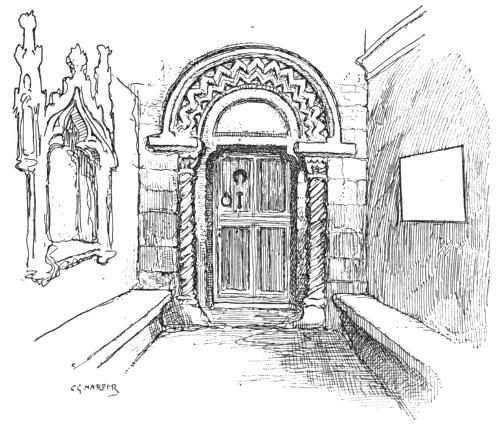
NORMAN PORCH, KEMPSFORD.

KEMPSFORD CHURCH.
Kempsford church-tower is prominent across the meadows, and we find it to be a notable and interesting church, and the village a place of aristocratic appearance, where humble cottages are few and the manor-house imposing. This is as it should be in a place with its history: the manor having once belonged to Edward the Confessor, who gave it to Harold. William the Conqueror conferred it upon one of his[63] knights, and in the course of the centuries the property came to Henry, Duke of Lancaster, whose son-in-law, John o’ Gaunt, Shakespeare’s “time-honoured Lancaster,” once resided here, greatly favouring this one of his many manors, of which the number scattered all over England was so great that it would have been distressingly hard work for him to visit them each and all in the course of a year.
The only son of Henry, first Duke of Lancaster, was drowned here, and his sorrowing father is said never again to have resided at Kempsford. On the north door of the church is nailed a horseshoe, in allusion, it is said, to one cast by his horse on his departure, and immediately nailed up here by the inhabitants. It is, indeed, often said to be the original shoe, but that is an absurdity. A curious other horseshoe legend and observance is to be noted at the town of Lancaster, John o’ Gaunt’s ancient palatine seat. There, where the two principal thoroughfares of the town cross, is “Horseshoe Corner,” so named from the horseshoe let into the roadway, and renewed in every seven years; in memory, says tradition, of a shoe cast there by his horse.
Kempsford church consists of a long and lofty aisleless nave, with tall central tower. The nave is Norman, with Norman doorways and Perpendicular windows, and very beautiful, gorgeous, and impressive.
The ancient manor-house, frequently styled “the Palace,” came at last into the possession of the Hanger family, Earls of Coleraine, one of whom wantonly destroyed it.
The Thames and the Thames and Severn Canal, running almost side by side at Kempsford, now abruptly part company again, and meet only three-and-a-half miles farther on, at Inglesham. The canal is the more easily followed, since the windings of the Thames in those miles add certainly another mile and a half to the distance, and are to be followed only with extreme difficulty by canoe, or afoot through many fields. Hannington Bridge, crossing it nearly a mile and a half below Kempsford, is the first bridge of any importance, and is a solid, stolid modern masonry building, eminently practical and unimaginative, serving to carry the road from Highworth to Fairford across. The remains of an old weir on the way give pause to the exploring canoeist at most seasons; and a small tributary, the river Cole, hailing from Berkshire, is seen on approaching Inglesham.
There are no churches in these surroundings more interesting than the humble little building at Inglesham, one mile from Lechlade, in an almost solitary situation. It is quite a rustic church, chiefly in that best period of gothic architecture, Early English, and it is so far removed from restoration, or even adequate care, that it is almost falling to pieces. Damp and neglect have wrought much havoc here, and the zealous concern of the Society for the Preservation of Ancient Buildings, by preventing any large scheme of repair, seems not unlikely to result, at no distant date, in the entire dissolution of the structure.
The meeting of the canal and river at Inglesham Hound House is marked picturesquely by the grey round tower of the Hound House itself, and by a row[65] of tall poplars. The Round House is nothing but a glorified lock-keeper’s house, situated beside this, the first lock, where the canal sets forth on its way toward Stroud and the Severn. A mile farther downstream lies the town of Lechlade, across the lovely level meadows, with the tall spire of its church glinting whitely in the sun. It is an exquisite view, and so alluring that you are in haste to make acquaintance with Lechlade itself, that promises so romantically. But let us not hurry. Rather that distant view than Lechlade at close quarters; for although it is in very truth an inoffensive town, it is also sufficiently true to remark that it is dulness incarnate, and that this mile-long glimpse will be found the better part.
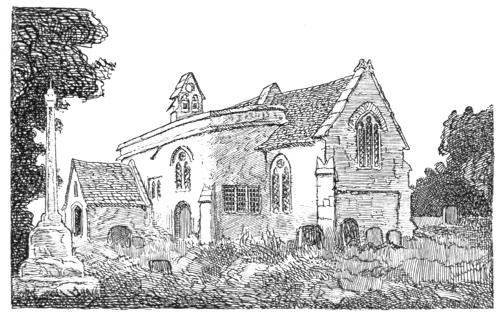
INGLESHAM CHURCH.
At Inglesham Round House there are plentiful facilities wherewith to refresh the body and to employ[66] the uncultivated mind; for the lock-keeper’s domain includes a number of apologetic sheds and shanties devised for the benefit of picnic-parties; and anything eatable or drinkable likely to be called for by parties on picnic, or boating, or merely padding the hoof, is obtainable, together with the mechanical music of melodeons or other such appliances that will serve you with pennyworths of minstrelsy, as more or less appropriate sauce. Here also is a greatly-patronised camping-ground, generally plentifully occupied with tents in favourable summers. The river Coln here also flows into the Thames from Fairford.
It is a pretty spot, with its hunchbacked lock-bridge, and the not unhandsome modern foot-and tow-bridge that spans the Thames, helping to compose a picture. It is the Ultima Thule of the Oxford man’s “Upper River”; the farthest point to which it is generally navigable for small boats.
Passing Inglesham Round House, and proceeding over the foot-bridge to the right bank of the Thames, toward Lechlade, we enter Berkshire; crossing over the stone single-span Lechlade bridge into the town and into Gloucestershire.
The town of Lechlade takes its name from the little river Leach which rises at Northleach, fourteen miles in a north-westerly direction, and gives its name to Northleach, East Leach Turville, and East Leach Martin. Although Lechlade—i.e. “Leach-let,” the outlet of the Leach—thus obtains its name, that little river flows into the Thames at a considerable distance away, two and a half miles below the town, at Kelmscott.

INGLESHAM ROUND HOUSE.
The disastrous persons who derived “Cricklade” from “Greeklade,” and invented a university of Greek professors there, made “Lechlade” a rival seat of learning, where Latin was taught, and gave its original name as “Latinlade.” Fuller tells us how this imaginary university—in which he seems to have believed—ended by migrating to Oxford. He is quite poetic about it. “The muses,” he says, “swam down the shores of the river Isis, to be twenty miles nearer to the rising sun.”
Other, and equally weariful, persons made Lechlade, “Leeches-lake,” the home of the College of Physicians (“leeches”) relegated to this obscure town—which, of course, it never was.
It is now hardly conceivable that once upon a time there was a considerable traffic in cheese upon the upper Thames, between Cricklade, Lechlade, Oxford, and London; but such was the case. This was formerly a great cheese-producing district, as it might well be now; and, as roads were bad everywhere and railways were not yet, the only method was to load the cheeses on barges, and so float down-stream.
Lechlade is very well on week-days, in the quiet way of all such decayed townlets, but on Sundays it is not to be recommended. Dulness stalks its streets almost visibly, and the only sounds are the argumentative tones of the preacher in the Wesleyan chapel (a building with black doors and gilded mouldings, after the fashion of a jeweller’s shop) at one end of the street, whose raucous voice can be distinctly heard at the other: not unlike that of a man quarrelling outside a public-house.
But the fates preserve us from a Sunday at Lechlade! It is fully sufficient to skim through the place at such a time, and make for some other that does not so completely figure the empty life. A village is not dull, because it has no pretensions to being a town—and country life is never dull. But at Lechlade the position is so desperate on Sunday that, for sheer emptiness of other incident, a large proportion of the population flock the half-mile that stretches between the town and the railway-station, and hang, deeply interested, upon the bridge, to witness the Sunday evening train depart. It is a curious spectacle, and one that carries the mind of a reminiscent reader back to stories of marooned castaways on desert isles, gazing hopelessly upon the departing ship that has left them to solitude and despair. That must needs be a place of an extreme Sabbath emptiness where the grown-up inhabitants are impelled, by way of enlivening the weary evening, to walk half a mile to witness what seems an incident so commonplace to the inhabitants of places whose pulses beat more robustly.

A STREET IN FAIRFORD.
The “pratie pyramis of stone,” as Leland styles the spire of Lechlade church, is almost the only architectural feature of the townlet, if we except a few mildly-pretty stone-built houses of Tudor gables and mullioned windows; among which may be included the “Swan” inn. None of these are included in the accompanying view of the church, which, although graceful without, and promising interest within, has been miserably treated, and swept clear of anything of note. A few curious carvings are to be noted on[73] the lower stage of the tower exterior, including a singular bearded and capped profile head and a hand grasping a scimitar. Although well done, they look like the idle sport of some irresponsible person or persons, and do not appear to have any particular meaning or local application.
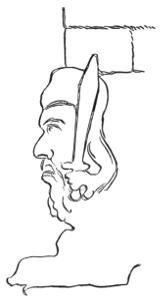
ANCIENT CARVING, LECHLADE CHURCH.
The architecture of the building is of no great interest to archæologists, being of somewhat late Perpendicular date, but a charming example of tabernacle-work may be noted on one of the piers of the nave-arcade, adjacent to the font. On the gable of the nave, at the east end, is a figure of St. Lawrence, to whom the church is dedicated. He holds a gridiron, the symbol of his martyrdom, in one hand, and the book in the other.
Fairford is the centre of attraction in this district. It lies away north-west, four miles distant, at the end of the little railway from Lechlade, on the river Coln. The Gloucestershire Coln has its name spelled without a final “e” (for what reason no man knoweth), and gives a title of distinction to a group of villages—Coln St. Denis, Coln Rogers, and Coln St. Aldwin’s—that are famed for their beauty. But Fairford has superior[74] claims to notice, chiefly for the celebrated stained-glass windows of its church.
“Fair-ford” may or may not derive its name from its picturesque situation, but the beauty of the ancient ford of the Coln, now and for long past crossed by a bridge, might well warrant an assumption that the name arose from an æsthetic appreciation of the scenery. Exactly what it is like to-day may be seen by the view shown here, with its noble church placed finely above the meadows.
Fairford is a village that was once a town, prosperous in the far-off days when the wool-growers and the cloth-workers of the Cotswolds made fortunes in their trades and founded families that came in time to a dignified haven in the peerage; and at last declined and died out, or have rejuvenated themselves with American marriages and the dollars incidental thereto. This old process of founding families by way of successful trading we may still see at work, in our own times, under our own intimate observation, encouraged by the institutions of primogeniture and a House of Lords, two most powerful incentives to success.

LECHLADE.
Fairford nowadays stands aside from all these activities. Its day is done, and except on those occasions when the motor-omnibus between Lechlade and Cirencester plods through, and on the weekly market-day, there is no stir in the place at all. Its fine church and the famous windows alone bring strangers here. The church is due to the munificence of the Tame family. John Tame, merchant, of London, purchased the manor in 1498, and died twenty-seven years later. He must have been a[77] typical “new man,” with plenty yet to spare of the abounding energy that had made his wealth in London, for it was he who began, and nearly completed, the rebuilding of Fairford church. We may well picture him, in our imagination, hopeful of founding a family, as many other successful traders of that expansive age had already done, or were doing. His immediate descendants, however, failed him, and the name is extinct. It was his son, John, who completed the church, and died in 1534. Monumental brasses to the memory of these Tames, and of the third and last, Sir Edmund Tame, are seen here, but their greatest monument is the church itself, a beautiful example of the last developments of Perpendicular architecture, in which the coarsened mouldings, here and there noticeable, the curiously-set pinnacles of the tower, and the character of the grotesques carved on the exterior, alone hint of that new leaven in matters architectural and spiritual, the Renascence, that was presently to overthrow ancient architecture and much else.
But the wonderful windows, twenty-eight in all, the finest and largest set of old stained-glass windows in England, are our chief concern at Fairford.
The question as to the foreign or English workmanship of these windows has always been in dispute; unnecessarily, it would appear to the present writer. They are, for the most of them, obviously of Flemish origin; and a late discovery would seem to have at last settled the point. In the west window of the south aisle will be observed an executioner with a sword, on which is a monogram A. An ape also[78] appears in the window, for no very obvious reason, except that it affords material for a pun; a form of humour greatly favoured by the old craftsmen, as all conversant with ancient churches well know. The monogram and the ape point to the glass being the work of Aeps, a Flemish worker in this sort at the period of the Fairford church-building.
The large figures of the prophets and apostles which fill the windows of the aisles are so unmistakably Flemish that there should never have been the least doubt about them. If there were any room for incertitude, it would be in respect of the great west window, the most remarkable of the series, which appears to disclose no foreign element; but, as it in all other respects obviously belongs to the general scheme, it may perhaps be called Flemish, in common with the others.

FAIRFORD, FROM THE RIVER COLN.
A legend long current, accounting for these windows, says that John Tame, asked to pilot a vessel containing them from Nuremberg to Rome, turned his course to England instead, and in fact stole the windows. Now, however fantastic this story, it probably contains this much of truth, that it hands down a foreign origin; but that this glass was acquired in any chance way is altogether unlikely, for it bears every sign of having been designed for this church, and for the exact position and size of the windows it occupies. The designs have been ascribed by some to Albrecht Dürer, and an old manuscript goes so far as to relate a visit paid by Vandyck to Fairford, when he said the drawing was Dürer’s work. This, however, would seem to be impossible, as Dürer was but[81] twenty-three years of age when Fairford church was in course of building.
The great west window affords the chief interest, illustrating as it does the Last Judgment. The upper half, above the dividing transom, displays the company of the blest, assembled round the central figure of Christ in majesty, with St. John Baptist on His right hand, and the Virgin on the left. Three half-circles, somewhat resembling rainbows, surround these figures; the first a deep red band, filled with representations of the seraphim; the second, yellow, with figures of the apostles; the third, blue, filled with the cherubim. Angels fill the outer spaces, quiring before the Throne. These be the glorious surroundings of the good, the constant, and the true.
The Doom, occupying the lower portion of the window, is a striking example of imagination applied to the subject of retribution for sin. The Devil and his infernal host and the flames of Hell were evidently very real to those who pictured these scenes of torment, and to those who first looked upon them, and they could certainly never have thought it possible a time would come when people would either laugh at these ideas of a real personal Devil with attendant fiends, or look upon them as curiosities; certainly without any fear or awe.

Here, in all the grotesque drawing and vivid colouring of which that age was capable, we see the rewards of wickedness. St. Michael the Archangel, in the centre, is shown, holding the scales of justice, wherein the souls of the dead are being weighed. On the left[82] of him is St. Peter, with his key, standing at the gates of Paradise; while on the right are seen the dead rising from their graves, and the flames of Hell, a little subdued by the weathering of the centuries, awaiting them. In the lower right-hand corner is a representation of the Devil himself, with a head like a cottage loaf, in the very opening of his own especial region, holding the red-hot bars, and grinning out between them. Curious auxiliary devils are shown, actively engaged in carrying the dead to torment; among them the remarkable group illustrated here. The tall scaly devil on the right, carrying one of the damned on his back, is a blue fiend; the other, displayed in the act of lashing a woman just rising from her grave, is a strawberry-coloured devil, covered with pips, and glaring with eyes of flame.
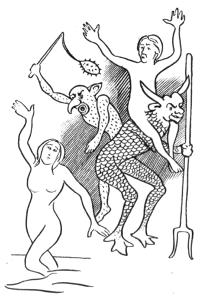
Other fiends in green, in red, and in yellow, are pursuing shrieking souls, or, having caught them, are seen flinging them into pits of fire. Some of these places of torment are shown neatly enclosed in masonry, like blast-furnaces. Another fiend, illustrated here, regarding a woman clasping her knees, seems to be rather of an apologetic, gentlemanly type. It is his business to be a tormentor, but he looks genuinely sorry for it.
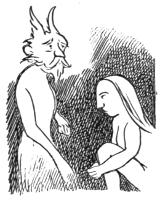

THE GREAT WEST WINDOW, FAIRFORD, DISPLAYING THE “DOOM.”
The other windows are of distinctly inferior interest, displaying as they do mostly saints, but some of the smaller lights repay close attention. In them you see the persecutors of the Church, set forth with every horrific detail of innate malignity; while, hovering over a representation of the Crucifixion is seen a batlike devil, awaiting the last breath of the impenitent thief, to secure his escaping soul.
These remarkable windows owe their preservation to the care taken of them by William Oldisworth of Fairford, during the Puritan upheaval, probably with the aid of Lady Verney, wife of Sir Thomas Verney, lord of the manor. She was daughter and heiress of Sir Edmund, the last of the Tames, and interested, of course, in seeing that the gifts of her ancestors were in safe keeping. The glass was, accordingly, carefully removed and buried in Fairford Park. There it remained until the restoration of order, when it was exhumed and replaced. A tall classic column stands as a monument to this singular history.
It is not always so easy a matter as you might suppose to hire a boat at Lechlade for the thirty-two miles’ voyage to Oxford; which, after all, is not only the best way of seeing the Thames, but the Thames Valley villages also. Unless considerable notice is[86] given, especially if it be the week before Bank Holiday, the boat-proprietor is extremely chary of letting his craft out of sight, and it becomes a matter of favour and delicate negotiation to secure a boat, even though you tender good value in coin of the realm for its hire. The proprietor’s point of view is that it is all very well for pleasuring folk to drop easily down to Oxford with the stream in two days, but it remains for him, or one of his men, to get it back against stream; not so easy a matter, even though the stream be gentle. In fact, the demand for boats for the trip is not sufficiently large for special arrangements for cartage back by road to be made; and that familiar summer sight anywhere between Richmond and Oxford, a slowly-progressing van, laden with boats, rolling along the intervening miles of highway, is not visible here. But, although the hiring is, as already said, somewhat difficult, the explorer has at least the satisfaction of finding the Upper River secluded and unspoiled.
Immediately below Lechlade begins that long and ever-increasing series of locks by which the Thames Conservancy has converted the river into an astounding succession of toll-gates; with this result, that you are not long out of sight of one lock before another comes in view; while lock-cuts in addition grow longer, as well as more numerous, and tend to make the river in many places very formal. But, at any rate, the true river-course, leading to the weirs, or often round by what are now backwaters, is by contrast, and by disuse, rendered often a very paradise of wild, untended life.
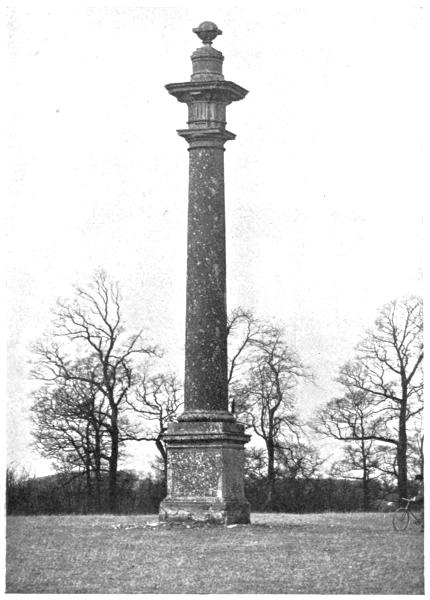
MONUMENT IN THE PARK, FAIRFORD, WHERE THE FAMOUS WINDOWS WERE BURIED.
The first lock of the forty-two locks on the Thames is that of St. John’s, which, like Lechlade Bridge, often styled “St. John’s Bridge,” takes its name from the Priory of St. John the Baptist that once stood hard by. The Priory was a Hospice as well, and was charged with the care of travellers who came this way. As part of their charge the Black Canons who formed the establishment built the original bridge across the Thames here.
St. John’s Bridge, like some carefully-restored old dowager, by no means looks its age, but all those who care to know are credibly informed that “This bridge, though often repaired and altered on the upper part, is the original structure of great antiquity, having existed prior to the reign of Henry III.” The “Trout” inn, formerly the “St. John Baptist’s Head,” stands beside a backwater, on the site of the Priory that was disestablished so long ago as 1473.
At St. John’s Lock the lock-keeper not only hands you the first of the many threepenny pink tickets that are painfully familiar to those who cruise upon the Thames, but another in addition, for Buscot Lock, one-mile-and-a-quarter onward, where the poor, impoverished (or, perhaps more likely, the mean, parsimonious) Conservancy cannot, or at least does not, maintain a resident lock-keeper; with the result that you have the choice of working your own way through, or of leaving the job to the official hands of the keeper at St. John’s, who in the latter event cycles the distance. But in any case you pay your threepence for each lock.
The Thames from this point becomes singularly[90] lonely. Few roads cross it, and the villages are small and infrequent, and are rarely to be seen from a boat. The ideal method of exploration is to take a bicycle on the boat and to lay it across the bows, where it is out of the way and yet easily within reach when wanted. Then, at some convenient point, where a road or path comes down to the river, and places likely to be of interest are but a mile, or two or three miles, distant, it is your easiest method to have out the machine and explore swiftly and with ease, among little-visited ways.
Buscot, however, on the Berkshire shore, is so close at hand that its church may easily be seen from the boat and visited by the mere effort of pulling to the bank under the hoary willows, and stepping into the meadow beside whose buttercup-spangled grass it stands.
Buscot—formerly Burwardscott, then corrupted into Burscott, and finally into the present rendering—is a place of some note, artistically and agriculturally, for the little parish church has an east window by Burne-Jones, representing the Good Shepherd, instead of the usual ecclesiastical-furnishers’ impossible stained-glass saints. We may perhaps, without offence, congratulate ourselves and all concerned that those stained-glass freaks are, and must ever have been, impossibilities. They have the most unprepossessing countenances, of an impossibly holy type, and generally the vilest taste in coloured robes; while of the Burne-Jones saints we can at least say that, although commonly eight feet high in proportion to their heads, and generally of a consumptive type,[91] they are at least recognisably like human beings. And a saint, you know, was originally, before he or she was given his or her halo and other extraordinary attachments, merely a more than usually good person of just ordinary physical attributes. I don’t think anyone will have the hardihood to deny that. One other prime curiosity the church of Buscot possesses: a very highly enriched pulpit of wood, with panels painted in various religious subjects, by or after artists of the Italian School. A panel representing the Annunciation is more remarkable than ever was intended, for among the attendant Wise Men from the East is shown a negro with black head and arms and white legs! “Can the Ethiopian change his skin?” Partially, it should seem.
Buscot manor-house is as notable for containing the Burne-Jones “Briar Rose” sequence of paintings illustrating the ancient legend of the Sleeping Beauty, as the owner is for his successful shire-horse breeding. It is not often that the love of art and keen interest in shire horses are shared equally by one man, as they are by Sir Alexander Henderson, of Buscot, who is at once the owner of the finest Burne-Jones pictures and the breeder of “Buscot Harold,” champion of three successive London Shire Horse Shows.
It is interesting to know that Buscot manor-house, standing in its park on the ridge above the river, on the way to Faringdon, was built from the stones of the demolished palace at Kempsford, even though we may see only an eighteenth-century solidity and comfort, rather than any hint of beauty or history in the re-edified stones.
Hart’s Weir, or Eaton Weir, as the Conservancy elects rather to style it, is but a mile-and-a-quarter below Buscot, and is one of the few old-fashioned weirs, fitted with paddles and rymers, of which a few are removed for the passage of a boat, that now remain. Beside it stands the “Anchor” inn, with not another house in sight, and the little church of Eaton Hastings—it would be an affectation to speak of the village, unless a few scattered cottages may so be named—two miles away, by the riverside, but so hidden that its existence is not suspected by passing oarsmen.
It is amusing to observe the blank puzzlement that overspreads the faces, and governs the actions, of those occupants of boats from Lechlade who, coming for the first time to this unfamiliar type of weir and lock combined, helplessly steer from one side of the river to the other, in search of the familiar lock-cut and lock-gates, and, failing to find them (as well they may, for such things do not exist here), at last landing and enquiring for them at the inn. Eaton Weir is one of the last now left of the old weirs that served the turn of the river in days of old, and they are therefore now so uncommon that none need feel ashamed of coming unexpectedly for the first time to one, and not comprehending the situation. But those who are taken by surprise here and cannot understand why they can find no way through, do, it is evident by leisured observation, feel a kind of shame at being so completely “sold.” Eaton Weir, and others of its kind, are, in fact, complete barriers across the river, affording a check to all craft until[93] four or five of the paddles are pulled up. The construction is simple, consisting of a sill, generally a heavy beam of wood, laid across the bed of the river, with a similar beam crossing immediately over it, from bank to bank. These form the framework of the weir, which is completed by a number of stout supports going perpendicularly down at intervals from upper beam to lower, and by a continuous row of “paddles” set between them. The “paddles” are, roughly speaking, in the shape of shovels, but much longer in the handle and bigger in the blade. It is obvious that when all the paddles are down in their places the head of water must be considerably raised above the weir, although a volume of water pours through all the while. To admit the passage of a boat, the weir-keeper draws up four paddles or more, and then, if the craft be going down-stream, it is guided by the steersman carefully to the weir, and deftly allowed to be shot through by the force of the waterfall thus created in the opening. A little mild excitement generally accompanies this “shooting the rapids,” even though the fall be only about eighteen inches to two feet when the paddles are first drawn, and reduced to almost nothing if you wait a few minutes while the head of accumulated water runs itself away. The Thames Conservancy will have its dues, and whether it be a lock or a weir you pass, you render threepence for a small boat, and receive a pink ticket in return.
And so one comes to Kelmscott, which owes its name to some Saxon thane, just as Buscot derives from some dim ancient Burward. But of that[94] Kenelm whose “cot” this was, history says no more than it does of Burward. If we adventure into the hinterland at the back of Bampton—whose full name is Bampton-in-the-Bush—we shall find two other “cots,” or “cotts,” Alvescott, and Kencot—and there is Cote (which is merely “cot” spelled in another way, and unappropriated to any personal name) further down-stream behind Shifford.
At Kelmscott the river Leach comes really to its “lade,” or outflow; its “let,” or outlet: a similar word being used at Oaklade (“uisk-lade,” or water outlet), where the Swillbrook joins the Thames, and at Cricklade, where the Churn falls in. In the words of the presiding genius of the place, the late William Morris, Socialist, poet, decorative-artist, demagogue, literary man, and master-printer, this is “a reach of the river where on the side of the towing-path is a highish bank with a thick whispering bed of reeds before it, and on the other side a higher bank, clothed with willows that dip into the stream, and crowned by ancient elm-trees.” Very true. It is also a beautiful and sequestered spot; and although now, since the death of William Morris in 1896, become a much-talked-of new literary shrine, few are those who trouble its ancient peace.
The village lies near the banks of the Thames, with a rough, unkempt piece of common opposite the old Elizabethan, stone, gabled manor-house that was for some years the home of Morris and of Dante Gabriel Rossetti. Nothing but the upper windows of the old house can be glimpsed from the road, for a very high wall effectually guards its seclusion.
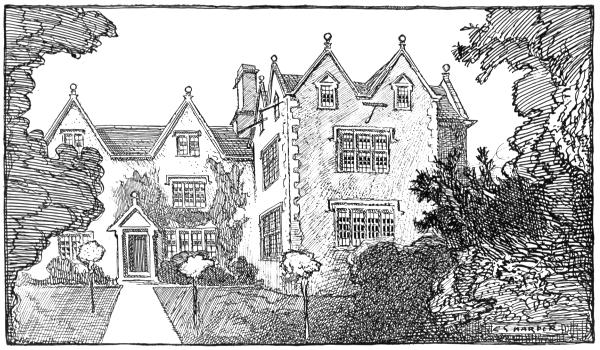
KELMSCOTT MANOR.
Morris loved the place with an intense love, and brought back to the house much of its old ways, with much else of his own, in artistic “Morris tapestries” and other hangings, such as were designed by him and Burne-Jones, made at Merton by Wimbledon, and sold at the establishment of Morris & Co. in Oxford Street. We do not commonly look upon Socialists as anything but discontented artisans and weekly wage-earners in general; but Morris performed his share of street-corner spouting with such, and yet dreamed golden dreams of the World Beautiful, and did much to make it so. But, at the same time, his lovely wares in wall-papers, in hangings and carpets, in furniture and stained-glass, were of the most expensive kind that none of those “have nots” could by any means possess. The famous Morris books, too, produced at the Kelmscott Press, Hammersmith, were of those prices that only plutocrats could afford, and were produced strictly after the individualistic and anti-Socialistic theory of “limited edition.”
The only new house in Kelmscott village is one built to preserve the memory of this man who wrought such beautiful things and preached doctrines so impossible; and on the front of it is a very ornate tablet, bearing a portrait-medallion. The work is, however, in such low relief and so elaborated that it is difficult to be clearly distinguished.
Away through the scattered village, and out at the other end, stands the little decayed parish church of St. George: decrepit and surrounded in most melancholy fashion by spindly overhanging lime-trees.[98] The place oppresses the stranger, even on summer days, with gloom, which is increased as he walks up the dank little pathway to the south porch, among the serried graves of a numerous local family, each one within his concrete bed. The quite plain headstone to William Morris is close by.
There is no feeling of this melancholy in the account written by Morris, in his News from Nowhere, of a village church; but which was evidently a description of this:
“We went into the church, which was a simple little building with one aisle divided from the nave by three round arches, a chancel, and a rather roomy transept for so small a building, the windows mostly of the graceful Oxfordshire fourteenth-century type. There was no modern architectural decoration on it; it looked indeed as if none had been attempted since the Puritans whitewashed the mediaeval saints and histories on the wall.”
The building is chiefly of Early English date, consisting of nave, chancel, rudimentary north aisle of a makeshift character, and north and south transepts and clerestory. There is a rough tub-font. Some traces of ancient colouring are found on the round-headed arches of the nave-arcade; while the accompanying illustration will show that the sculptured capitals of the columns are of great, if simple beauty, and doubtless studied in the long ago from the water-plants of the Thames.
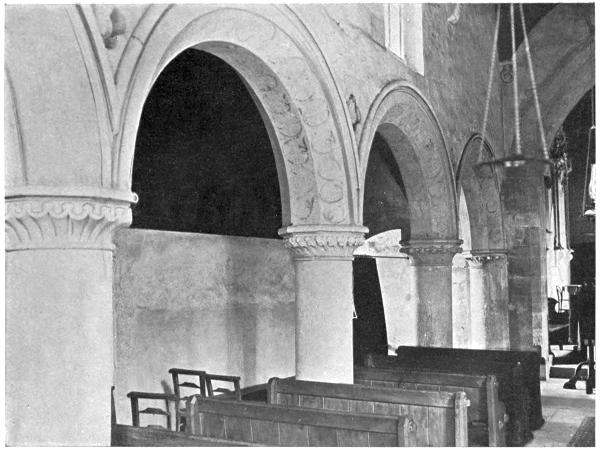
KELMSCOTT CHURCH.
Nothing can equal the calm delights of those still, hushed hot days of early summer on these reaches of the upper Thames, when the tall sweet grasses of the[101] meadows by which we float are ripening to the scythes of the reapers, and before the birds have quite finished their wild torrent of springtime mating song. Here, with the boat drawn up beside some tall sheaf of growing rushes, we may listen to the twittering distant song of the skylark, flying, an almost invisible speck, high up in the intensely blue sky; and may see the water-rat swimming across the stream. Cows gaze with a mild curiosity from the banks, under the welcome shade of the willows, or recline, with a certain lumpish dignity, among the buttercups and daisies. The fragrance of spring is yet in the land, and that man who, lazing here, lights a cigarette, and so imports an alien fragrance, offends against his environment.
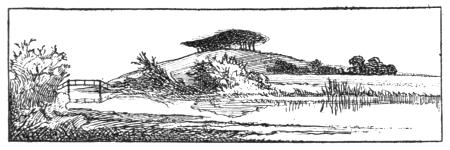
FARINGDON CLUMP.
So we shall come, after many intervals and halts by reedy shores where the waterlilies grow, to Radcot Bridge; the meads spreading wide on either hand, and the great imposing landmark of Faringdon Clump for always prominent in the view on the right: now, with the continued extravagant loopings of the river, far ahead, now abreast of us, and again in the rear; so that it becomes difficult to believe this elusive landmark really one and the same hill.
Beneath Faringdon Clump lies the little town of Great Faringdon, great only in its quietude, somewhat broken, it is true, in these latter days by motor-cars, that, rushing along the ridgeway road on which it is situated, indecently disturb its slumbrous dignity.
Faringdon Clump is emphatically the landmark of this district, even as Wittenham Clumps are the geographical pointers of a wide district between Oxford and Wallingford. Many people know it as “Faringdon Folly.” The height of Faringdon Hill itself, on which the clump of Scotch firs called “the Folly” is situated, is about 500 feet, and Faringdon town, although beneath it, is not itself by any means in the levels, as those who, cycling to it from the Thames at Radcot Bridge, shall easily find, as they come laboriously up the ascending gradients.
But, before we reach Radcot Bridge, the newly-built Grafton Lock has to be passed through. It is situated in a grassy solitude, and takes its name from an insignificant hamlet quite remote from the river. At Grafton Lock, indeed, the lock-keeper’s wife and daughter, who between them take our threepence and work the lock-gates, are pleased to see the infrequent stranger, and to exchange the news, and receive well-earned compliments on the beauty of the lock-garden.
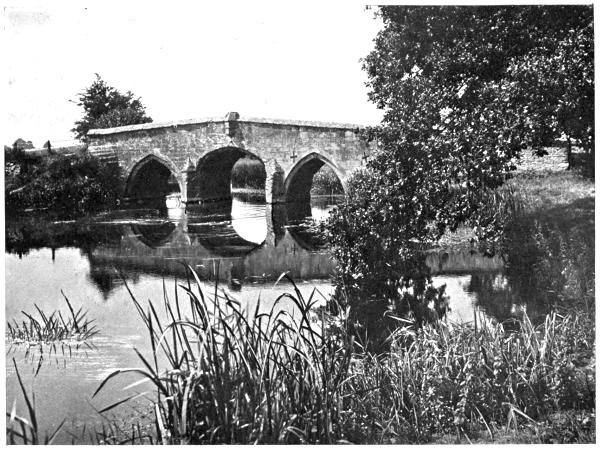
RADCOT BRIDGE.
Now comes Radcot Bridge, neighboured and overhung by a wealth of trees; tall, slim, spiring poplars, and others that spread boldly out. Radcot Bridge is your only possible halting-place hereabouts for[105] the night; for here is the waterside “Swan” inn, with its lawn sloping down to the river, its landing-steps and boathouse: and Faringdon and its inns are three miles distant. Thither, however, you must needs fare, if so be the “Swan” is full.
The single-span, round-arched bridge through which one comes in these times is not the real original bridge, nor is the present course of the Thames at this point the real original river. This is a new cut, made in 1787, to improve the navigation, then still considered to be of considerable commercial importance. The old course of the river flows sluggishly to the right-hand, and is not now practicable for boats. Here still stands the ancient gothic bridge, with its three pointed arches and the base and socket of what was once a cross on the eastern parapet. This bridge and the causeway built to it, across the meadows, once formed a more important means of communication than now, for the road across the Thames from Faringdon led northwards to Burford, and so by degrees into the Midlands. Its strategic value has been at least twice illustrated. The bridge itself dates from about 1300, and was on December 20th, 1387, the scene of a sharp action in which Henry, Earl of Derby, met and defeated Robert de Vere, the Earl of Oxford, favourite of Richard the Second. Many of de Vere’s men were drowned here on that December day, and their commander himself narrowly escaped, by swimming across the river, half clad in his armour. His force seems to have been taken completely by surprise. The “Henry, Earl of Derby” of this affair was he who twelve years later, 1399,[106] at last succeeded in deposing Richard, and reigning in his stead, as Henry the Fourth.
The second occasion of Radcot’s figuring in martial annals was a skirmish in the long course of the Great Rebellion, when Faringdon House, up yonder, three miles away in the town, was held for the King, and the bridge was occupied as an outpost. Cromwell’s men appear to have driven the outpost in, with some loss.
But, before an end is made with Radcot Bridge, let us note the little-known fact that it was hence, in those seventeenth-century times, when roads were little better than muddy tracks across the fields are now, that much of the stone employed by Wren in the rebuilding of St. Paul’s Cathedral was brought to London. The old quarries whence this stone came have been closed now for two hundred years, but the site of them is still to be found at a spot to this day known as “Kit’s Quarries,” near Burford, eight miles north of Radcot Bridge. I have written about Christopher Kempster—the “Kit” of those quarries—in another place,[1] and have shown that he was firstly clerk of works and master-mason in the employment of Sir Christopher Wren for many years, not only in the rebuilding of St. Paul’s Cathedral, but also in the general rebuilding of the City of London churches. Retiring from those positions, he bought the quarries, and thenceforward dealt largely in the stone with which he had once built.
The stone was conveyed from near Burford, along[107] eight miles of bad roads, and here at Radcot Bridge, on the old course of the river, before the new channel was cut, was loaded, into barges, and so found its way to London.
It will be well to explore into the level Oxfordshire hinterland behind Radcot Bridge. There we shall, in the course of two miles, find the untidy village of Clanfield, which straggles lengthily on either side of the grassy edges of a stream three parts dry in summer, and thus revealing to the disgusted wayfarer rich and varied deposits of unconsidered village refuse—in the way of battered tins and old boots embedded in the ooze. Thistles, nettles, and scrubby weeds bedevil the grass that might so easily be made beautiful.
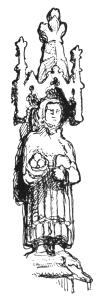
ST. STEPHEN.
But there are evidences that Clanfield is awakening to better things. A “Village Institute” has arisen amid these rank undesirables, and tentative clippings, sweepings, and garnishings may be noticed. The church and churchyard are, fittingly enough, in the forefront of these improvements.
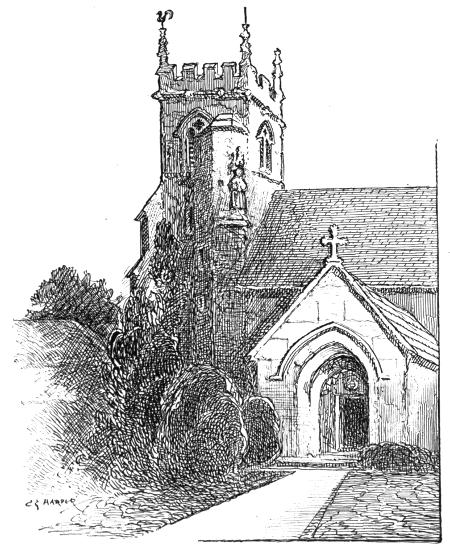
CLANFIELD CHURCH.
It is a charming village church of moderate size, built in the Perpendicular period, and dedicated to St. Stephen, as those well versed in saintly symbols may readily perceive on approaching, by a glance at the curious figure of the saint himself, boldly sculptured on the tower. He bears in his right hand[108] a little heap of what look like apples, but are intended to represent stones, in allusion to the manner of his martyrdom, by being stoned to death. On the west side of the tower is a tablet to the memory of James[109] Joy and Robert Cross, killed by lightning when at work side by side in the fields, August 9th, 1845. Over the south door is an ancient sundial, cut into the masonry, and screened from casual observation by the porch, which is thus seen to be a later addition.
[1] The Oxford, Gloucester, and Milford Haven Road, vol. i., pp. 263, 266-269.
GREAT FARINGDON—BUCKLAND—BAMPTON-IN-THE-BUSH—COTE—SHIFFORD
Great Faringdon, on the right, or Berkshire, side of the river, is well worth visiting. Technically a town, its inhabitants would probably feel injured by any one styling it a village; but there are towns and towns; and Faringdon, although it perhaps may not be styled “decayed,” is at any rate unprogressive. There be those among us who are so constituted that they mislike the word “progress,” and are repelled by any place they hear to be “progressive.” This is entirely due to the recent connotation of “progress.” Modern men have seen so much of the futile striving and competition, the shameless advertising, and the sordid things that stand for “progress” in these days, that they look with yearning upon those spots that are said to be “unprogressive,” and ardently wish their lives might be lived therein, instead of being merely existed where the struggle for survival is waged with ever-increasing severity.
Great Faringdon—how humorously that epithet sounds to a Londoner!—is unprogressive in the best of these senses. You do not find, on approaching it, the ragged slummy selvedges that fringe the towns where commerce thrives so abundantly, where the[111] rich grow daily richer, and the poor daily more abjectly and helplessly impoverished. No matter from what direction you approach Faringdon, along none of the five entrances to the town do you see mean suburbs spreading grimly into the shamed fields, nor plentiful notice-boards declaring “This eligible land” to be “ripe for building.” Faringdon’s expansive days are done, and no man can see the likelihood of their return, for, although the town is situated on such a network of highways that travellers by road can scarce get about the neighbourhood without going through it, the great days of the road are passed, and the motor-car is not going to bring them back in that old sense. The last blow was delivered at the chances of Faringdon’s expansion when the main line of the Great Western Railway was carried four miles to the south, past Uffington, whence a small branch line comes, to serve the town, and stops here.
Faringdon is an historic place, but its history ceased to be a living thing at so remote a period that it seems, to many who do not trouble to come to close quarters with it, to be a very dryasdust history indeed. It is largely the history of the Saxon kings, to many of whom Faringdon was a favourite place of residence. But of all these times, and of later royal visits, no tangible record is left; and the Faringdon of to-day is just an ancient market-town that contrives to live quietly on the needs of the surrounding agricultural population. In a rapidly-changing England, this town is one of a few that, made to stand aside from the ways of modern trade, remain very much what they have been during the last two centuries. The[112] last incidents that ever stirred the pulses here were election contests, and the last issues in the larger sort that disturbed town and district were fought out so long ago as the middle of the seventeenth century, in the attack and defence of Faringdon in the Great Rebellion. Then the Royalists held the town and Faringdon House, the seat of the Pye family, behind the church. The Pyes had been in possession of the property only some twenty-three years when the troubles broke out, having purchased it in 1622. They were then on the popular side, Sir Robert Pye, indeed, having married the sister of John Hampden, the patriot, who lost his life at Chalgrove Field. Greatly to his mortification, the Royalists had seized and garrisoned his mansion, and it fell to his lot to besiege it. The elder of the two sons of this Sir Robert was that Hampden Pye, born in 1647, who is the subject of the Ingoldsby Legend of “Hamilton Tighe,” “a sobriquet interfering neither with rhyme nor rhythm,” as the author justly claims. The legend of Hampden Pye, which Barham thus versified, was one once current in Faringdon and Uffington, and the surrounding district; and told how he, the eldest son, heir to the family estates, contracted what his family regarded as an undesirable marriage, and how he was hounded on to join the naval expedition to Vigo, under the command of Sir George Rooke, in 1702. His own mother is said to have been chiefly instrumental in this, and to have been among those who secured his being placed prominently in the post of danger, so that he might be got rid of. One of the earliest shots in action carried off the head of Hampden Pye, who[113] was by no means the reckless youngster we might at first suppose, for a comparison of dates shows him to have been fifty-five years of age at the time.
It was believed in Faringdon that always afterwards, when his mother went out in her carriage, the spectre of her son stood at the door with his head under his arm, handed her in, and took his seat opposite. He grew even more troublesome after her death, but was at last “laid” for a hundred years in a small pond near the house by an eminent divine skilled in dealing with refractory ghosts. “The period,” continues Barham, writing in 1832, “lapsed a few years ago, and the people are now very shy of passing the said pond after dark.” And now the best part of another century has fled; but in the meanwhile the ghost of Hampden Pye appears to have been quiescent.
But the most famous of the Pyes was that Henry James Pye, born here in 1745, who was descended from Edmund, the younger brother of the unfortunate Hampden, and was not only a typical county gentleman, and sometime a member of Parliament, but became also, in 1790, Poet Laureate. The appointment was one of Pitt’s political jobs, and given as a reward for support in Parliament. Pye effected a change in the old-time payment of poets-laureate in kind by the annual gift of a tierce of Canary wine, and accepted an annual £27 instead.
He was, in addition, a police magistrate at Westminster; and was as excellent on the bench as he was execrable in verse. When the office of Poet Laureate comes under discussion, Pye in the[114] eighteenth century, and Alfred Austin in the present era, are inevitably bracketed together, for the purpose of showing to what depths of inanity a Poet Laureate can descend. But both these laurelled bards have been unjustly handled. To deliberately select the inferior versifier of the age and to make him Laureate is of itself a doubtful official service to a man; and then for critics to maliciously pick out his most feeble efforts by which to judge him and hold him up to contempt is cruel. It is something as though we were to appraise Tennyson by the Skipping Rope (which is worse than any of Pye’s futilities) and to leave Maud altogether out of account. Pye’s idea of poetry was at any rate a part of the habit of thought current at the time, and of the same order of flowery compliment as that of Thomson, who wrote The Seasons: although infinitely inferior in execution. Topographical description, interlarded with generous praise of his country-gentlemen neighbours, whose seats dotted the country he described: that was largely Pye’s idea of poetry; and not a vicious, if on the other hand not an inspired, view.
Pye was not a man favoured by fortune. When his father died, he found himself heir indeed to the family estates, but they were encumbered with debts to the amount of £50,000; and soon afterwards the house was burned down. He sold the estates about 1785, from sheer inability to make head against his financial embarrassments; and Faringdon knew the Pyes no more.
But Faringdon Clump, already mentioned, was planted by him before the family connection was thus[115] severed, and still flourishes; while his poetry lies dead and forgotten by the world at large. His other chief work was the pulling down of that Faringdon House which had been besieged by his ancestor, and replacing it by a new residence.
The large parish church, with curiously squat central tower, suffered greatly during those warlike operations of 1645-6. The spire, with which the tower was at that time surmounted, was destroyed, as also was the south transept; since rebuilt. Numerous monuments and brasses are to be found in this extensive Early English, Decorated, and Perpendicular building. Prominent among these monuments is the fine alabaster altar-tomb of Sir Henry Unton, 1596, in the Unton Chapel. It was placed here by his widow, Dame Dorothy Unton, whose own effigy, in a kneeling attitude, was at the feet of that of her husband, until tactless “restorers” effected a very injudicious separation, and not only took her away from her husband, but out of the Unton Chapel, and placed her in that of the Pyes.
Sir Henry Unton was both a warrior and a diplomat. He had earned his knighthood at the siege of Zutphen, where his kinsman, Sir Philip Sidney, met his death. Afterwards he became Ambassador to France. It was while in Paris that he sent to the young Duke of Guise, who had spoken slightingly of Queen Elizabeth, a bitter challenge to a duel:—
“Forasmuch as in the lodging of Lord Dumayne, and in public elsewhere, impudently and indiscreetly and overboldly, you spoke badly of that Sovereign whose sacred person I in this country represent: to[116] maintain both by word and weapon—her honour (which never was called in question among people of honour and virtue)—I say you have most wickedly lied; and you shall do nothing else than lie whensoever you shall dare to taxe her honour. Moreover, that her sacred person (being one of the most complete and virtuous Princesses that lives in the world) ought not to be evil spoken of by the tongue of such a perfidious Traytor to her Law and Country as you are; and hereupon I do defy and challenge your person to mine with such manner of arms as you shall like or choose, be it on horseback or on foot. Nor would I have you think that there is any inequality between us, I being issued of as great a race and noble house in all respects as yourself. So … I will maintain my words, and the lie which I have given, and which you should not endure if you have any courage at all in you. If you consent not to meet me hereupon, I will hold you, and cause you to be held, for the errantest coward and most slanderous slave that exists in France. I expect your answer.” The Duc de Guise did not accept this offensive challenge, although thrice repeated.
Built into the exterior east wall of the chancel is an unconventional monument. This is a cannon-ball, underneath which we read that it is “Sacred to the memory of John Buckley, formerly surgeon in His Majesty’s Navy, who in an engagement with the French squadron off the coast of Portugal, Aug. 17, 1759, had his leg shot off by the above ball.”
In the middle of Faringdon’s steeply-descending street, here suddenly growing very narrow, is the[117] old town-hall and market-house, supported on stone pillars, after a pattern familiar throughout Berkshire and other counties, and formerly open on the ground floor. A modern Fire Station now, however, fully occupies one end, and an old-fashioned lock-up, with barred and bolt-studded door, part of the other. On the stone pillar beside that prison door there is still to be seen a fragment of the hand-pillory, or iron wristlet, by which petty offenders were formerly secured until they had purged their offending.
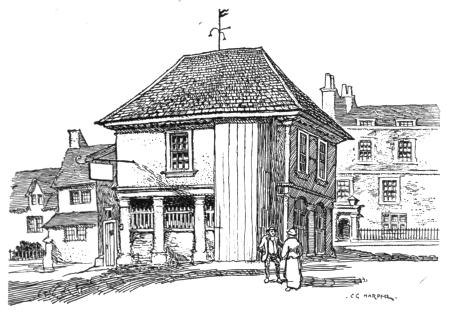
FARINGDON MARKET HOUSE.
Returning now to Radcot Bridge, and the boat which is waiting all this while to convey us on our downward voyage, we pass on to Radcot Lock, a mile down, and under “Old Man’s Bridge”; or rather the successor of an old wooden bridge that went by that name, and is now replaced by a smarter, white-painted[118] bridge of like material, of which type there are several others between this and Oxford. The landscape is here very open: the Berkshire hills situated at some considerable distance off, on the right, while the flat Oxfordshire plain, on the left, is lost in infinity. Here, on the way to Rushey Lock, are many backwaters, so screened by the tall growths of midsummer rushes and by the drooping branches of the willows, now made heavy by fully-grown foliage, and further masked by dense masses of water-lilies, that their existence is scarcely suspected. And thus we come to Tadpole Bridge, of which the very best to be said is that it is an eminently useful, and quite inoffensive stone structure of one arch, perhaps nearly a century old. We shall find, proceeding down the Thames, that all too often it is difficult to award even such negative praise as this to the bridges that cross the river.
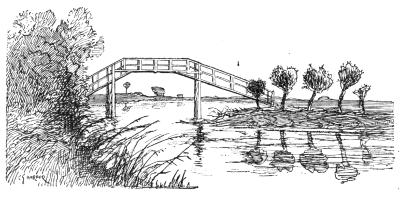
WOODEN BRIDGE ACROSS THE UPPER THAMES.
Here Tadpole Bridge carries an excellent road across to Buckland, two miles on the right, in Berkshire;[119] and two miles to the left, to Bampton, in Oxfordshire. We will first see what Buckland may be like.
It is soon obvious that it occupies a site on the ridge of hills running between Oxford and Faringdon; for its square church-tower presently becomes prominent on the skyline.
Buckland was for many generations, and until the present time of writing, in possession of the Throckmorton family, but now the extravagances of bygone baroneted Throckmortons, and the mortgage-charges they recklessly heaped up, have overtaken the present generation, and Buckland has at last been sold into other hands.
The great church of Buckland, largely Norman and Early English, is neighboured by a modern Roman Catholic church. The old church contains some monuments of these long-descended Throckmortons, and others to their predecessors, the Yate family, among them that of a seventeenth-century baronet and his lady, Sir Edward Yate and Lady Katherine, who would appear, between them, according to their epitaph, to have held all the virtues in fee-simple:
So the ancient tradition of the “bad Baronet” has its exception here, at any rate. But what shall we say of the lady whose “sanctimonious zeal” is the subject of such confident allusion? Only this: that there are two different meanings to “sanctimonious,” and that we must give her the benefit of the best of them. Referring to dictionaries we find that to be sanctimonious is either to be holy, or to be “hypocritically pious or devout,” like Shakespeare’s “sanctimonious pirate.” Unfortunately for the posthumous fame of the doubtless altogether estimable lady, there is but one connotation of that expression nowadays, and it is not the flattering one.
The stately stone eighteenth-century mansion of the Throckmortons, with widespreading wings, ending in pavilions looking more than a thought too airy for this cold climate of ours, was the work of the Woods, to whom much of the architectural dignity of the city of Bath is due.
There are (or we must now say there were) curious relics in this grand house of the Roman Catholic Throckmortons. They included a chemise of that precious “martyr,” Mary, Queen of Scots, whom we[121] know from the pages of history to have been one of the most wicked women that ever lived, and who was justly—but belatedly—beheaded; and a gold medal of Charles the First, another “martyr.”
Here, too, is, or was, the famous coat made for Sir John Throckmorton in 1811. Curious prints of the making of this celebrated article of attire, brought into being as the subject of a wager, are still sometimes to be met with. The fashioning of it was a hey-presto! kind of business. From the shearing of the sheep, all through the many processes of treating the wool, weaving the cloth, and making the coat, to the wearing of that coat for dinner at Newbury, the total time occupied was but thirteen hours and twenty minutes!
The way to Bampton from Tadpole Bridge is uneventful and unfrequented. This district was long notorious for its entire lack of roads, and we may read in old histories, “There was no stoned road of any kind leading from Bampton to the neighbouring towns and villages, and travellers were in the habit of striking across the common and finding their way to Witney, Burford, Oxford, or any other place as best they could.”
From these circumstances Bampton was known as “Bampton-in-the-Bush,” and appears of speculative interest; but Bampton-in-the-Bush has long since lost the greater part of its name; and now that the roads in these parts of Oxfordshire are no better and no worse than those to be found elsewhere in this county, and now the scrub-woods and widespreading common-lands that once overspread the locality have[122] given place to flat and uninteresting fields, it is “Bampton” only; and a very dull place at that.
Its church is the principal feature—and a very beautiful and unusual feature—of Bampton. The tall stone spire is visible for miles across the level landscape. It is largely a Transitional-Norman and Early English church, and cruciform, with central tower and north and south transepts. The broach-spire is supported at the angles by graceful flying buttresses, from which rise shafts, each of these four shafts bearing the stone effigy of an apostle. The effect of these figures, standing out boldly against the sky, is very striking and unusual.
In the porch the otherwise unremarkable tablet to Thomas Euston, who died in 1685, proceeds to record the death of “Mary, his only wife,” in 1699. No polygamist he, at any rate!
The exceptional size and beauty of Bampton church are greatly due to the peculiar ecclesiastical history of Bampton, which until 1845 rejoiced, or ought to have rejoiced, in the possession of no fewer than three vicars for this one church; and, what is more extraordinary still, these three clergymen had each a vicarage, standing respectively north, south, and east of the church. To complete this holy fence, so to speak around it, on the west side was situated the Deanery, now a farmhouse, where the Deans of Exeter once resided when taking their summer holidays. The origin of this remarkable arrangement is due to Leofric, first Bishop of Exeter, a native of Bampton, who, having endowed the church, presented the living to the Dean and Chapter of Exeter; with the stipulation[123] that all vicars presented must have already served in the diocese of Exeter. The three vicars were styled “Portionists,” each taking four months’ duty in the year. This curious arrangement came to an end in 1845, when the parish was divided into Bampton, Bampton Aston, and Bampton Lew, each with its vicar, and either of the two newly-constituted parishes, it may be added, with its fearsome would-be Gothic church of that not sufficiently instructed period.
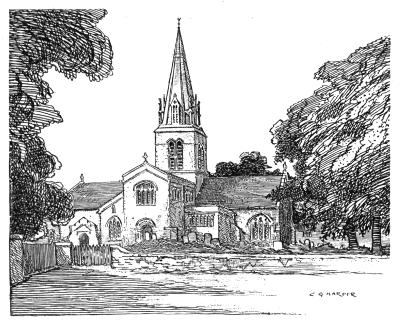
BAMPTON CHURCH.
No one ever reads architectural descriptions, and so let it suffice to say that the interior of Bampton church is very well worth seeing; notably for its fine Saxon and Transitional-Norman chancel-arch[124]. The monuments include one with a mutilated stone effigy of George Tompson, dated 1603. It could never have been a good example of the sculptor’s art; and time and unsympathetic hands have conspired to reduce it to something the appearance of an almost shapeless log, but the rhymed epitaph, cast in characteristic early seventeenth-century form, has a certain prettiness of imagination:
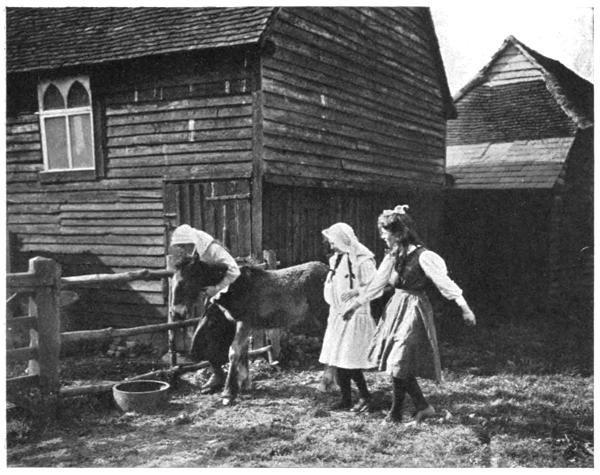
A THAMES-SIDE FARM.
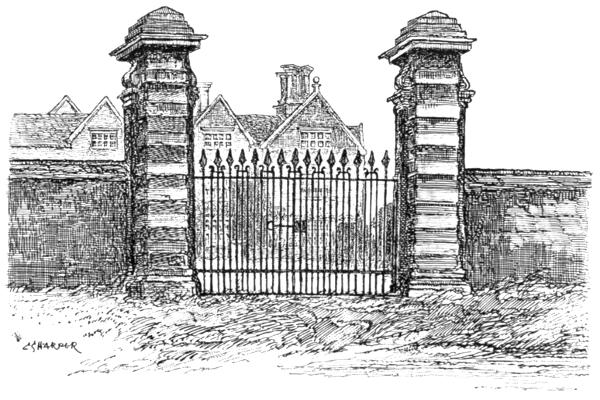
GATEWAY, COTE HOUSE.
There stands in the flat country between Bampton and Northmoor, amid the level meadows, washed, and not infrequently severely flooded, by the Charney Brook, by the Windrush, and by many mazy rills, the picturesque old mansion, now a farmhouse of a superior residential type, of Cote. It was built in the reign of James the First, between the years 1608 and 1612, by one Thomas Horde, and was originally surrounded by a moat. Alterations, apparently undertaken in 1704, the date of the fine wrought ironwork of the old gates secluding it from the road, abolished the moat; but a squat tower at one end of the grey, many-gabled mansion still discloses the old ideas of defence. It was at one time some twenty feet higher. At that period, when Thomas Horde built his house at Cote, times were, in fact, still unsettled, and one never knew into what dangers one might be drawn. The very year when he began[127] building was the year of the Gunpowder Plot; and when such things could be, a man did well to stand upon the defensive.
Beyond Cote, towards the river, lies Shifford, secluded and rarely visited. The old church of Shifford fell down in 1772, and a new building took its place. This was removed in 1863.
Shifford is traditionally the scene of a Parliament, or Witanagemot, held here by Alfred the Great about A.D. 890: “There sate at Shifford many thanes, many bishops, and many learned men, wise earls, and awful knights: there was Earl Elfrick, very learned in the law; and Alfred, England’s herdsman, England’s darling; he was king of England; he taught them that could hear him how they should live.”
There still remain, in the meadows by Shifford, traces of earthworks and the stump of an ancient cross, sufficiently proving that this was indeed anciently a place of considerable importance. But commerce with the world of affairs no longer stirs the pulses of Shifford, or the neighbourhood of it, and the Thames steals softly along, between tall palisades, as it were, of rushes, and past the sentinel willows, with only an occasional farmstead in sight; farms where one might almost suppose the farmers to consume their own produce, so remote from all methods of conveying it away do they seem to be.
HARVESTS OF THE THAMES: WILLOWS, OSIERS, RUSHES
The willows, pollarded or left to their natural growth, that form, as it were, a continuous guard of honour along many miles of the upper course of the Thames, and overhang with a wild luxuriance its mazy backwaters, are indeed a guard to those banks in more than fanciful phrase. Their tangled roots clutch them in many-fingered embrace and support them in times of flood, and their gnarled and fantastic trunks serve the useful office at such times (when the meadows are under water and resemble inland lakes) of exactly delimiting the course of the stream, where the current runs deep and strong, and dangerous. Willows we always associate with a watery situation, and their habit is indeed better suited to low-lying meadows and to river-courses than to places high and dry. The great demands the willow makes upon water place it in the forefront as a drainer of marshy soil: and thus not only beside the Thames, but along rivers in general, and in the fens and on Sedgemoor, where the energies of hundreds of years past have been directed towards expelling the water, it is a familiar feature of the landscape. We also inevitably associate the willow, and especially that drooping variety, of the pendant boughs and leaves, known as the “weeping willow,” with melancholy, and, from Shakespeare to W. S. Gilbert, it is associated with unrequited love. The spot where Ophelia met her death is thus described in Shakespeare:
The expression “hoar leaves” refers to the under side of the willow-leaf, of a whitish or silvery hue, not unlike hoar-frost; prominently seen when a strong wind ruffles the branches.
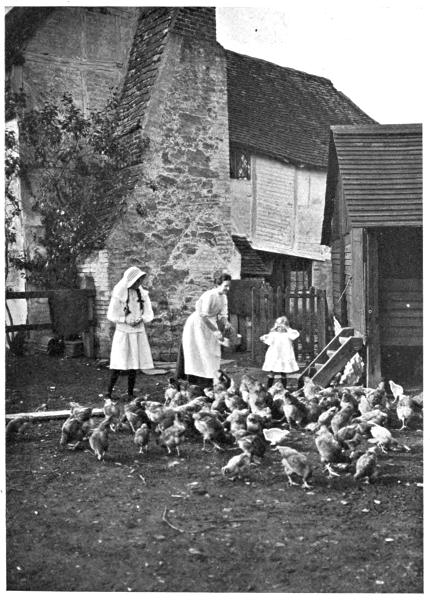
A THAMES-SIDE FARM.
The love-lorn among the characters in the operas written by Sir W. S. Gilbert plentifully carry on the old tradition, and from Archibald Grosvenor (“The All-Right”) and Patience, in the duet “Hey, Willow-waly O!” to Teresa, in The Mountebanks, who sings, “Willow, willow, where’s my love?” they frequently apostrophise this tearful tree. Nay, even in the Bab Ballads we read of a troubadour whose refrain was “Willow, willow, o’er the lea,” and who maintained it with such pertinacity that it is at last rightly described as “his aggravating willow.”
No one can pretend that a freshly-pollarded willow is a beautiful object, as it stands up, naked, by the riverside, shorn of all its branches, and resembling nothing but some rude gigantic club with fist-like, knuckly head, whence those branches have been ruthlessly cut away. Even after two or three seasons, when those branches have been allowed to grow again and to present a more or less mop-like head of foliage, the pollarded willows look whimsically like so many[132] Shockheaded Peters, after the style of the familiar Struwelpeter German toy-book. Not beautiful, and not perhaps ugly, they are the grotesque comedians of the riverside scenery.
The willow is what scientists and arboriculturists might—and possibly do—style an “economic” tree; that is to say, it has commercially useful features. Its bark is an excellent medicine for ague, and useful for tanning, although oak-bark is better. The ancient Britons wove their light boats, their “coracles,” from willow-wands, and cricket-bats are now made from its wood. Thus descriptive writers upon cricket-matches, thinking to be picturesque, are frequently found using the vicious phrase “wielders of the willow,” when in fact they mean batsmen. Many varieties of coarse baskets are now manufactured from willow branches. Hence the assiduous pollarding of the willow about once every seventh year, in the middle of winter.
Even the familiar osiers of the Thames have some of these economic uses, and the osiers themselves are a variety of willow.
says Milton, illustrating, in his Comus, the almost inevitable companionship of these leafy cousins.
If we wished most strikingly and picturesquely to describe the difference between an osier and a willow, we should say that an osier was a willow without a trunk. The osiers grow in beds, as a dense array of upright rods, and, to the uninitiated, there is but one[133] kind of osier, but experts are said to be able to distinguish three hundred varieties. Experts are wondrous folk. Strange to say, although we associate osiers with watery flats and soggy patches of ground, the “hams,” or “holts,” as the osier-beds are generally styled, must, if it is desired to grow a good crop, by no means be saturated with water. To successfully form an osier-plantation, the land must be well trenched or otherwise drained of all stagnant or surplus water. Basket-willows refuse to thrive in land that is awash, and they require the sustenance of good manure. Weeds, too, hinder their growth, and they are susceptible to attacks from fly.
All these particulars doubtless come as surprising information to those whose life on the Thames consists merely of rowing, sailing, or camping. If they notice the numerous osier-beds at all, it is only to wonder idly at the dense thickets of tall straight rods they form; and it is but rarely suspected, either that they are carefully planted and tended, or that the crop of rods is both valuable and precarious.
An osier-bed is formed by planting cuttings of some six inches in length. Like cuttings from its big brother, the willow, they strike easily, and soon form vigorous plants. Indeed, in the case of green poles and posts made of willow, many worthy housewives have frequently been astonished at finding the posts they use for hanging out the domestic washing budding lustily and becoming healthy trees.
An osier-rod of one year’s growth is ripe for cutting, and cutting proceeds every year, from the established stool: the season’s growth being, according to the[134] variety, and to circumstances, anything from ten to fifteen feet.
Osier-growing is a considerable industry, and, with due care and ordinary good fortune, very profitable; for there is not at present a sufficiency grown in England to satisfy the demand, and we thus import largely from France, Belgium, and Holland. But, as shown already, the osier requires to be properly tended, and has its enemies. Prominent among these is the water-rat, whose destructive habits, in gnawing through the base of half-grown rods, are very costly to growers.
The rods are cut in autumn or winter, and are then sorted into four sizes, known as “Luke,” “Threepenny,” “Middleborough,” and “Great.” Of these, “Luke” is the smallest. They are done up for sale in “bolts,” i.e. bundles, forty inches round.
To prepare osier-rods for basket-weaving, they are stacked upright in shallow trenches filled with water, their butt-ends immersed from six to eight inches; and thus they are left until spring, when, with the rising of the sap, they begin to throw out buds. When April at last is merging into May, the rods have already burst into leaf and begun forming roots. Then is the opening of the rod-strippers’ season; for at this juncture the bark is most easily separated from the rods. Rod-stripping is one of the few surviving primitive rustic industries, carried on, according to the mildness, or otherwise, of the spring, in the open air, or in rustic sheds. This is pre-eminently an occupation for women and children, and generally forms a picturesque scene, not remotely[135] unlike a gipsy encampment. The immemorial instrument used in peeling or stripping the rods is a “break,” formed of two pieces of iron or steel mounted side by side on a wooden post, about waist-high, somewhat resembling an exaggerated tuning-fork, or a “Jew’s harp.” The rods are drawn through the springy embraces of this contrivance, which thus cleanly strips away the bark, and leaves the rod a pure white wand. For the protection of more than usually delicate rods from being bruised, the breaks are occasionally faced with india-rubber.
The whereabouts of a busy group of osier-peelers are readily discovered from some little distance, for the operation of drawing the rods through the breaks is accompanied by a sharp metallic “ping”; a chorus of these sounds in several keys carrying a long way across the still meadows. And if not by sound, certainly by sense of smell is the group of busy workers to be located, for the stripped osiers, or rather, the peelings from them, give forth a strongly aromatic and pungent odour.
The peeled rods are then carefully dried and stored away. They form the material for white baskets, or for baskets that are to be dyed. The rods from which yellow or brown baskets are to be made are treated differently, being peeled in hot water, or in steam; this method—known as “peeling buff”—bringing out the juices of the rods and staining the surface, according to the variety of osier, buff, brown, or yellow.
The ancient method of keeping count of the number of bolts stripped by each worker was identical[136] with that employed in the hop-gardens, and is still frequently used. This is by “tally.” Computation by tally is one of the most ancient—perhaps the most ancient—means of reckoning known, and preceded the use of arithmetic. It consists of taking a short stick of some soft wood, splitting it into equal halves, and cutting notches along it. This method of keeping count is simplicity itself, and absolutely beyond possibility of fraud or error. The method employed was, and is, to give each worker half of the split tally stick; the other half being kept by the foreman. In osier-stripping, upon a bolt, or bundle, of rods being finished, the foreman takes the worker’s half of the tally, and, fitting it to the half he carries, cuts a notch; and so on with each successive bolt. The point is that the notches of these two halves must of necessity agree, or “tally.”
The tally system of accounts lasted until a very late period in those most conservative of institutions, Government offices, and it was the accidental flare-up of a great mass of old Exchequer tallies that destroyed the old Houses of Parliament at Westminster, in 1834.
The rushes, too, that grow so luxuriantly beside the waters of the upper Thames have some economic value, and form a very bulky harvest. The usual frequenters of the Thames, who see nothing of the river in spring, autumn, or winter, think of the rushes only as those tall sword-like blades of living green that keep guard along so many miles of meadows; but the Thames in April shows a very different complexion of affairs. Then the rush has merely begun to show its sword-point above the water; and[137] does not attain its full height until June. It is in flower during July and August; and in that last month comes the harvest. It is perhaps rather risky harvesting, and is accomplished from a punt. The rush-cutter comes to his work armed with a reaping-hook fixed to the end of a long pole, so that he is enabled to reach deep down below the surface of the water, where the rushes spring from their roots.
The cut rushes are spread out in the meadows, to dry, for two or three weeks; and, being so largely charged with water, diminish remarkably in the process of drying; a freshly-cut shock of sixty-eight inches’ girth shrinking to a bolt of forty inches. A bolt of this size is generally sold for one shilling. Dried rushes are used for making light baskets, and often for thatching; but in olden times one of the principal uses for them was the strewing of floors in the home, for those were the days before the introduction of carpets. The peculiarly sweet scent of the dried rush made it especially welcome for this purpose, and a fresh supply of rushes was thought the right of every new guest. But the rush-strewn floors of those ancient domestic interiors had their own peculiar dangers and nastinesses, if the sweeping and the renewing were not frequent; for the dogs of the household generally lived and slept in the house, and it was the usual practice for guests at table to fling them bones and unappetising pieces of fat, which therefore often lurked unsuspected for the unwary heel among the rushes; often enough only belatedly revealing their presence to the nose.
NEW BRIDGE, THE OLDEST ON THE THAMES—STANDLAKE—GAUNT’S HOUSE—NORTHMOOR—STANTON HARCOURT—BESSELSLEIGH
The Oxfordshire side of the river continues as flat as ever, to New Bridge, which, rising greyly from amid the sedges, commands extensive views, less by reason of its own height, which is nothing to speak of, than by the lowness of these level lands. New Bridge, which carries the Abingdon and Witney road across—it is not a greatly-frequented road—is the oldest bridge existing on the river. The traveller who has spent much time in exploring in the highways and byways of England is not surprised at this paradox, and has indeed met with so many Newtowns and Newports, Newmarkets, New Inns, New Colleges, and the like that are demonstrably of a hoary antiquity, and older than most other towns, markets, inns, and colleges, that he really expects a New Bridge to be at least five centuries gone in newness. And this bridge was built c. 1260, by the monks of a neighbouring monastery, which itself has wholly disappeared, while their old pont remains as sturdy as ever.
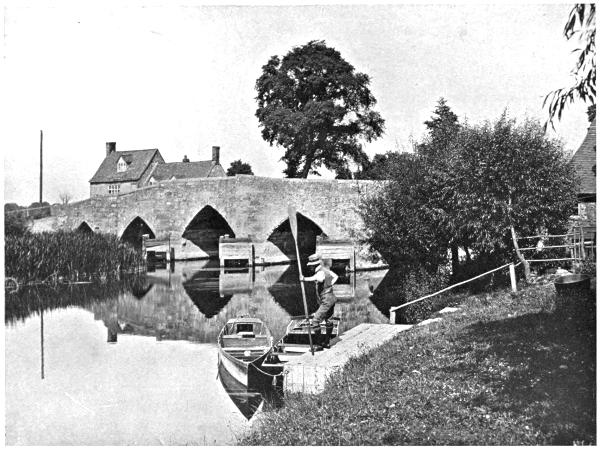
NEW BRIDGE: THE OLDEST BRIDGE ACROSS THE THAMES.
It is a queer, seven-arched building, just as Leland wrote of it in the time of Henry the Eighth, “lying[141] in low meadows, often overflowed with rage of rain.” At the Berkshire end is the “Maybush” inn, and on the Oxfordshire side is the “Rose,” in friendly rivalry; but where the trade comes from, in this lonely situation, to keep them both going, is a mystery. The customers can be but few, but what magnificent thirsts they must possess!
At New Bridge the river Windrush falls into the Thames, from its source in the Cotswolds, thirty miles away, after passing through Witney, and by some very beautiful scenes. It is the “nitrous Windrush” of Drayton’s verse: those supposed nitric qualities of its waters having originally led to the establishment of Witney’s blanket-making industry.
That the flat, low-lying lands here were in former times under water seems sufficiently evident in the name of Standlake, a village a mile-and-a-half distant from New Bridge. A British village, discovered in 1857, near by, may have been one of those lake-villages in which, for security, our remote ancestors dwelt. The church of Standlake has a quaint semi-detached octangular tower, crowned with a spire.
There are some curious and interesting places to be found in these flat, unfrequented lands. Proceeding towards Northmoor, ever and again crossing tributary rills of the Windrush, the moated manor-house, now a farm, of “Gaunt’s House” lies secluded amid meadows. It takes its name from one John Gaunt, who originally built it about 1440, but there is nothing nearly so old here to-day. The place has its own little niche in history, for in the seventeenth century,[142] at the outbreak of the Civil War, it was the property of that Dr. Samuel Fell, Dean of Christ Church, Oxford, who was the subject of the famous undergraduate rhyme—
The Doctor was a Royalist, and his moated house here was held for that side in 1644. After a stubborn defence by its garrison of fifty men, who kept a besieging force of eight hundred at bay for three days, it surrendered on May 31, 1645. The house, greatly injured in this warlike passage, was rebuilt in 1669 by Dr. John Fell, who also was Dean of Christ Church. It is not a picturesque house, and seems to have been greatly modernised about the beginning of the nineteenth century. The woodwork of one of the doors is, however, curiously pierced, as though for musketry defence.
But, although the house itself is commonplace, the broad moat, brimming full of water, is beautiful, and in summer-time is so covered with waterlilies that the water itself is not to be seen. Let those who think this the language of exaggeration go and see for themselves.
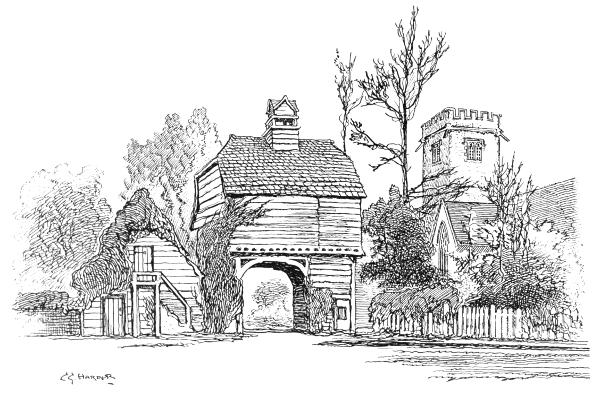
NORTHMOOR: CHURCH AND DOVECOTE.
An old bridge, replacing a former drawbridge, gives access to the house, through two tall gateposts surmounted by worn stone heraldic effigies, blunted by time out of all recognisable likeness; not only to anything in nature, but even to anything in heraldry. Here, serving to keep the wooden gateway open, is an iron cannon-ball found in the moat, which, according[145] to an inscription on the wall, was cleared in 1883.
Northmoor village, near at hand, has an interesting church of the Early English period, and a charming and unspoiled Jacobean mansion adjoining, which has the appearance of never having been altered since the first building of it.
Oddly placed by the road between mansion and church, is a delightful old timbered pigeon-house, which seems to be contemporary with the old residence.
At the west end of the church a quaintly balustered bell-loft bears the following inscription, obviously considered (by those who inscribed it) to be poetry:
Which was very wrong of him, a Protestant, living under the reformed religion.
The inner sides of the aisle-window splays here at Northmoor exhibit that peculiarity already noticed in several churches of the upper Thames Valley: a more or less decorative treatment of the inner arch. Here the special treatment is confined to a corbelling-out of the archway; but this is effected in a quaint manner: the corbel on one side being provided with a kind of vaulting-shaft. Here, as elsewhere along, or near, the course of the Thames, the strong influence of the river upon the imagination and work of the old architectural sculptors is distinctly to be noted:[146] the capitals of the shafts being carved with representations of aquatic plants.
But the chief attraction, in all these parts adjacent, is of course the village of Stanton Harcourt, and that it is so, you who penetrate to it, along the level roads, cannot fail easily to perceive, if not by evidence of many sightseers making for it, then, at any rate, in the numerous notices displayed offering accommodation for tea-parties. Stanton Harcourt is beautiful, alike in its old-world rustic village of thatched, unpretending cottages, screened by noble elms from rude blasts, and in the romantic and unusual group formed by the ancient church-tower and the towers of the old manor-house. Approaching, it is as though the church had two towers, for the chief one of the manor-house is very like its ecclesiastical neighbour.
Stanton Harcourt must have derived the first part of its name from some stone road, but the road is obscure, and an absurd local legend, almost too childishly-ridiculous to be repeated, tells us that it arose from the brave deeds of a former Harcourt, who, in that conveniently vague period, “ages ago,” was fighting desperately in some unnamed battle, and was enjoined by his chief to fight on. “Stand to un, Harcourt,” he exclaimed; and Harcourt feats of arms in “standing to un” accordingly won the day. A curious thing may be noted: that the stones called the “Devil’s Quoits,” near the village, are themselves thought to be relics of a battle fought in A.D. 614, between the Saxons and the British; long before there were any Harcourts in the land.
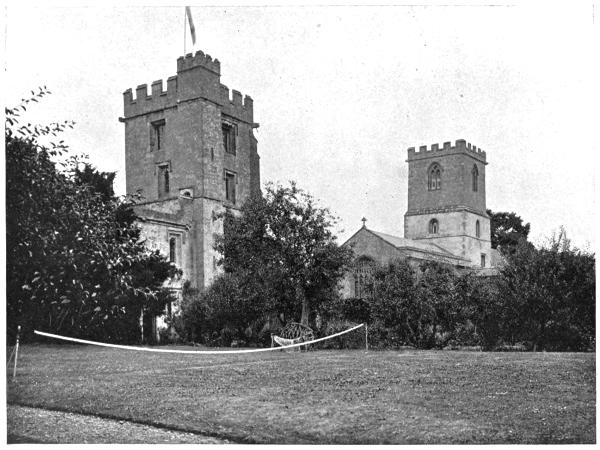
STANTON HARCOURT: MANOR HOUSE AND CHURCH.
The Harcourts first came into possession of Stanton over seven hundred years ago. It was in 1125 that the second Queen of Henry the First gave the property to one Millicent de Camville, whose daughter married Richard de Harcourt, thus the first of a long line of that family, which really ended with the mother of Edward Vernon, who assumed his mother’s maiden name, and died in 1847, as Archbishop of York. The later and present Harcourts are therefore really Vernons.
The ancient and beautiful manor-house of Stanton Harcourt, a group of buildings forming a quadrangle, was built about the middle of the fifteenth century, with a rebuilt gatehouse tower of a century later, the work of a Simon Harcourt of that period. The house was occupied until 1688; and then, with the death of Sir Philip Harcourt, it fell upon evil times, for his widow deserted the place. Nuneham Courtney, which, in the course of these pages, we shall visit, below Oxford, had been purchased in 1710 by a later Simon Harcourt, and to it the family seat was removed, and the manor-house at Stanton allowed still further to fall into decay. Seventy years later the buildings, by that time mostly ruinous, were demolished, with the exception of the gatehouse, one of the towers of the mansion, and the curious and interesting ancient kitchen, which has only one fellow to it in England: the well-known and remarkable Abbot’s Kitchen at Glastonbury.
This Stanton Harcourt kitchen, standing now beside quiet lawns, and overgrown with creepers and ivy, has long lost any association with cookery, and[150] looks particularly ecclesiastical, except perhaps for the rampant griffin, holding a vane, which crowns the tall pyramidal tiled roof, and wears rather a devilish expression. He is a formidable griffin, too, measuring eight feet high.
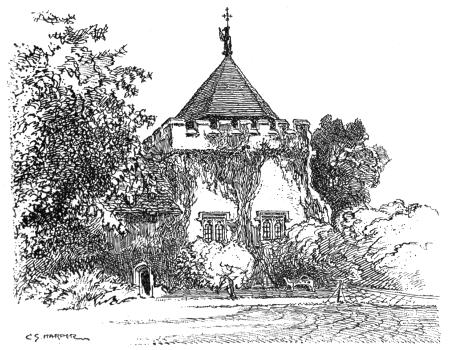
THE KITCHEN, STANTON HARCOURT.
To properly impress the reader, or the beholder, with this kitchen, it is necessary to give its dimensions. It has a total height of seventy-two feet, made up of thirty-nine feet of the wall, twenty-five feet roof, and the eight feet, as aforesaid, of that banner-bearing monster.
There are no chimneys. The fires were made against the walls, which are three feet thick; the[151] smoke from them escaping through wooden louvres, or shutters, above. According to the direction from which the wind blew, these louvres were shut to on one or other of the four sides. The mechanical ingenuity of the age was at a low level, and was not able to contrive means by which these ventilators could be opened or shut from within; so we find a turret staircase leading up to the roof, around which runs an open-air passage for access to the louvres.
Alexander Pope, residing in the neighbouring old tower during three summers, “translating” Horace, and writing fantastic letters in the meanwhile to his friend, the Duke of Buckingham, exercised his fancy on this kitchen, and found it to resemble the forge of Vulcan, the cave of Polyphemus, and the Temple of Moloch: “The horror of it has made such an impression upon the country people that they believe the witches keep their Sabbath here, and that once a year the Devil treats them with infernal venison, viz. a toasted tiger, stuffed with tenpenny nails.”
But all, according to him, was decrepit at Stanton Harcourt:—
“Its very rats are grey. I pray the roof may not fall upon them, as they are too infirm to seek other lodgings.”
It is the nature of rats to be grey; but we need not seek to deprive Pope of his point. The place was haunted, too, by the ghost of one “Lady Frances,” and we hear “some prying maids of the family report that they have seen a lady in a fardingale through the keyhole; but the matter is hushed up, and the servants are forbidden to talk of it.”
“Pope’s Tower” is in three floors. On the ground-floor is the domestic chapel, roofed in fan-vaulting. You enter it by an ante-chapel with a wooden ceiling in blue, spangled with gilt stars: a gorgeous, but tarnished firmament. The upper room, known as “Pope’s Study,” was occupied by him during two hard-working summers, and he celebrated the completion of his task by inscribing on a pane of red glass in one of the windows, “In the year 1718 Alexander Pope finished here the fifth volume of Homer.” The glass has been removed, and is now at Nuneham.
I have already placed the word “translating” in quotation-marks, to indicate the fact that Pope’s claim to have rendered Homer’s Iliad from the Greek into English verse was a mere pretence. He was no Greek scholar, and fobbed off upon his publisher and upon confiding subscribers his metrical version of translations by more scholarly persons. He grew rich upon the fraud, and still enjoys a reputation among the uncritical for a classical learning he did not possess.
The church, standing close at hand, has a central tower, of which the lower stage is clearly seen to be Early English. On this an upper stage has been reared. The junction of the two is prominently marked by the upper stage being boldly set back; producing a striking sense of massiveness.
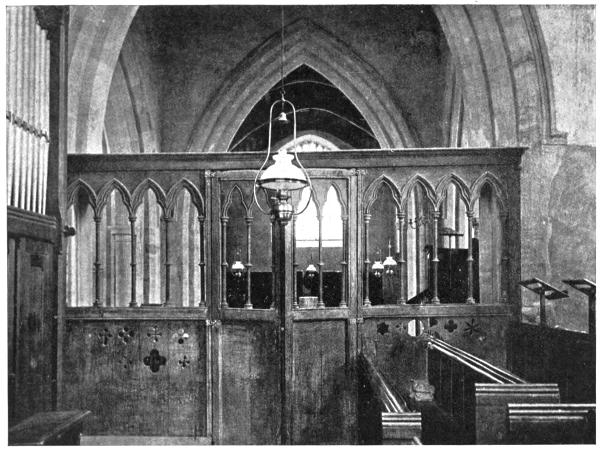
EARLY ENGLISH SCREEN (UNRESTORED), STANTON HARCOURT.
The chancel-screen, west of the crossing of north and south transepts, is of exceptional interest, as perhaps the earliest such screen remaining in this country unaltered. The hinges and the lock and[155] bolt of the door are in perfect order, and as good as ever they were, although now nearly seven hundred years old. The screen is of the Early English period, simple and pure in its every detail. A little more care for this relic would have resulted in the organ and the choristers’ seats being placed at less close quarters. The lock of the door is original, and so are the several curiously-patterned holes pierced through the lower part of the screen.
The altar-tomb in the north wall of the chancel, said to be that of Isabel de Camville, is very short, and its architectural details are of a hundred years’ later date than her death, leading to the supposition that this is rather an Easter sepulchre than a tomb. The sculptured emblems of the Passion support this view. On the south side is the tomb, with effigy, of Maud, daughter of Lord Grey, of Rotherfield Greys. She died, wife of Sir Thomas Harcourt, 1394. In the Harcourt Chapel, locked, and the key kept at Nuneham, many of that family lie; prominent among them Sir Robert Harcourt, and Margaret his wife, 1471; both effigies wearing the order of the Garter, the lady represented with it above the elbow of her left arm. She is one of the three dames known to be so decorated in monumental effigy: the others being the Duchess of Suffolk, at Ewelme, and Margaret Camoys, at Trotton, Sussex. There were some sixty ladies admitted to the Order between 1376 and 1488: the last of them the Lady Margaret Tudor, mother of Henry the Seventh. Since that time, the only women Companions have been reigning Sovereigns or Queens-consort.
Here, among the Harcourts, is an altar-tomb to that Archbishop of York who was not, as already shown, really a Harcourt, but a Vernon; and a life-sized marble effigy of William, third Earl Harcourt, Field-Marshal, and G.C.B., who died 1830.
On the south side of the church an unassuming tablet records the tragic fate which befel “John Hewet and Sarah Drew, an industrious young man and virtuous maiden of this parish, contracted in marriage, who, being with many others at harvest, were both in one moment killed by lightning, on the last day of July, 1718.”
Beneath are some lines written by Pope:
The Berkshire side of the river, from New Bridge downwards, now demands some notice. There, instead of the unbroken flatness that continues through Oxfordshire as far as the city of Oxford itself, you have a lofty ridge more or less closely continuing to follow the course of the stream. A fine highway runs along the ridge, with pleasant and interesting villages upon, or near it. There[157] may be found Longworth, and Appleton; and there, too, Besselsleigh.
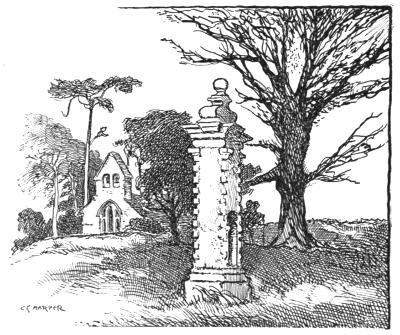
BESSELSLEIGH: CHURCH AND FRAGMENT OF MANOR HOUSE.
We can scarcely call Besselsleigh retired, for it stands directly upon this fine, broad, and well-frequented road that leads out of Oxford, on to Faringdon and only students of maps know what many towns further west. The motors come swishing along it at some very fine turns of speed, for there is none to say them nay. Such travellers never notice Besselsleigh, for the modern mansion stands well hidden within its park, and of the old house that once almost fronted the high road there is absolutely nothing left but two of the stone entrance gateposts, and those in a more or less wrecked condition.[158] Those travellers may indeed notice the church, but even that is doubtful, for it is a very little and a very humble church, and although its little churchyard gives upon the road, it is so enshrouded by large trees and small trees that its very existence may not be suspected by quick-moving traffic.
The trees here are indeed noble, and form a splendid aisle of living green: elms, oaks, and Scotch pines intermingled. The church, rather barn-like, has an Early English double bell-cote at its west end. Of the Besils who gave this place its name in 1350 history has but a moderate amount to say. They married the estate, so to speak, with an heiress, last of the family that had hitherto held it; and in the course of time it passed from them in like manner: the heiress-general of the Besils marrying a Fettiplace. And nowadays for even a Fettiplace one may seek in vain, for that family, once so numerously spread over Oxfordshire, Berkshire and Gloucestershire, is itself extinct. But Besselsleigh did not pass from them in that accustomed manner, for they sold it to the Lenthalls in 1634, and it is still held by the same race.
“At this Legh,” says Leland, “be very fayre pastures and woodes; the Blessels hathe been lords of it syns the time of Edward the First. The Blessels cam out of Provence in Fraunce, and were men of activitye in feates of armes, as it appearith in the monuments at Legh; how he faught in lystes with a strange knyghte that challengd hym, at the whiche deade the kynge and quene at that tyme of England[159] were present. The Blessels were countyed to have pocessyons of four hundred marks by the yere.”
Sir Peter Besils seems to have been the worthiest member of this family, for he not only gave freely of stone to the building of Burford Bridge at Abingdon, and of Culham Bridge, close by, but left £600 by his will of 1424 for the purpose of making amends for any wrong he or his ancestors may have done any man. If his executors did not spend that sum in this manner, presumably because they could find no aggrieved persons, then they were to construct roads with it.
Mr. Speaker Lenthall, to whom Besselsleigh was sold in 1630, repaired the little church, and here later members of that family are buried. But none of them have attained to the fame of Mr. Speaker, who died in 1662, and lies buried in Burford church. He was a long-headed and tactful man, and, as such, one well calculated to hold his own in troubled and uncertain times, by care not to give offence to either of the contending parties. He was member of Parliament for Woodstock, and was elected Speaker in the Long Parliament.
King Charles, at that critical moment in parliamentary history when his Majesty went down to the House in person, for the purpose of arresting the five members who had courageously withstood his will, asked Lenthall if he saw any of these five present, and he replied, with marvellous resourcefulness at so strained a juncture: “May it please your Majesty, I have neither eyes to see nor tongue to speak in this place but as this House is pleased to direct me, whose[160] servant I am here; and humbly beg your Majesty’s pardon that I cannot give any other answer than this to what your Majesty is pleased to demand of me.” Lenthall was one of the few prominent men of that time who were able to enrich themselves. While most were ruined in those long-drawn troubles, he snatched profits out of them, became extensively rich, and died owner of many manors. These are the goodly rewards of a moderator; but history gives no favourable verdict upon such.
CUMNOR, AND THE TRAGEDY OF AMY ROBSART
One comes more readily to Cumnor by road, but more picturesquely by river, from Bablockhythe, whence a byway leads steeply up to that famous place. Cumnor is indeed of such fame that, although one must needs allow it to be a hill-top—certainly not a valley—village, yet to omit it from these pages would surely be unpardonable. At Bablockhythe remains the last of the old river ferries, capable of taking a wheeled conveyance across; and capable, too, of giving an unwary oarsman or punter a very nasty check with its rope, permanently stretched athwart the stream.
There is some very noble, still, quiet scenery at, and just above and below, Bablockhythe, where the water runs with a deep and silent stealthiness, and the bushy poplars and pendant weeping willows are reflected with such startling faithfulness that the reflection in the water beneath looks more solid—much more real—than the foliage above. It is an illusion of the weirdest kind.
In one or other of the quiet backwaters between this and Oxford there may be found, by those who care to seek, the curious aquatic plant known as the “water-soldier.” Botanists of course know it by[162] another, and a horrific, name: to them it is “stratiotes aloides.” But to those few rustic folk who know at all of its existence—and it is not a common affair—it is the “water-soldier.” It does not, however, convey any military impression to the ordinary beholder, being just a plumed bunch of leaves which in summer-time is found floating on the surface; coming up from its autumn, winter, and spring home below, in the river-mud, and growing long suckers, resembling strawberry runners, each of them with a youthful “soldier”—or recruit, shall we say—at its end. These form leaves, and each one produces a white flower. When these flowers fade the “water-soldier” and its outposts of young sink again to the river-bed, and there rest until summer comes again, when the process is repeated.
But what of Cumnor? It looks boldly down upon the Thames Valley from a conspicuous wooded ridge. It is a village picturesque alike in itself and in its romantic history, traditions, and legends. Figure to yourself a place of scattered rustic cottages, not yet touched to commonplace by that shrinkage of distances caused by the rapidity and frequency of modern methods of travel which have brought expansions, rebuilding, and general modernisings in their train; with an ancient and stately church rustically overhung with trees quite in the old Birket Foster and first-half-of-the-nineteenth-century convention. That is Cumnor to-day.
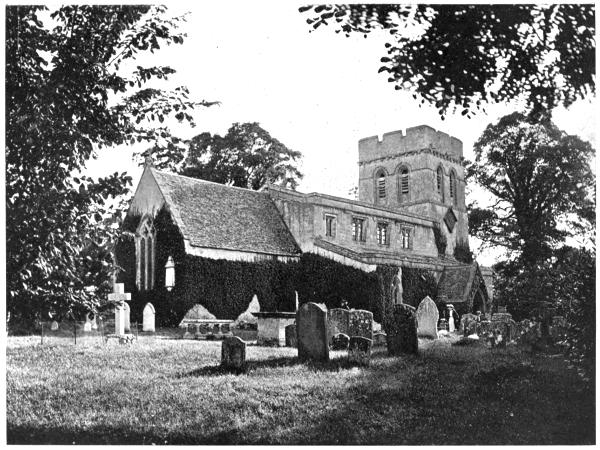
CUMNOR CHURCH.
In Domesday Book the place appears as “Comenore,” but we hear of it in Anglo-Saxon times as “Colmonora”; and it is supposed to have obtained[165] the first part of its name from one St. Colman, or Cuman, a seventh-century Gaelic saint. The termination, “ora,” doubtless refers to the shores of the Thames; not, however, nearer than a mile and a half, and at a considerably lower level.
Cumnor had, apparently, an early church, replaced by the existing fine Transitional Norman and Early English cruciform building, not yet ravaged by the “restorer.” Cumnor Place, built about 1350, as a sanatorium for Abingdon monastery, after the fearful experiences of the “Black Death” pestilence, stood very closely adjoining the picturesque churchyard, on its south side, and, after several changes of owners, and at last sunk to the condition of a roofless ruin, was finally demolished in 1811, and its stones used in the rebuilding of the church at Wytham.
There is much of interest belonging to Cumnor church, from the battered old altar-tomb in the churchyard, with barely legible inscription, to Lieutenant William Godfrey, “who faithfully served King Charles ye I. from Edgehill Fight to ye end of ye unhappy wars,” down to the curious epitaph on the exterior east wall, upon “Christian, the wife of Henry Hutt”:
This paragon of virtue, worth, and contentment with her station in life died in 1740, aged 31.
A real startler awaits the stranger who enters unsuspectingly into Cumnor church. This is none other than a singularly vivid likeness of Queen Elizabeth, done in stone and standing on a pedestal in the north aisle. The pale effigy, standing there in the subdued light of the church, is calculated to stir the nerves of the most stolid. The statue, a singularly fine one, represents the Queen in the costume of the period, made familiar in many statues and paintings. She is standing, and holds the orb and sceptre, symbols of sovereignty. This work of art has a history of some curious interest. It was originally set up in the grounds of Cumnor Place by Robert Dudley, Earl of Leicester, in honour of his great patroness. Perhaps it is due to this origin that the statue represents the Queen so pleasingly. Zucchero, in his painting of her, and the many other sculptors who plied their chisels on this inspiring theme, never produced anything to vie with this in combined charm and dignity. Elsewhere you perceive “great Eliza”—in spite of courtly efforts to idealise her—rendered not a little uncouthly. Majesty, with more than a dash of vinegar, and plain evidences of the termagant, are characteristics of the most of Queen Elizabeth’s portraits in marble, stone, and paint; but here she is rendered in terms of grace.
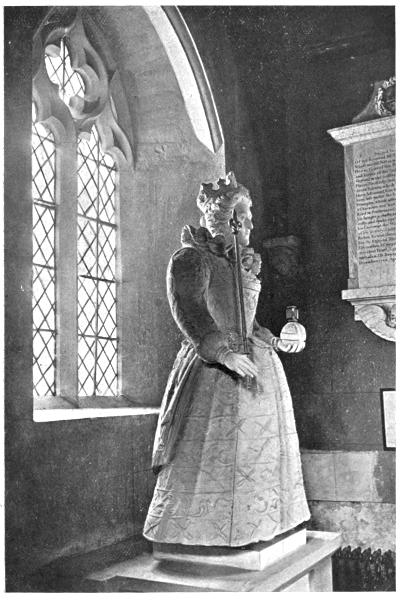
STATUE OF QUEEN ELIZABETH, CUMNOR CHURCH.
Upon the decay of Cumnor Place the statue was removed to Dean Court, and thence to a height above the village of Ferry Hinksey, in 1779. From that solitude it was taken to Wytham Abbey, and eventually forgotten; being found, broken to pieces, in an out-house. It was finally removed, restored, and[169] placed here, in Cumnor Church, in 1888, on a pedestal detailing these circumstances.
An unusual, and welcome, feature of this church is the series of engravings, reproductions of seventeenth-century correspondence, and notes upon the history of the village, for the information of the cultured visitor. Here you may read something of the grim associations of the vanished Cumnor Place, and learn, in a chronological table drawn up by the vicar, to what tune the centuries have jogged along in this rural parish. That chronology ends with this remarkable thought, this astonishing intellectual effort: “1893. The Future is not yet!”
It never is.
Brasses, now placed upon the walls, commemorate the virtues and the benefactions of various persons, including “Katherin, sometyme the wyffe of Henry Staverton, who dyed a good Christian the xxvth day of December in ye yere of our lorde God, 1557.” It is perhaps even more important to have lived a good Christian; but, apart from such counsel of perfection, the inscription is a significant change from those piteous pre-Reformation invocations for mercy, and appeals for prayers, that were the commonplaces of all monumental inscriptions only a few years earlier.
James Welsh, who died in 1612, and Margery, who departed three years later, each leaving £5 in charity, are celebrated in verse, beginning:
In the south transept, dedicated to St. Thomas[170] of Canterbury, lie two Abbots of Abingdon, one of them probably William de Comenore, who died in 1333. Latest of all the monuments here is that of Sir William Wilson Hunter, an Indian official, who died in 1900, aged 59.
But the chief interest centres in the fine canopied tomb of grey marble, on the north side of the chancel, to Anthony Forster and his wife: Forster, that “Tony Fire-the-Faggot” of Sir Walter Scott’s unhistorical “historical” romance of Kenilworth, in which he is held up to execration as a villain of the most varied villanies; a time-server and hypocrite: “Here you, Tony Fire-the-Faggot, papist, puritan, hypocrite, miser, profligate, devil, compounded of all men’s sins, bow down and reverence him who has brought into thy house the very mammon thou worshippest.”
This horrid portraiture of the man is an overdrawn picture. No need to paint the devil blacker than he really is; and although the evidence available tends to attach the stigma of “murderer” to him, it does not by any means follow that he practised all the meannesses and petty vices with which he is charged.
On the other hand, those whitewashers of smirched reputations who have long been so actively and unprofitably employed in cleansing historical characters under a cloud, have overstepped the mark in loudly declaring their belief in his innocence of all charges brought against him.
The name of Anthony Forster, in fiction and in fact, is closely connected with the famous tragedy[171] of Cumnor Place and Amy Robsart, which still, after three hundred and fifty years, exercises the minds of historians, and arouses controversies; and seems likely ever to do so.
We have already referred to the house as a grange belonging to the Abbots of Abingdon. It came into the private possession of Thomas Pentecost, alias Rowland, the last of them, by deed of gift from Henry the Eighth in 1538. The Abbot, in consideration of his having peaceably and willingly surrendered the Abbey and all its belongings to the King, was given Cumnor Place for his life; but as he died the following year, he derived little benefit from the compact. Seven years later, October 8th, 1546, the King conferred Cumnor Place, with the manor of Cumnor, and greater tithes, upon his physician, George Owen, in consideration of some lands at Oxford, including the site of Rewley Abbey; and a cash payment of £310 12s. 9d. William Owen, son of this George, married in 1558 one of the Fettiplace family, his father then settling upon him the Cumnor property. William Owen, however, elected to live elsewhere, and let Cumnor Place to Anthony Forster.
Who, then, was this Anthony Forster? He was the friend and factor of a very great man in those times: a man by no means great from force of character, but from sheer opportunism, good luck, and the favour of a comely person: none other, indeed, than Lord Robert Dudley, later to become, by the ennobling hands of Queen Elizabeth, Earl of Leicester. Around the reputation of Dudley there lurk too many sinister stories for us to lightly dismiss any charge[172] brought against him or his agents. He was suspected of having put many persons away by the means of poison: a method very fashionable in that age of the Renaissance and widespread neo-pagan culture; and that he was an ambitious man to whose ambition no bounds of prudence or conscience were set is generally acknowledged by historians. He was by no means alone in this, but was typical of his age, an age great in refinements, culture, and wealth; great in arms, and no less notable in its tortuous policies, national and domestic; and in its lies and manifold duplicities.
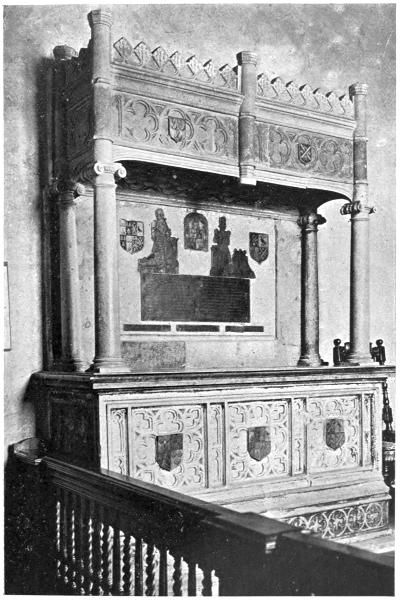
TOMB OF ANTHONY FORSTER, CUMNOR.
The early prospects of Lord Robert Dudley, as third son of the Duke of Northumberland, were perhaps not particularly brilliant, and as a young man of eighteen or nineteen years he had in 1550 married Amy, daughter and heiress of Sir John Robsart, of Stanfield Hall, Norfolk. That was in the reign of Edward the Sixth, the young King himself being present at the wedding. There is no reason against the assumption that this was a love-match; but there is every reason to assume that in after-years, when his ambitions were kindled, it was bitterly regretted by Dudley, who, in the changes that had befallen with the successive deaths of Edward the Sixth and of Queen Mary, and with the accession of Queen Elizabeth, had become not only a courtier, but a royal favourite, looked upon with amorous glances by that great Queen herself, whose subtle character has defied the analysis of historians. Queen Elizabeth’s lovers, looked upon with favour, were not few, but Dudley was pre-eminent among them,[175] and presumed, and was allowed to presume, more than any others. The Queen continually enriched him with grants of land and with the monopoly of the export of wool and other commodities, until he became extraordinarily wealthy, and able to maintain a magnificence remarkable even for that period. The loves of Dudley and his Queen afforded gossip for not only the Court, but for the nation at large, and a forthcoming marriage was looked upon as so sure a thing that the Spanish Ambassador found it possible to write home to his sovereign, referring to Dudley as “the King that is to be.” And all this while, we are to bear in mind, Dudley’s wife, Lady Robert Dudley (the “Amy Robsart” of the looming tragedy) was alive! What was that meek woman doing while such well-founded gossip was heard in every corner of the land? She was travelling and visiting in many different parts of the country, and doing so in considerable state.
Among the relics of her to be seen, framed on the walls of Cumnor Church, is the facsimile of a letter from her to her husband, dated 1557, displaying nothing but perfect confidence and trust, which she might do, well enough, and yet find her trust misplaced. Or, possibly, those letters were cast in a conventional form, and hid a breaking heart.
But, although Dudley and his wife had for some years lived apart, and although he was notoriously a false and faithless man, whose varied gallantries were the talk of the time, there was not yet, in 1557, any question of getting rid of her, and no great and dazzling ambition made him or his agents contemplate[176] a crime. Queen Mary yet ruled and it was not until the following year that she died, and was succeeded by her sister, Elizabeth. No sooner, however, did Elizabeth become Queen than Dudley appeared as the most favoured courtier. That he was to become King-Consort none doubted, and it is singular to consider that, in all the records of that time, the fact of his being already married appeared to offer no bar to that contemplated union. Continuously, from the Queen’s accession, these circumstantial rumours spread, and it is beyond the bounds of credibility that Lady Dudley should not have been made perfectly well acquainted with them in the course of the two years in which they were current. Lady Dudley—why historians and others continue to write of her after her marriage by her maiden name of Amy Robsart is not clear—had been accustomed to visit a Mr. Hyde, a kinsman of Dudley’s, at Denchworth, near Abingdon; and it does not, therefore, appear extraordinary that when Anthony Forster, her husband’s steward, took Cumnor Place on lease, in 1559, she should elect to visit there: the more especially so if there were any truth in the rumour that she was ill at that time, for Cumnor, as we have already seen, was supposed to be a particularly healthy spot.
But it is by no means so sure that she was at all unwell. It is one of the most damning evidences of foul play in this famous case that rumours were current for some time before the murder, or the accident, whichever it was, to the effect that she was suffering from cancer and was sure to die shortly,[177] and that this gossip was contradicted at the time. Among those who gave the lie to it was the Spanish Ambassador, writing to the Duchess of Parma. “They,” he said, “are thinking of destroying Lord Robert’s wife.” Who “they” were we can only conjecture. “They have given out that she is ill; but she is not ill at all; she is very well, and is taking care not to be poisoned.”
Is it at all reconcilable with the theory of accident that a person whose continued existence stood in the way of so ambitious a man as Dudley, and of whom it was so freely said that she was dying, when she was known to be well, and whose life was said to be in danger from violence or poison, should in fact meet her end so immediately and mysteriously? No modern coroner’s jury would return a verdict of accidental death under such suspicious circumstances.
What are the known facts? Lady Dudley was residing at Cumnor Place in September 1560, and the extraordinary cloud of suggestions, innuendoes, and suspicions current everywhere must have reached her ears. She must have been superhuman not to have been miserably affected by these doings of her husband, who, at the time when the tragedy happened, was with the Queen at Windsor; and she was, as we have seen suggested, probably in fear of being secretly poisoned. On Sunday, September 8th, the day of Abingdon Fair, her servants all went to Abingdon, by her express desire, according to one account. But, at any rate, they did all go, leaving in the house alone, it would seem, Lady Dudley,[178] Mrs. Hyde, and Mrs. Odingsell, Mr. Hyde’s sister. The three ladies were that evening playing a game popular at that time, known as “tables,” when suddenly Lady Dudley arose and left the room, being almost immediately afterwards found dead at the foot of a staircase by the servants returning from the Fair; having apparently fallen and broken her neck.
Where was Forster at this time? The records are silent, and do not tell of any man about the place. The views of Dudley himself and his dependents were that the affair was purely an accident. Alternatively, it was suggested by some that it was suicide.
But Dudley’s conduct on receipt of vague news of tragedy at Cumnor was suspicious. It would be supposed that the first act of an innocent man would be to hurry off from Windsor to the scene of this happening, to learn at first hand what had befallen his wife; but Dudley was content to send Sir Thomas Blount, a confidential gentleman in his train, to ride over and make inquiries. On the way Blount met a messenger from Cumnor, proceeding to Windsor with the detailed news. Next day, at Cumnor, Blount, examining the lady’s maid, extracted from her the admission that Lady Dudley had been frequently heard to pray for delivery from desperation. He eagerly seized upon this as indicating suicide, but the maid immediately checked him with, “No, good Mr. Blount, do not so judge of my words. If you should so gather, I should be sorry I said so much.”
What “desperation” might mean is uncertain:[179] it is a strange choice of a word; but it has been thought that the unhappy woman, knowing she was in danger of being murdered, thus prayed to be protected from the desperate resolves against her life.
Blount, writing to Dudley, acquainted him with the feelings of the neighbourhood about the affair, by which it is sufficiently evident that this happening was already regarded as a serious thing for Dudley. To this Dudley replied, directing that the strictest inquiry should be made; that an inquest should be held immediately, and “the discreetest and most substantial men should be chosen for the jury.” But surely, the question of an inquest and the choice of a jury were the affairs of others than himself, and an inquest would have been held in any case, whether he liked it or not; and so his directions to that end are mere unmeaning words. He further begged of Blount “as he loved him and desired his quietness, to use all devices and means for learning of the truth without respect to living persons”; and especially desired him not to dissemble, but to tell him, faithfully, “whether it happened by evil chance, or villainy.”
He was evidently seriously alarmed for himself; but we look in vain for any expression of sorrow at his wife’s lamentable end. All he was concerned with was “the talk which the wicked world will use”: talk for which his own conduct for long past had given the fullest occasion.
Blount had halted at Abingdon on his journey, and only reached Cumnor on September 11th. Already, as might have been supposed, the coroner[180] had summoned his jury. They were, in Blount’s opinion, “as wise and able men, being but countrymen, as ever I saw.” They deliberated long and searchingly, and Blount wrote again, on the 13th, that they were very active; “whether equity is the cause, or malice [i.e. suspicion, let us note] against Forster, I know not.” He further said that they were very secret, but he could not hear that they had found any presumption of evil. He thought, however, they would be sorry (these wise and able men—for countrymen) if they failed. Obviously Blount had been trying to pump the jury as to their finding. Dudley himself, writing to Blount, said the foreman of the jury had communicated with him to the effect that although the inquiry was not yet concluded, for anything they could learn to the contrary, it was a very misfortune. So Dudley himself had been trafficking with the jury, a thing that would in modern times afford very strong presumption of guilt.
If we put faith in Dudley’s own protestations, we must, however, find him innocent. Yet is it possible to have this faith?
After hearing to that effect from the foreman he wrote to Blount, saying that after the jury had rendered their verdict, he could only wish there would be a second inquiry. He wished Arthur Robsart, the dead woman’s brother, and Appleyard, her half-brother, to be present. Never at any time, in all these scenes, was Dudley himself present. It is uncertain whether a second jury was summoned, or whether the sittings of the first were extended;[181] but it is certain that an inquiry was still in progress on September 27th, and that this resulted at last in a verdict of accidental death.
But the affair cast an indelible stain upon Dudley’s reputation, and although the question of his marrying the Queen was not dropped, and was ardently debated from time to time, his wife, being dead, proved a more insuperable obstacle than she had been while living. The dark suspicions, if not of his actual complicity, at least of Forster’s having contrived the tragedy in his master’s supposed interest, would not be allayed. Everywhere mutterings were heard, and the Queen did not dare marry one under such a cloud.
Lady Dudley was buried in great state in the church of St. Mary, Oxford, and even there the grisly accusation of assassination came up, in Dr. Babington, the preacher, chaplain to Dudley himself, thrice making a slip of the tongue; desiring the prayers of the congregation for the lady “so pitifully murdered,” instead of “slain.” This incident serves sufficiently to show what was in men’s minds.
In 1566, seven years after the tragedy, Appleyard was brought before the Privy Council for having declared that he had not been satisfied with the jury’s verdict, but for Dudley’s sake had covered the murder of his sister. He was intimidated, and fully apologised, for Dudley had become all-powerful; and he was made to explain his words as “malice,” and to beg pardon for them; but an apology extracted by such means does not carry great weight. Years[182] afterwards Cecil could find it possible to say that Dudley was “infamed by his wife’s death,” and so infamed he still remains, whether we find it by direct participation or by the deeds of his too-subservient agents.
We must here come to the conclusion that Dudley was not himself guilty; but that Forster certainly was. That conclusion can, indeed, hardly be avoided. The country side thought so, and it is not sufficient for apologists to point to his gentility and his culture, and to exclaim that such an one would be incapable of such a crime. Whenever did honourable descent or cultivated tastes prevent a man from bearing a villain’s part? The view that because Forster was a gentleman, and interested in the arts, he was incapable of crime is the conventional view of people who are not satisfied that a villain is a villain unless he wears a scowl and other distinguishing signs.
It has been remarked that Forster would not in after-years have been chosen Member of Parliament for Abingdon and would not have been given University and other honours if he had been what suspicion made him. But would he not? Dudley could have procured all these things, and more, for his faithful man, even as he was in a position to secure most things for himself.
The year following the tragedy of Cumnor Place, Forster purchased the freehold of it; Owen probably being unwilling any longer to hold a house with such dark associations. And here he lived the remainder of his life, dying in 1572. In those twelve years he almost wholly rebuilt Cumnor Place, which he left[183] by will to Dudley, who had, in the meanwhile, become Earl of Leicester. If the Earl accepted this gift, he was to pay £1,200 to Forster’s heirs.
The Earl did accept, but sold the property soon after. It is not to be supposed that he would care to be any longer associated with the ill-omened place. By this sale Cumnor passed to the Norris family, ancestors of the Earls of Abingdon, who still own it.
The entry of Forster’s funeral at Cumnor is to the effect that “A. F., gentleman,” was buried on November 10th; and it has been thought curious that the word “gentleman” takes the place of some other word first written and then erased: whether the first was uncomplimentary, or merely the Latin word miles, as sometimes suggested, is now of course beyond the wit of man to discover.
Those who visit Cumnor with this pitiful story in their recollection, and are disappointed at finding Cumnor Place no longer in existence, will find in the Purbeck marble monument to Forster an interesting relic, bringing them into touch with these long-vanished personages; but they will find no support of the charges brought against him. Nor could such support be in any way expected; but in the long Latin eulogistic verses engraved in brass under the brass effigies of himself, his wife, and their three children, we find him credited with an astonishing variety of virtues and accomplishments. He was, it seems, distinguished for his skill in music, languages, and horticulture, and was charitable, benevolent, and full of religious faith. The brass portraiture,[184] too (which, after all, is not necessarily a portrait), represents him as a man of singularly open countenance.
Apart from the personal association, the tomb is interesting as combining late Gothic and Renaissance decoration.
It has already been said that Cumnor Place is a mansion of the past, and that it was finally demolished by a former Earl of Abingdon in 1811. An amusing story is told, to the effect that when the popularity of Scott’s Kenilworth aroused a keen interest in Cumnor, the Earl undertook to drive some guests over to see the house, forgetting that he had, several years earlier, given orders for it to be demolished. The disappointment of himself and his friends on arriving at Cumnor was very keen.
Cumnor Place was never more than a modest country residence, and bore no resemblance to Scott’s description; nor had it the imposing towers described in Mickle’s ballad, which concludes with—
It stood to the south of the church, and was in its last years a ruinous malthouse, finally converted into labourers’ cottages. The stones of it were removed chiefly for the building of Wytham church; and there, at the entrance to the churchyard, an archway remains to this day, bearing the inscription by the pietistic Forster: “Verbum Domini Janva vitae.”
It only remains to once more remark that Scott’s novel, Kenilworth, enshrining many of these things, is full of the grossest perversions of known facts, and not for one moment to be relied upon, historically. Raleigh figures in it, and in its pages is knighted by Queen Elizabeth, in 1560; but he was only eight years of age at the time. Lady Dudley is represented as the Countess of Leicester; but she met her tragic end three years before Dudley was created Earl. She is also made to figure in the grand festivities at Kenilworth, although she had been dead fifteen years when these great doings took place. There was no “Black Bear” inn at Cumnor at that time; nor could there reasonably have been such a sign, for Dudley, whose device it was, did not then own property at Cumnor, and was not directly associated with the village. The Richard Varney, co-villain with Forster in the story, was derived by Scott from Ashmole’s gossipy Antiquities of Berkshire, and is not to be readily identified.
WYTHAM—THE OLD ROAD—BINSEY AND THE ORATORY OF ST. FRIDESWIDE—THE VANISHED VILLAGE OF SEACOURT—GODSTOW AND “FAIR ROSAMOND”—MEDLEY—FOLLY BRIDGE.
The river makes a great semicircular bend, as between New Bridge and Oxford, so that although but six miles between the two, measured in a straight line on the map, it is fifteen miles by water. Cumnor stands roughly in the middle of the projecting part of Berkshire enclosed within this bend, and Wytham almost at the farthest northward fling of it, just below where Eynsham Bridge (otherwise styled Swinford Bridge) carries the great highway from Oxford across the Thames towards Witney and Gloucester. Eynsham, a quaint old village, is one mile distant.
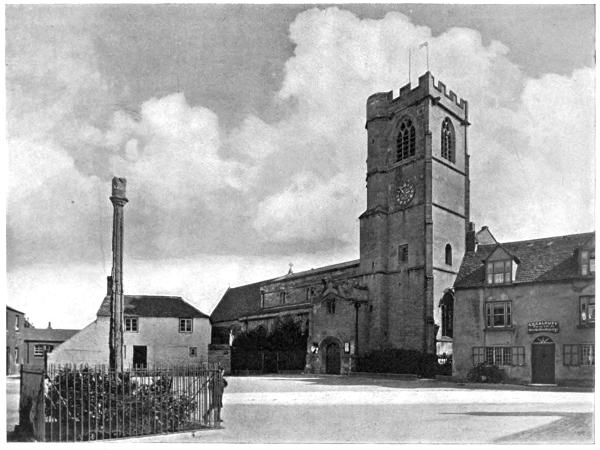
EYNSHAM.
Wytham, amid the deep woodlands, on its bold hill-top in the bight of the river, is a sequestered place, the site of the mansion called Wytham Abbey, seat of the Earls of Abingdon. “Abbey” is a fanciful term, as applied here, for no religious house ever stood upon the site, and the existing buildings arose in the sixteenth century, at the bidding of one of the Harcourts, who then owned the property. How it eventually came through several hands and at last[189] by marriage into the Bertie family, Earls of Abingdon, is not, I imagine, a matter of general interest. Wytham village, lying beneath that lordly seat, is one of the most charming villages in Berkshire, which is saying a good deal in the commendatory sort. It is, and has long been, famed for its strawberry-growing, and was once even recommended by the faculty to invalids for a “strawberry cure.” I cannot imagine the ailment for which the eating of strawberries is a likely remedy, but a pleasanter “cure” could hardly be invented.
Wytham woods crest Beacon Hill, and in them the pheasants are plentiful. This is the equivalent of saying that there is no right of way. But anciently the road from Oxford to Eynsham, and on to Witney and Gloucester, ran across this hill: a plaguey bad road, a very beast of a road. The track of it may still be followed (by permission sought and obtained from Lord Abingdon, let me hasten to add) steeply and roughly up through these sylvan surroundings, and as roughly and as steeply down again, to Eynsham Bridge, which was built in 1799 by a former Earl, to replace the ford by which all wayfarers up to that time were obliged to cross the river. It is still a toll-bridge for vehicles, levying the modest sum of one halfpenny for cycles, and sixpence for motor-cars. The arduous road from Oxford across the hill was abandoned about the same time, when the existing so-called “Seven Bridges Road,” leading along the levels to Eynsham Bridge, was reconstructed.
There is a great deal of interest wrapped up in[190] that old road. It left Oxford on much the same line as now, but was neither drained nor embanked, and proceeded for some distance from the city along swampy ground, so that travellers upon it from Oxford to Eynsham were made to feed full of varied discomforts. Proceeding through Botley, often at the peril of their lives from floods, they then bore away to the right, for Wytham, passing through the village of Seacourt on the way. From Wytham, mounting and descending the hazardous track over Beacon Hill, at the imminent danger of their necks, they then came to the peril of the ford; and having haply passed over this in safety, felt that risks from natural causes were over. There remained only the bandits of an early period, and the highwaymen of a later to give them pause. As for Binsey, it is merely an insignificant hamlet situated at a very dead-end of traffic. You shall find it readily enough by proceeding from the “Perch” inn, beside the river, just above Medley Weir; but it is quite other guesswork seeking it from Wytham, for no way exists where formerly an ancient path ran, and a channel cut from the Thames winds a prohibitive course through the flat meadows.
Binsey, indeed, stands on an island in olden times called Thorney, where St. Frideswide, that celebrated Oxford saint, first built her oratory, the name of the isle being then, we are told, changed to “Binsey”: absurdly said to signify the “isle of prayer.” Here she also founded the well of St. Margaret, miraculously springing forth in answer to her prayer, as springs were wont to do in the eighth[191] century. They have long since refused to do the like. It is perhaps not remarkable that Binsey and this famous well in after-years became, and long remained, the objects of pilgrimage. The halt and the lame, the epileptic and the otherwise afflicted, flocked to Binsey and were cured, hanging up their crutches in the oratory and festooning it with their discarded bandages: and incidentally leaving solid gifts of money behind, greatly to the gain of the monastery of St. Frideswide, in Oxford, to which Binsey belonged from 1132 until the end of such things, four hundred years later.
The crowds of pilgrims who came out of Oxford, making for the oratory and well of St. Frideswide, turned off at the vanished village of Seacourt.
Few places have perished so utterly as this long-lost habitation of men, styled at various times “Sekecourt,” “Seuecurde,” and “Sechworth”; for all we shall now discover of it is a farm so named. But Seacourt was for many centuries a considerable place. Not only did it lie directly upon the then highway to the west, but it was the pilgrims’ lodging-place, and for the accommodation of such it is recorded to have possessed no fewer than twenty-four inns. With the successive blows of the dissolution of the monasteries, when pilgrimages ceased out of the land, and then when the road itself was diverted, Seacourt’s doom befel. It subsided into ruin, and became the abode of foxes and wild-fowl; and presently the very stones of it were carted away.
The self-satisfied attitude of Binsey folk in summer, and the woe-begone, dreary, flooded-out[192] experiences of the same people in winter are amusingly contrasted in traditional sayings, current in these parts. Thus, in summer, a villager, asked where he lives, is supposed to say, “Binsey; where d’ye think?” but in winter he will reply, disconsolately, “Binsey, Lord help us!” And it needs only a week or so of rain in one of our tearful summers for the low-lying meadows to be flooded, completely islanding the place in the midst of something resembling an inland sea.
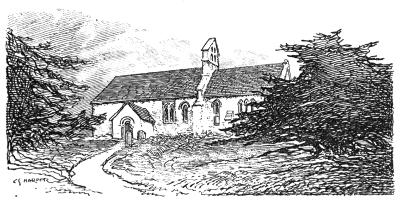
BINSEY CHURCH.
In modern times the holy well has been found at the west end of Binsey church and restored, as the inscription records: “St. Margaret’s spring, granted, as it is told us, to the prayers of St. Frideswide, long polluted and choked up, was restored to use by T. J. Prout, student of Christ Church, the vicar, in the year of redemption, 1874.” The well may be holy, but the water again in these days looks provocative of typhoid.
Between Wytham and Binsey, and directly upon[193] the river, is a very much better known place than either; to wit, Godstow. “Fair Rosamond” and Godstow have employed the morbidly-sentimental pens of uncounted scribblers. It is easy to be either sentimental or morbid, and of the easiest to be morbidly-sentimental over unworthy subjects: hence the exploitation in this wise of “Fair Rosamond.”
Godstow Nunnery, it seems, was founded by Edith, an ex-chère amie of Henry the First, and wife of the second Robert D’Oilgi, or D’Oyley, lord of Oxford. The buildings were consecrated with great state by the Bishop of Lincoln in 1138. There is little need here to dwell upon the history of the nunnery, which in general is sufficiently dull; and Godstow is, in fact, interesting only on account of that highly improper person known in romantic history as “Fair Rosamond,” who was educated here. The name of Rosamond, if we may believe Dryden, who, as a poet, is perhaps not to be altogether relied upon as an authority, was really Jane. It might have been worse. However:
That she was daughter of Walter, Baron Clifford, of Hay, in Wales, is historically certain; but much else relating to her is merely picturesque legend. She appears to have been born about 1150, and was educated in this then newly-built nunnery. Here, in some unexplained way, she attracted the attention of the King, Henry the Second, and became his mistress, greatly to the jealous rage of his Queen,[194] Eleanor of Poitou, the divorced consort of the King of France, who by many was held to be no better. This association of the King and of Rosamond seems to have lasted about four years.
Legends tell variously how Queen Eleanor burst in upon a secret bower in which the King had hidden her at Woodstock, and gave her the choice of death by dagger or poison, and how she chose the bowl rather than the steel, drank of it and so died; but these are unhistorical. All that seems fairly certain is that a break in her relations with Henry occurred, and that she retired to Godstow and died there, some four years later, about 1176.
A great mass of legend has accumulated around these bare outlines of her story, and poets have freely employed their imagination upon her. With remarkable unanimity, they assume Rosamond to have been a blonde:
That she had two children seems to be established, but that they were, as often stated, William Longsword, Earl of Salisbury, and Geoffrey, Archbishop of York, has been disputed.
Rosamond, we are told, was for sake of her wit and beauty received back by the nuns of Godstow with alacrity. Doubtless she told them many strange tales of the wicked world, for who better qualified to[195] know? Her body was buried before the high altar. King John, according to Lambarde, raised a gorgeous monument to her, inscribed,
Speed paraphrased this as follows:
A few years later, Hugh, Bishop of Lincoln, paying a round of pastoral visits in his diocese, in which Oxford was then included, coming to Godstow, saw this gorgeous monument and asked what great and good person it was, then, who lay here. It was, said the nuns, the tomb of Rosamond, sometime mistress of Henry the Second, who for love of her had done much good to that church. Thereupon the saintly and scandalised Bishop declared that the “hearse of a harlot was not a fit spectacle for a quire of virgins to contemplate, nor was the front of God’s altar a proper station for it”; and he directed that she should be removed and buried outside, “lest Christian religion should grow in contempt.”
Leland, diligent antiquary, tells us that in after-years Rosamond’s tomb was here, inscribed “Tumba Rosamundæ,” and that her bones had been found, enclosed in lead, “and within that closed in leather; when it was opened there was a very swete smell came out of it.” Time thus gave the lie to that fearful old epitaph of King John’s day.
The nunnery of Godstow when dissolved in the[196] reign of Henry the Eighth contained eighteen nuns, and its annual income was £274; a considerable sum as prices then ruled. The property was granted to that Dr. Owen who at the same time secured Cumnor, and the domestic buildings became a secular residence. This was held during the Civil War by Colonel Walter, and was taken by Fairfax in May 1646, and burned.
All we see nowadays of Godstow nunnery is a small building, ruined and roofless, apparently of no very great antiquity, for besides the Perpendicular window there are no other evidences of Gothic architecture, the two other windows being merely flat-headed Elizabethan insertions.
Efforts have been made from time to time to discover the remains of Rosamond. Two stone coffins were dug up about 1800, and in one of them were the bones of a young woman. On the supposition that this was the sarcophagus of Rosamond, a once well-known antiquary and citizen of Oxford, Alderman Fletcher, appropriated it, and conceived the eccentric idea of being buried therein; and when his time came, in 1826, he was accordingly laid in it, in the church of Yarnton, a few miles distant.
An uncommon plant, said to have been introduced from foreign parts by the nuns, still grows freely in these meadows by the grey ruins. It is known to botanists as Aristolochia clematitis, but to ordinary country folk as “birthwort” and was used in confinement cases. You may identify it by its heart-shaped leaf and bold yellow flower.
The charm of the river fades away after passing Medley Lock and nearing Oxford, and suffers a change[197] into the commercial ragged edges and untidy squalid purlieus of a great city.
We may read in old dry-as-dust authors how “Medley” derives from “Middleway”—this being midway between Godstow and Oxford—but we need not (indeed, we had better not) put any faith in that derivation. Also, according to those same authorities, it was a scene of great resort for “divers pleasures.” Of what those diversified pleasures chiefly consisted we must judge rather from the verses of George Withers than from the grudging phrase of Dryasdust, who, forgetful of his own youth, gives us no details. But let George Withers himself inform us:
Let nothing be said of the river between Medley and Folly Bridge. What should one say of gas-works in these pages, or of other evidences that we are not living in ancient times, and that the city of Oxford is a populous place, and up-to-date in all respects except that of its University?
Folly Bridge serves to mark the limits of the Upper and the Lower river, as well as its prime purpose of carrying the road to Abingdon across the stream; and it stands in the minds of many for the[198] enterprising and industrious Salter, whose steamboats and whose row-boats are centred thereby.
The real original name of Folly Bridge, dating back to Norman times, is “Grand Pont,” that is to say, Great Bridge; great according to the ideas of those times. Even so lately as 1844, when the first Great Western railway-station was opened near this point, the bridge was still well known by its old name, in addition to the other, for the station was called after it, “Grandpont”; but, in the years that have passed since then, the name of “Folly Bridge” alone has survived, and you might expend the whole of a day asking for it by its original style, and not find any one who knows it.
In the middle of the old bridge stood an ancient tower known traditionally as “Friar Bacon’s Study,” where that learned man had been accustomed to take astronomical observations. It straddled across the roadway and formed, in fact, one of the gateways of the city. A strange saying was current of this tower, to the effect that when a man of greater learning than Bacon passed under it, the tower would fall. It never did fall, but was pulled down by the city corporation, as an obstruction to the road, in 1779. Years before that date, it had been let to a person named Welcome, who not only repaired it, but built another storey. The citizens of Oxford then called it “Welcome’s Folly.”
The bridge was rebuilt between the years 1825 and 1827; but, although Welcome is forgotten, his supposed folly still, as we perceive, gives the place a name. There can be no doubt that, to many uninquiring[199] people, the name of the bridge seems to be a satire on the pleasure-seeking life of those so-called scholars, the University men, to whom boating and the “bumping” races are more than all the wisdom of the schools.
Below Folly Bridge begins that long line of glorified house-boats, headquarters of the various college boating-clubs, known as the “University Barges,” stationary along the left bank of the river, by Christ Church meadows. The ethics of bumping or being bumped, and the sporting politics of the Torpids or the Eights are subjects by themselves, and not to be discussed here.
What, strangers ask, are Torpids? The name suggests a boa-constrictor dined to repletion, and reduced to a state of torpidity; it is, however, merely the survival of an old Oxford nickname for the less active among boating men, who, roused by it, and adopting it, took to racing among themselves, as a separate class. The extinct “sloggers” on the river Cam at Cambridge, derived similarly, from the taunt of “slow-goer.”
The racecourse of these clubs is between Folly Bridge and Iffley: scenically a dull stretch of river, however exciting it may be from the aquatic sportsmen’s point of view. And if the river between Oxford and Iffley be dull, what shall we say of the road thither?
IFFLEY, AND THE WAY THITHER—NUNEHAM, IN STORM AND IN SUNSHINE
The way from Oxford by road to Iffley is a terrible two miles of “residential” suburbia. So soon as the pilgrim has come out of Oxford, over Magdalen Bridge, and, taking the right-hand fork of roads, has passed St. Clements, he has entered upon the villa-lined Iffley road, in which the houses are numbered to over nine hundred. I hope I am neither a Prig nor a Superior Person, but I fully confess I should not like to live—or to “reside,” if you will have it so—in a house numbered well on into the hundreds. I do not, broadly speaking, envy our grandfathers of sixty or seventy years ago, for they are dead and we are among the living, but they had at least this advantage, among, of course, many serious disadvantages that we fortunately do not experience—that their towns (always excepting London) had no suburbs. Our ancestors of not so very long ago stepped out of their ancient streets and found themselves at once in the country. We have, commonly, at the threshold of every town, miles of undistinguished modern streets, commonplace, unhistorical, depressing. But, at any rate, there are no tramways, electric or other, along the Iffley road, and that is something to be thankful for, viewed from the æsthetic standpoint, although it may leave something to be desired on the score of convenience.
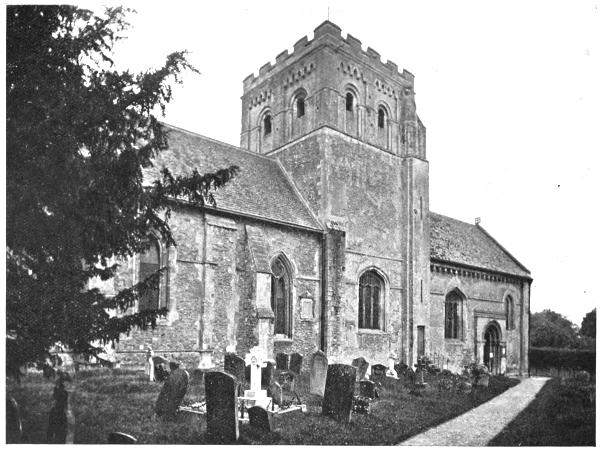
IFFLEY CHURCH: NORTH SIDE.
The best way to reach Iffley is undoubtedly by water. The Thames, from Folly Bridge to Iffley Lock, is not, it is true, at its best, but it, at any rate, retains something of the genius of locality, which a suburban road does not, and anything should be preferable to that road.
But, alas! Iffley Mill, once the glory of the river at this point, is at the moment of writing, a blackened heap of ruins, and it is not expected that it will be rebuilt. Even if it be, that will not be the Iffley Mill beloved of artists these many generations past. Thus ends the old manorial mill that has existed, in one form or another, on this spot, since the Norman conquest, and probably earlier still, for the place is mentioned in Anglo-Saxon charters dated 945 A.D., in which it is styled “Giftelei.” It is said that “Iffley” has been spelled in eighty different ways, and Iffley Mill has probably been sketched, painted, and photographed as many thousand times; and, that being so, we will leave the mill, for once, unillustrated.
Enthusiastic local writers have often claimed for Iffley church that it is the finest Norman country parish church in England. It is not really quite that, but it is certainly among the finest. It is a large building, of late Norman architecture, built about 1170, when the gaunt, grim early Norman style had developed into something which, although[204] not less massive, was more ornate and decorative. It is a church without aisles. The West front is imposing, and particularly rich, exhibiting a deeply-recessed door, with circular window above, and three windows above that. The circular window is a restoration, of some fifty years ago, of the original, destroyed in the eighteenth century and replaced by a larger, with the object, sufficiently laudable in itself, but archæologically lamentable, of admitting more light. The highly-enriched doorway, with characteristic beak, cable, and chevron devices, is protected by a bold hood-mould, finely sculptured with the signs of the zodiac. The low, square central tower is unaltered, but most of the windows in the body of the church have been remodelled at different periods in the long history of Gothic architecture. The chancel, originally apsidal, was lengthened about 1270, in the Early English style. The chancel-arch is curiously carved, and the roof is massively groined in stone. The ancient black marble font is as old as the building itself, and may be compared with a somewhat similar, but more elaborate, series in Winchester Cathedral, East Meon church, and St. Michael’s, Southampton. On the north side of Iffley church is an enormous, widespreading yew, probably as old as the church itself, and still healthy. Beside it stands a restored churchyard cross.
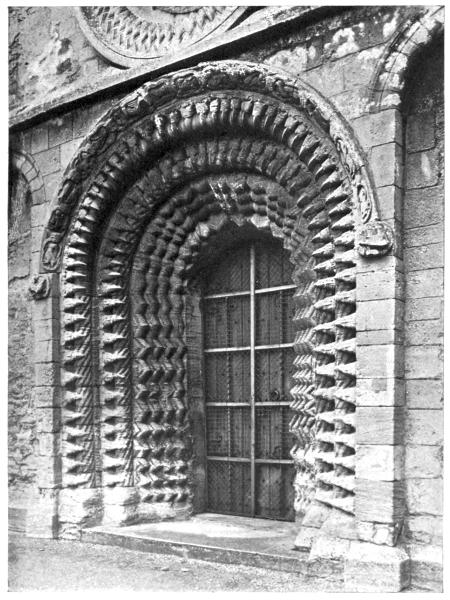
WEST DOOR, IFFLEY CHURCH.
Among the deprived ministers at the time of the Commonwealth was Charles Forbench, vicar of Iffley, who was imprisoned for persisting in reading the Book of Common Prayer when its[207] use was forbidden by the Parliament. “If,” said he, “I must not read it, I am resolved I will say it by heart, in spite of all the rogues in England.” This was a very fine spirit of resistance against tyranny, and we must all resist tyranny, from whatsoever quarter it proceeds; but it may otherwise be doubted if the Book of Common Prayer is, or ever was, worth fighting for, or whether prayers said by rote—which is really what Forbench meant when he said “by heart”—are the kind of supplications that win to the Throne of Grace. For my own part, had I been one of those Parliamentary Commissioners, I suspect I would have made Forbench take a meal off the Book of Common Prayer, as he was so fond of it; but it would not be a very nourishing meal, physically, or spiritually I take leave to say.
Nuneham—every one knows Nuneham; for, by favour of the Harcourts, who own the place, it has for many years past been a popular spot for rustic teas. I raise my hat, or cap, as the case may be, to the Harcourts, past and present—to the memory of Sir William, that doughty political protagonist, and voluminous letter-writer to The Times over the signature of “Historicus,” who, although quite capable of leading a party, chose to be merely the trusty lieutenant of the windiest political wind-bag of any and every age; and to the present Mr. Lewis Harcourt, for the access they have permitted, and still extend, to their lovely domain. Every one, I say, knows Nuneham, for does not Salter, who runs his comfortable steamboats between Oxford and[208] Richmond, drop passengers here, on the banks, and does he not call and pick them up again at the close of the day, conveying them from Oxford and back at the cost of one shilling? Yea; thousands have made that trip; and, given a fine day, there is, experto crede, not any trip more delightful. But if the day turn tearful, then Nuneham is the very last place to which any one who is not a fish or a duck would wish to go. Do I not know the misery of it at such times: the landing on the wet, clayey bank, under the trees of the glorious woods, which shed great spattering drops of rain on one; the half-mile walk, or rather, butter-slide, by the woodland track, to that picturesque thatched cottage in the lovely backwater, where the cottagers in fine weather supply open-air teas to these pilgrims, and in wet weather do the like; refusing, much to the said pilgrims’ disgust, to give them the much-needed shelter in their own dry and comfortable quarters; with the result that those unhappy persons grow cold and shivery and develop colds in their heads, and entertain savage thoughts of Nuneham? Truly, no more miserable experience is possible than that of sitting in one of the picturesquely-thatched arbours by the waterside, and dallying over a lukewarm tea, awaiting the hour for the up-river steamer’s arrival, while the moisture-laden wind comes searchingly in at the open front. And it does not make matters better to know that those disobliging cottagers are, all the while, crouching over their own roaring wood-log fires.
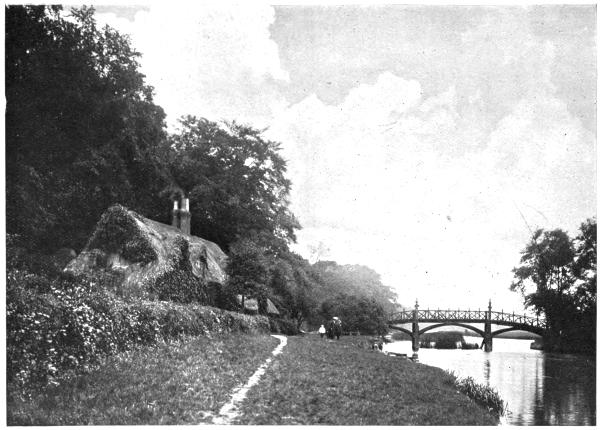
THE BRIDGE, NUNEHAM COURTNEY.
But let us dwell no longer upon these harrowing[211] experiences. It does not always rain at Nuneham—but only when we want to go there. Then it rains all day. But when the sun shines, Nuneham is the ideal place for an idle day, and those draughty arbours the most exquisite of nooks. From them you look out upon a river scene that closely resembles some stage “set.” The trees, right and left, or, to speak in stage conventional language—on Prompt and Off-prompt sides—hang in that almost impossibly picturesque way we expect in the first act of a melodrama of the old Adelphi or Drury Lane type. You know the kind of thing; or, if you do not, go to Nuneham and see it. Anyway, take my word for it that this is sheerly competitive with the stage. Beneath these trees, whose other side, you are quite convinced, is merely canvas and framework, are the usual conventional rocks, on one of which the villain will presently sit and gloat over the impending fall of the hero. And swans come lazily paddling up to the rush-fringed margin of the river; and, really, all you miss is the limelight.
But if this scene seems to have been bodily taken from the stage, the queer timber bridge that here crosses the backwater gives quite another aspect to the place. Looking upon it for the first time, it appears in the likeness of some old friend whom, for the moment, you cannot exactly place; and then at last you have it. It closely resembles that bridge on the time-honoured Willow-pattern Plate, with which Oriental china has long familiarised us. If only we had the pagoda to one side, and the queer little figures, carrying their yet more queer little[212] bundles, crossing it, the scene would be conventionally complete. To emphasise and properly accentuate these remarks, I include a view, taken by that amiable photographic friend and companion to whom the most of the pictures in this book are due. I have not dared to publish a view of the bridge looking upstream, for that and Iffley Mill are absolutely the two most hackneyed views of the river in existence. Instead, therefore, we are here looking downstream.
Nuneham is a curious combination of the ugly and the beautiful. The great mansion, ugliness incarnate, is surrounded by lovely and stately gardens, created about 1765 by the masterful Earl Harcourt, typical among the great landowners of that age. There is something not a little awesome about the megalomaniacal methods of those great ones of that period, who had such autocratic wills, so much money, and such unquestioned power. Earl Harcourt, in common with many others of his class and of his period, could not endure that the village and the church of Nuneham should be within sight of his windows, and so he abolished both, causing a new village to arise fringing the London road, and a new church, which stands as an indictment of the then prevailing want of taste, being in the likeness of a Greek temple, to be built in the woods at the back of the mansion. It is dated 1764. Here lies Sir William Harcourt, who died in 1904.
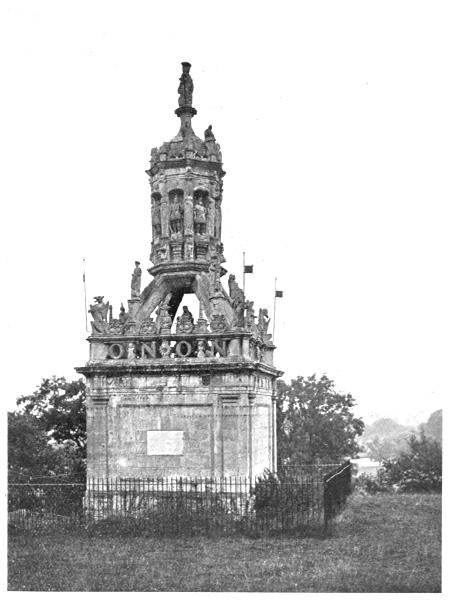
CARFAX CONDUIT, NUNEHAM COURTNEY.
I will not be so gross as to attempt a description of the loveliness of the natural beauties of Nuneham,[215] or of the views from it: only let it be said that the view from the grassy knoll on which stands the old Carfax conduit, brought from Oxford, is exquisite, commanding, as it does, distant peeps of Oxford in one direction, and of Abingdon in another, with lovely stretches of meadowlands, woods, and water, in between. There is, it may well be supposed, no more beautiful fountain in England than this old conduit from the four cross-roads in the centre of Oxford; but the expansion of population and the increase of traffic have ever banished the beautiful, and thus this fine Renascence building, given to the city of Oxford by Otho Nicholson in 1610, was, so early as 1787, removed as an inscription upon it states, “to enlarge the High Street.” The University, the inscription goes on to state, then presented it to George Simon, Earl Harcourt. If it were worth accepting, it certainly was also worth keeping, and that the University could thus give it away reflects no credit upon that body. The repetitive “O. N.” observed upon the conduit stands for the initials of Otho Nicholson.
ABINGDON
Abingdon, some three miles distant, now claims attention; and a good deal of leisured attention is its due. That pleasant and quietly-prosperous old town is one of those fortunate places that have achieved the happy middle course between growth and decay, and thus are not ringed about with squalid, unhistorical, modern additions. Its population remains at about 6,500, and therefore it is not, although possessing from of old a Mayor and Corporation, a town at all in the modern sense. Thus shall I shift to excuse myself for including it in these pages. In these days of great populations we can scarce begin to think of a place of fewer than ten thousand inhabitants, as a “town” at all.
The origin of Abingdon, whose very name is said to mean “the Abbey town,” was purely ecclesiastical, for it came into existence as a dependency of the great Abbey founded here in the seventh century. Legends, indeed, tell us of an earlier Abingdon, called “Leavechesham,” in early British times, and make it even then an important religious centre and a favourite residence of the kings of Wessex, but they—the legends and the kings alike—are of the vaguest.
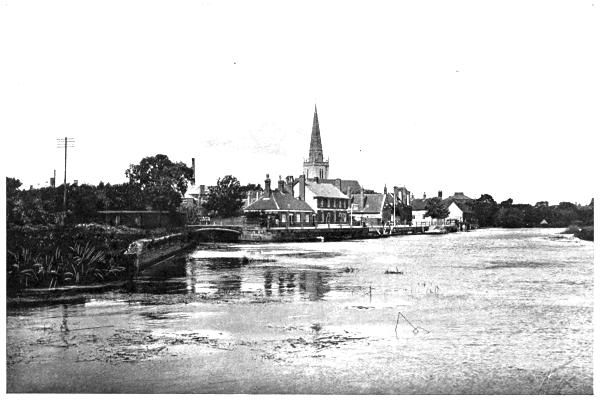
ABINGDON.
Leland, in the time of Henry the Eighth, wrote of the town: “It standeth by clothing,” and it did so in more than one sense, for it not only made cloth, but a great deal of traffic between London and Gloucester, Stroud, Cirencester, and other great West of England clothing centres, came this way, and had done so ever since the building of Abingdon (or Burford, i.e. Boroughford) bridge and the bridge at Culham Hithe in 1416, had opened a convenient route this way. The town owed little to the Abbey, for the proud mitred abbots, who here ruled one of the wealthiest religious houses in England, and sat in Parliament in respect of it, were not concerned with such common people as tradesfolk, and did not by any means encourage settlers. They trafficked only with the great, and aimed at keeping Abingdon select. From quite early times they had adopted this attitude: perhaps ever since William the Conqueror had entrusted to the monastery the education of his son Henry, afterwards Henry the First—an education so superior that, by reason of it, Henry the First lives in history as “Beauclerc.”
It was a highly-prosperous Abbey, and smelt to heaven with pride, and had a very bad reputation for tyrannical dealings with those who had managed to settle here. The Abbot refused to allow the people to establish a market, and in 1327 the enmity thus caused broke out into riot. From Oxford there came the Mayor and a number of scholars, to help the people of Abingdon in their quarrel, and part of the Abbey was burnt, its archives destroyed, and the monks driven out. But this was[220] a sorry, and merely a temporary, victory; for the Abbot procured powerful assistance and regained his place, and twelve of the rioters were hanged.
The scandalous arrogance and state of the Abbots of Abingdon aroused the wrath of Langland, a monk himself, but one of liberal views, who some few years later wrote that prophetic work, The Vision of Piers Plowman, in which the downfall of this great Abbey is directly and specifically foretold:
When the Abbey was suppressed in 1538, its annual income was £1,876 10s. 9d., equal to about £34,000, present value.
With the disappearance of the Abbey, the town of Abingdon grew, and continued to prosper by clothing and by agriculture until the opening of the railway era. When the Great Western Railway was originally planned, in 1833, it was intended to take it through Abingdon, instead of six miles south, as at present, and to make this, instead of Didcot, the junction for Oxford. But Abingdon was strongly opposed to the project, and procured the diversion of the line, and so it remains to this day an exceedingly awkward place to reach or to leave, by a[221] small branch railway. It has thus lost, commercially, to an incalculable degree, but in other ways—in the preservation of beauty and antiquity—has gained, equally beyond compute.
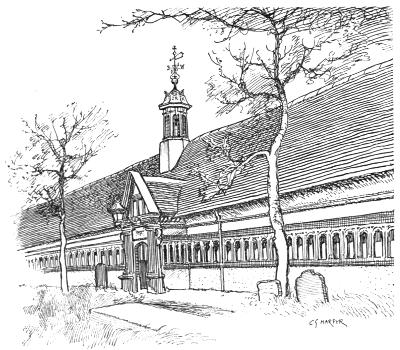
CHRIST’S HOSPITAL, ABINGDON.
An architect might find some stimulating ideas communicated to him by the quaint and refined detail observable in many of the old houses. There is, among other curious houses near the Market House, the “King’s Head and Bell,” in an odd classic convention.
Of the great Abbey church nothing is left. The townsfolk had such long-standing and bitter grievances[222] against the Abbey that they must have rejoiced exceedingly when the fat and lazy monks were at last cast out upon the world; and they seem to have revelled in destruction. The Abbey precincts are now largely built over; but, such as they are to-day, they may be found by proceeding out of the Market Place, past St. Nicholas’ church, and through the Abbey gateway, now used as part of the Town Hall, and restored, but once serving as a debtors’ prison.
Here a mutilated and greatly time-worn Early English building will be found, with a vaulted crypt, and two rooms above. To this has been given the (probably erroneous) name of the “Prior’s House.” Its curiously stout Early English chimney, with lancet-headed openings, under queer little gables, is a landmark not easily missed. The successor of the original Abbey Mill is itself very picturesque. Adjoining is the long, two-storeyed building often styled the “Infirmary,” and sometimes the “Guest House”; perhaps having partaken of both uses. It can only have been used for humble guests, or patients, for it is merely a rough-and-ready wooden building, rather barn-like, divided into dormitories.
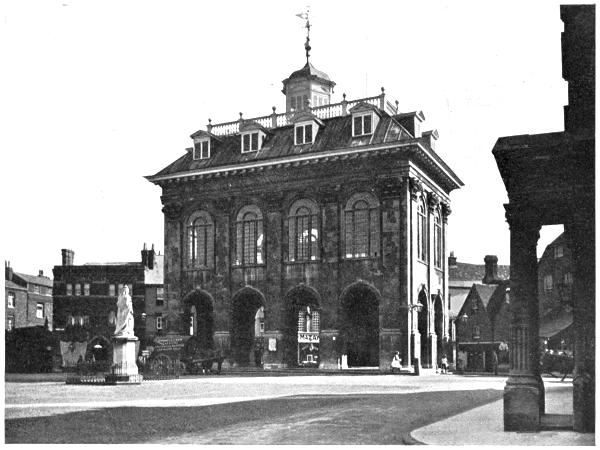
THE TOWN HALL, ABINGDON.
The charming little Norman and Perpendicular church of St. Nicholas has been very severely dealt with by “restoring” hands, but its quaintness and charm appear indestructible. An especially peculiar feature of the altogether unconventional West front is seen in the curious little flat-headed window under a gable roof to the north side of the tower, giving a curiously semi-domestic appearance[225] to the church. The windows light a staircase turret, which is perhaps the remaining part of some priest’s residence formerly attached to the church.
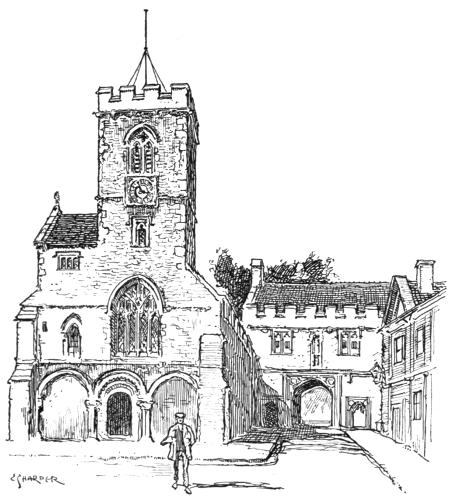
ST. NICHOLAS, ABINGDON.
But, far or near, the chief feature of Abingdon is St. Helen’s church, whose tall and graceful spire has the peculiar feature of being built in two quite distinctly different angles: the lower stage much less acute than the upper. It is what architects call an “entasis.” A band of ornament marks[226] the junction of the two stages. This spire is of the Perpendicular period, built upon an Early English tower. The rest of this exceptionally large and beautiful church, which has the peculiarity of being provided with a nave and four aisles, is Perpendicular. It should be noted that what are now the two extra aisles were originally built by the town guilds, as chapels. The five aisles form a noble vista, looking across the church. They are named, from north to south, Jesus Aisle, Our Lady’s, St. Helen’s, St. Catharine’s, and Holy Cross. The great breadth of the church originated a local saying, by which either of alternative courses of any action, supposed to have little to choose between them, may often be heard referred to as “That’s as broad as it’s long, like St. Helen’s church.”
Brasses and monuments of Abingdon’s old merchants and benefactors are numerous: among them this curious inscription to Richard Curtaine, 1643:
Here, too, is the tomb of John Roysse, citizen of London, and mercer, who founded here “Roysse’s Free School,” and died in 1571. The slab covering his tomb came from his London garden.
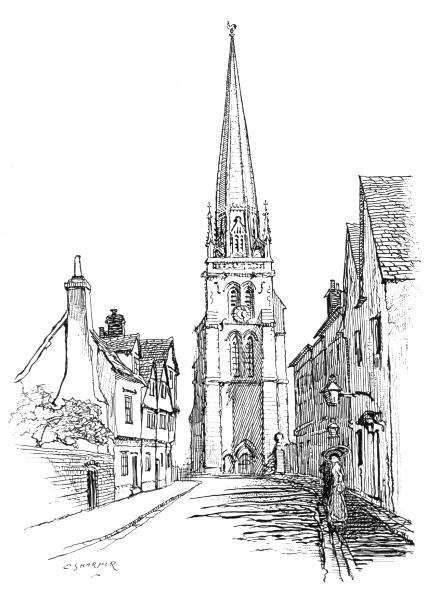
ST. HELEN’S, ABINGDON.
The town is singularly rich in old and interesting almshouses, the churchyard being enclosed on three sides by various charitable foundations of this kind. Of these the oldest and most remarkable is the[229] almshouse founded about 1442 by the Guild of Holy Cross, and refounded after the Reformation, in 1553, as Christ’s Hospital, by Sir John Mason, an Abingdon worthy who rose from the humblest beginnings to be Ambassador to the French Court, and Chancellor of the University of Oxford. The chief feature of Christ’s Hospital, as regards its front, is the long half-timber cloister, with no fewer than one hundred and sixty little openings in the woodwork, looking out to the churchyard. A picturesque porch projects midway, and from the steep roof rises a quaint lantern, crowned with cupola and vane. Old black-letter and other texts and paintings cover the walls of the cloister. Under the lantern is the hall, or council-chamber, an old-world room with a noble stone-mullioned bay window looking out upon the almshouse gardens in the rear. In this window are set forth the arms of benefactors towards the institution, and their portraits further adorn the walls, together with a curious contemporary account of the buildings of Abingdon and Culham Hithe bridges. As the value of endowments increased, so the buildings of Christ’s Hospital have been from time to time added to; and in addition there are Twitty’s and Tomkins’s almshouses. A gable-end of Christ’s Hospital abuts upon St. Helen’s Quay, on the river-side, with inscriptions curiously painted under protecting canopies: “God openeth His hand and filleth all things living with plenteousness; be we therefore followers of God as dear children. 1674”; and “If one of thy Brethren among you be poore within any of thy Gates in thy[230] land which the Lord God giveth thee, thou shalt not harden thy heart, nor shut thine hand from thy poor Brother. 1674.”
Abingdon is full of noble old buildings, both of a public and a private character, and prominent among them must be reckoned the imposing Market House. There is nothing else quite like it, in style or in dignity, in England, and it is not too much to say that it would, by itself, ennoble any town. It was built 1678-84, and followed in plan the old conventional lines of such buildings: i.e. an open, arcaded ground floor, supporting an upper storey; but in design it is one of the purest examples of revived classic architecture in the land. The upper storey in this case was intended for use as a sessions-house.
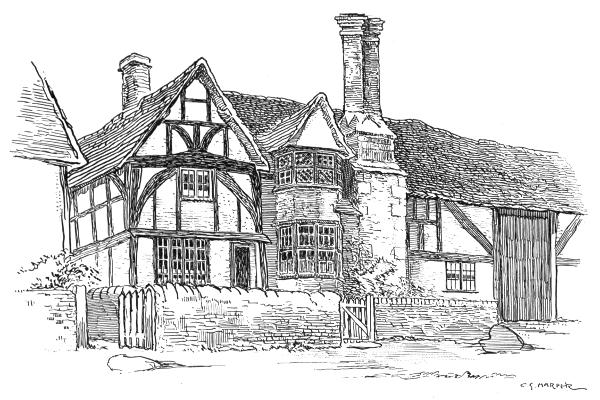
OLD HOUSES, STEVENTON CAUSEWAY.
The design has been variously attributed to Inigo Jones, to Webb, his successor in business, or to Sir Christopher Wren, without any other evidence than that it partakes of the known style of all these. But Inigo Jones died in 1652, and Webb in 1674, and so they are both out of the question. There are at the present time in private possession at Abingdon a few old documents, preserved by merest chance, which abundantly prove who built the Market House, if not precisely who designed it. They detail payments made to Christopher Kempster, whom we have met earlier in these pages.[2] He was, or at this time had been, clerk-of-works and master-mason to Wren, in his rebuilding of St. Paul’s Cathedral and the City churches, and afterwards[233] retired to Burford, where he owned quarries. He would have been forty-eight years of age at the time when this Market House was begun. Unless we are prepared to assume him a transcendental clerk-of-works and a very Phœbus of a master-mason, it seems scarce likely that he designed, as well as built, this exceptionally fine structure; and the inference therefore to be drawn is that he induced Wren to sketch out the design and built to it, either with or without the supervision of that great architect.
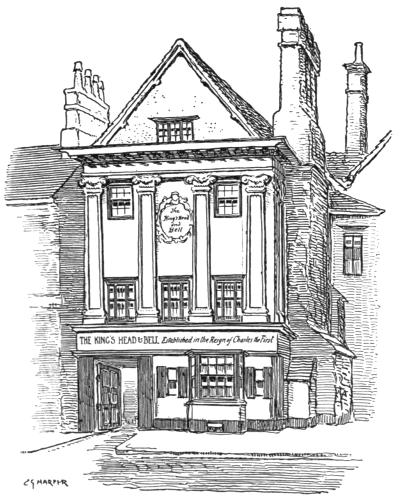
THE “KING’S HEAD AND BELL,” ABINGDON.
SUTTON COURTNEY—LONG WITTENHAM—LITTLE WITTENHAM—CLIFTON HAMPDEN—DAY’S LOCK AND SINODUN
A group of rustic villages nestles undisturbed by any press of traffic on the right, or Berkshire, bank of the river: Drayton, Sutton Courtney, and Appleford; with Steventon and Milton away back in the hinterland, all very charming, and wholly unaltered. At Steventon are to be found the most delightful old cottages. There are no better in Berkshire. This is a sweeping statement, but true. The proof of it lies partly in visiting that coy spot: coy, because the said cottages lie off the high road along the by-lane known as Steventon Causeway.
One might say much about Sutton Courtney, the “south town” of the Courtneys, who owned it in the long ago, with Nuneham Courtney, to the north of it. Here is an “Abbey,” but it is in private occupation as a residence, and is not a show-house; and very much the same may be added of the old manor-house and its “Court House,” adjoining the church. The “Abbey” was really a place to which the brethren of the Abbey of Abingdon might occasionally retire for rest and for health’s sake.
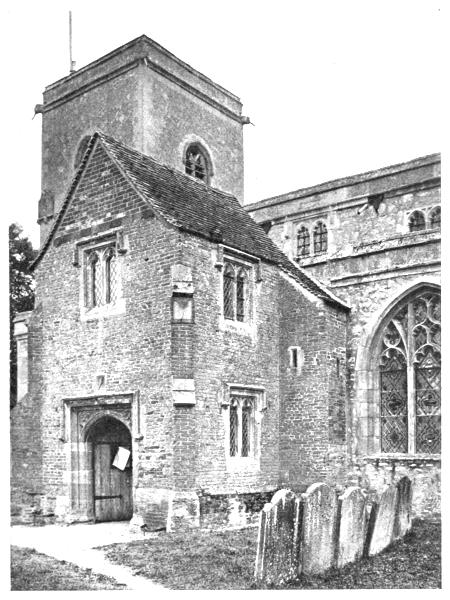
SUTTON COURTNEY CHURCH.
The manor of Sutton Courtney finally passed[237] from the family in the sixteenth century, when Henry Courtenay, Marquis of Exeter, was attainted and his property seized. The old manor-house, built around a courtyard, still retains its ancient hall, with minstrels’ gallery. The so-called “Court House,” in the grounds, is a late Norman building, with lancet windows, and is thought by competent authorities to be the hall of justice of the original manor-house.
There is much quiet charm in Sutton Courtney, and much interest: the charm and interest of long existence, with changes only brought about by slow effluxion of time. I suppose there is little new about Sutton Courtney except the young chestnut-trees that line the grassy way to the church; always excepting the last few puling infants that have been carried that way to be christened. The church itself is an example of gradual change, yet of the continuity that marks this dear ancestral God’s own country of Old England, in which we are unworthy co-partners. It is of all periods, from Norman to Perpendicular; its last development seen in the south porch, rendered in red brick, in strong contrast with the stone of the rest of the building. The porch is by courtesy Perpendicular, but is rather in the domestic Gothic style than of ecclesiastical type, and looks remarkably as though some one had found a small house and brought it to the church and left it to be called for. There is a particularly charming little late Norman belfry window, with interlacing arches, well worth notice, and a row of grotesquely-sculptured corbels of the same period,[238] with an odd variety of sick and sorry expressions. On the same face of the tower is a prettily-decorated sun-dial.
The pulpit, with quaint sounding-board above and the fine Transitional Norman arch next it, form a charming picture. It is easily obvious that this enriched arch, now forming that of the easternmost bay of the south aisle, was formerly the chancel arch, before the church was rebuilt on a larger scale than the original structure; for although the arch itself has found a new situation, the columns on either side of it have been used again to support the newer and broader chancel-opening.
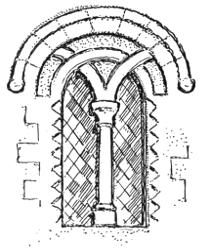
NORMAN BELFRY-WINDOW, SUTTON COURTNEY
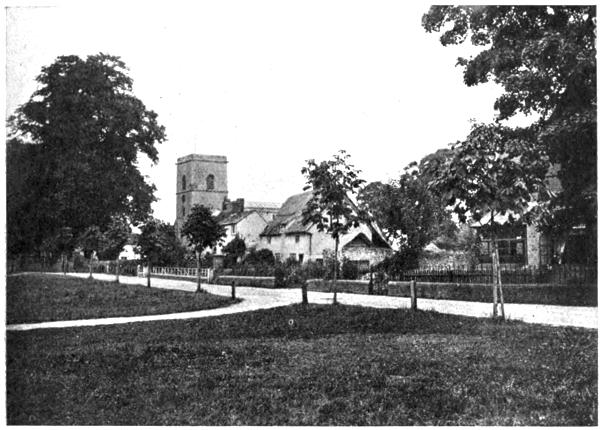
SUTTON COURTNEY.
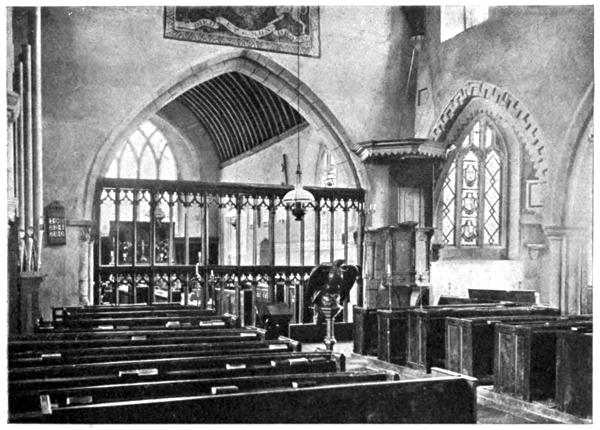
INTERIOR, SUTTON COURTNEY CHURCH.
Two curious black-and-white frescoes, at the west end of the north and south aisles respectively, are worth notice. They represent the administration of the Andrews Charity, by which six poor widows, and as many men, were given clothes, a penny loaf each on Sundays, and on three certain days yearly, money to buy meat. They were, unhappily, obliged to listen to a sermon preached on Corpus Christi day, on the goodness of Andrews and the humility and thankfulness proper to bedesmen and receivers[241] of doles. The frescoes represent the old men and the old women receiving the clothes, which they appear to be doing in a somewhat tentative and timorous, not to say condescending, manner, at the hands of one who looks like a ferocious beadle, or suchlike functionary.
There is a bridge at Sutton Courtney where toll is still demanded. It is variously “Sutton” bridge or “Culham” bridge: this last name productive of some confusion with the bridge at Culham ford (or Culham Hithe) between Dorchester and Abingdon.
From Culham and Sutton Courtney one comes by river in a mile under the ugly Great Western Railway bridge at Appleford, and then in another mile to the lovely winding backwater on which Long Wittenham is situated. Although now a backwater, it is the real original course of the river, and the straight waterway on the left, through which all the traffic passes on to Clifton Lock, is a formal cut, made for convenience, and for shortening the distance. Long Wittenham, by reason of this circumstance, is nowadays not only on a river backwater, but also, owing to the main roads passing it at a considerable distance away, on a backwater of life as well; and those who seek to reach it by road will find that the way is not only long, but circuitous and puzzling; while to those who may essay to leave it by a specious short-cut for Appleford, the only advice to be offered, if they ride bicycles, is “don’t!” especially as no reasonable person, having once seen Appleford, which consists[242] of a railway crossing and a few cottages, and a rebuilt church, ever wants to go there again.
The picturesque and interesting church of Long Wittenham, partaking of all periods of Gothic architecture, has two especial claims to notice. The first is in the Early English leaden font, one of the twenty-nine leaden fonts known to exist in England. The lower part of it is arcaded, the arches filled with effigies of bishops; the upper part decorated at irregular intervals with curious whorl devices. The Jacobean wooden carved font-cover also is not without interest.
The second of these special features is a curious piscina in the shallow south transept of early fourteenth-century date, combining with the purpose of a holy-water stoup that of a monument to the founder of the church. This takes the form of a miniature recumbent effigy, two feet in length, of an armed knight, cross-legged, and with drawn sword in hand and shield on arm. Two angels, sculptured in low relief, crown the arch. A third claim that Long Wittenham church may well make upon the lovers of things venerable and beautiful is the very fine old timber porch, romantically weathered. The accompanying illustration displays this to excellent advantage, and also emphatically discloses the massive character of the timbering, seen especially in the verge-or barge-boards, consisting of but two separate pieces, of great thickness. It is a truly worshipful piece of craftsmanship.
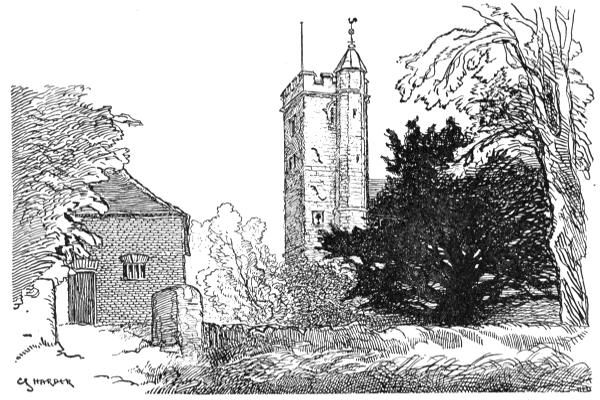
LITTLE WITTENHAM.
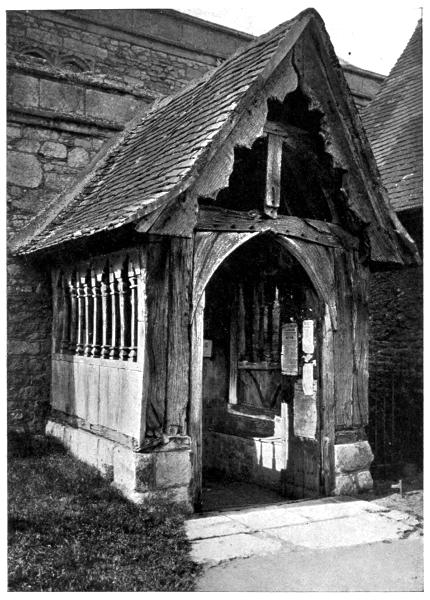
ANCIENT TIMBER PORCH, LONG WITTENHAM (UNRESTORED).
Long Wittenham may well be called long. From the ancient cross at one end of it, past the church, it goes on and on in a single street, and finally loses itself indeterminately between making on the one hand for Clifton Hampden, and on the other for the vast hedgeless fields across which lies the way to Little Wittenham, one mile distant. Those widespreading fields of this district are a distinct and remarkable feature of this countryside. Whether they be pasture, or corn, or turnip fields, they give a sense of largeness and strangeness to the traveller in these parts, accustomed only to the little five- or six-acre enclosures of other neighbourhoods. Here vast fifty-acre expanses of wheat or swedes go in swooping undulations over the hillsides, and you rarely see the boundaries of them. These peculiarities of Berkshire agricultural conditions certainly make for economical farming, with less space wasted upon unproductive hedges; and they certainly also make for picturesqueness here, where the great double hill of Sinodun rises boldly in roughly pyramidal shape from the lower levels. There are huge prehistoric earthworks on the summit of Sinodun: vast concentric circumvallations and fosses reared by long-forgotten folk, the vastness of whose defensible works gives, almost like an arithmetical exercise, the measure of their fears. Who were those who slaved so strenuously at this fortification, and who those others against whose expected onslaught they made such preparations? Archæologists have their theories, indeed, but no one knows. Really, from all available evidence, it would appear that Sinodun was fortified from the very earliest times, and that each conquering race which[248] settled in Britain, and in turn decayed in manhood and the arts of war, and so gave opportunity for a newer conquest at the hands of uncultured but virile barbarians, in turn occupied this hill-top and were attacked and slain in it, in those pitiless battles of extermination that were the usual features of the world’s youth.
Sinodun and its fellow-hill are in these times crested with plantations of trees, known far and near as “Wittenham Clumps”; and there is a third clump, a minimus infant brother, or poor relation, kind of clump, on a lesser eminence, not unremotely reminiscent of Landseer’s picture, “Dignity and Impudence.”
The traveller across Didcot downs, the boating-man on the Thames—all, in fact, who come within view of them—are obsessed by Wittenham Clumps, which dominate all views, and from the river, at any rate, are always appearing in the most unexpected quarters. Even the traveller by railway remarks them. Such an one, journeying along the Great Western main-line and gazing from the carriage-windows, sees those black blotches of trees on the hill-tops come whirling into view, and thinks of them in relation to his journey, with the mental note, “Now we are near Didcot.”
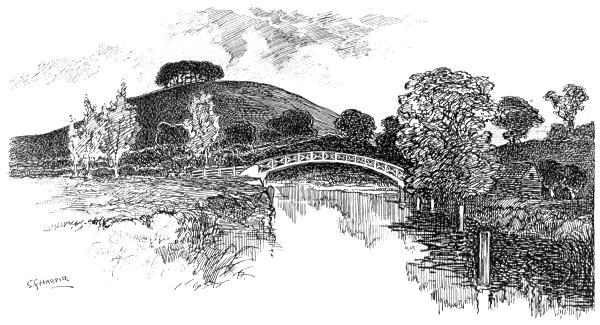
DAY’S LOCK, AND SINODUN HILL.
Sinodun and the clumps look nowhere more impressive than along the road between Culham and Wallingford, where they form not so much the boldly-isolated hills and tufts they appear to be from the river, as the culmination of the gradually-rising downlands. In the lap of the downs, just[251] before they rise to these crests, are situated some ranges of farm-buildings in the open, hedgeless fields, and there you see the cattle-byres and the ricks looking small against the huge scale of their surroundings in this shivery setting. It is Anglo-Saxon Berkshire you see here, in all essentials, not the twentieth-century Berkshire typified by Reading; and more of a piece with White Horse Hill than with that bustling and thriving and increasing town.
The stranger who comes to Long Wittenham thinks, on first seeing its retired aspect, that if ever he wished to seclude himself from the world, it is to Long Wittenham he would go; but he has only to proceed to Little Wittenham for him at once to look upon Long Wittenham as, by force of contrast, a metropolitan centre. As the larger place is with a peculiar fitness styled “long,” so yet in a more appropriate manner is the smaller called “little.” It appears to consist solely of a church, a vicarage, and a farm.
Little, or Abbot’s, Wittenham, the manor having once belonged to Abingdon Abbey, is not merely little. It is also remote. Not a remoteness of great mileage, but the quite equal detachment of being situated on a road that leads to anywhere at all only by rustic and winding ways. It sits peacefully and slumberously at the very foot of Sinodun, enfolded amid delightful hedgerow elms, “the world forgetting, and by the world forgot.” Not always was Little Wittenham so retired from all rumours of the outer world, for here was situated,[252] from the sixteenth century until 1800, when it was demolished, the manor-house of the Dunch family, who moved not obscurely in the society of their time. The Dunches finally died out in 1719, and now all that is left of them are some musty pedigrees in county histories, the mounds and trenches to the north of the church, where their mansion stood, and some tombs and brasses in the church itself, which was rebuilt, except the tower, in 1863. It is a tall, slim tower, picturesquely weatherworn, but not exceptionally remarkable, unless we take note of its small turret-window in the shape of an ace of spades (not an ace of clubs, as my late friend, Mr. J. E. Vincent, says in his Highways and Byways in Berkshire). Local legend tells us that this represents the ace with which the builder of the tower won a fortune; but it is really nothing more than a cross-slit window, mutilated in its upper half into that shape.
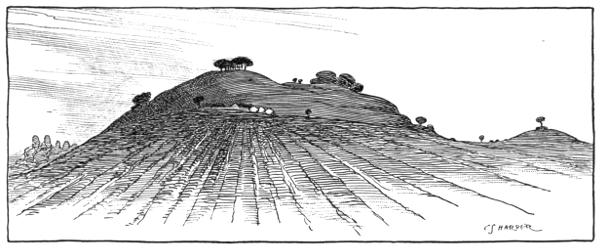
WITTENHAM CLUMPS.
Clifton Hampden, lying between the Wittenhams, is on the Oxfordshire side of the river. If there were ever a competition as to which is the prettiest village on the Thames below Oxford, surely Clifton Hampden would be bracketed with Sonning for first place. There is this chief difference between the two; that Sonning is a considerable village and Clifton a small one. They are alike in that they both possess a bridge, but different again in the fact that while Sonning bridge is of the eighteenth century, and with only its quaintness to recommend it, the bridge at Clifton is a beautiful building of the nineteenth, in the mediæval style, one of the most successful[255] on the river, and only lacking the element of age. There is, sooth to say, no village at Clifton Hampden; just a bridge, a church, the lovely old thatched Barley Mow Inn, and a few scattered cottages, generally, in the summer months, with an artist in front of each, rendering it in the medium of water or of oil, upon paper or canvas. And the grassy banks come down to the river delightfully, and over on the Oxfordshire side rises the charming little Transitional Norman and Decorated church upon the abrupt sandstone bluff or cliff that gives Clifton its name. One may linger away contented afternoons here, perhaps with a book, perhaps watching from the bridge the minnows or the dace, or with amusement noting the evolutions of the flotillas of ducks and ducklings that come and go in company, like miniature navies. To see a duck dip down and stand on its head in the water is to watch a humorous feat: possibly, according to the observations of some naturalists, to witness a tragedy, for it would seem that the ferocious pike have not infrequently been known to seize by the head a duck so gymnastically exercising, and thus to make an end of it.
The quality of Clifton Hampden church is shown, as to its exterior, by the accompanying illustration; which also discloses the steep steps leading up to it, and the elaborate churchyard cross—all works of 1907. The Hampdens, who once owned the manor, have no memorials here, and the greatly-restored condition of the church is due to the Hucks-Gibbs family. The Transitional Norman south nave-arcade,[256] with round-headed arches, simply sculptured capitals, and enormous bases to the columns, is entirely delightful: the plain painted north arcade, without capitals, poor and mean by comparison. In the church was once an ancient leaden font, of the Dorchester and Long Wittenham type, but this was sold for old metal by a vicar who thought it ugly!
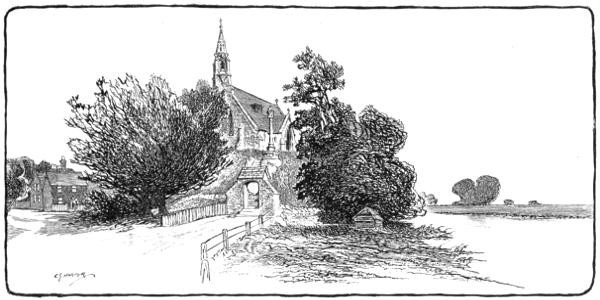
CLIFTON HAMPDEN.
Sinodun Hill, whose aspects and history have already been remarked upon, groups grandly as one drops down river to Day’s Lock, as perhaps the illustration may serve to indicate. The original Day who, ages ago, conferred his name upon the lock is forgotten, but at any rate the proprietary style of the lock’s name and of those of one or two others reminds people who know anything about the history of the river of those times before the coming of the Thames Conservancy, when the stream and the towing-paths along it were regarded very much as the private property of the landowners whose fields ran down to their water-course. We read much of the mediæval robber-barons of the Rhine, and their fellows in this country were those riparian property-owners, who made up for the lack of ferocity which characterised their continental counterparts by a cunning assumption of legality, very much more difficult to dispose of than sheer brute force. Much of the history of the Thames is concerned with actions in courts of law to assert or to contest these rights, real or assumed. So early as 1624 an Act of Parliament providing for the better navigation of the Thames referred incidentally to[259] the “Exactions of the Occupiers of Locks and Weirs upon the River of Thames Westward,” and set out to do away with them; but that was a long business, and for many a year afterwards Day, of Day’s Lock, and Boulter, of Boulter’s Lock, and their brethren, owned, or rented from landowners, the locks still named after them, and charged just what they pleased for traffic passing through.
Beyond Day’s Lock comes Dorchester, i.e. Dwr chester, the fortress on the water. Plenty of water here, at any rate, to give point to the place-name, for at this spot the Thame, meandering along through oozy meadows, joins the Thames. It cannot be said, by any exactness of imagery, to “fall” into it; to use that well-worn expression beloved by the writers of geography primers.
DORCHESTER—BENSON
Dorchester, Oxon, has not the slightest resemblance to Dorchester, Dorset: the two have little in common save their name, which might well have been much more than duplicated, seeing how many must have been the camps and fortresses upon various waters. Fortunately, with the result of saving us from the confusion of dozens of Dorchesters, our very remote ancestors were possessed of sufficient resourcefulness to enable them to fit distinctive names to those places.
The great days of Dorchester are done, and the place is so quiet and slumberous, although on a high road, that the first part of the place-name might almost be held to derive from the French verb dormer, to sleep. The one street, long and somewhat picturesque, the fine stone open-balustraded bridge across the Thame, and the church: in that inventory you have an outline of Dorchester. The great parish church that was once an Abbey church, the successor of an early Cathedral, although an architectural and archæological feature of great interest, does not form so striking a picture as it should; for the building is long and low, with level, unbroken roof-line, and an ineffective tower at the west end; and it displays its inordinate length prominently to the road.
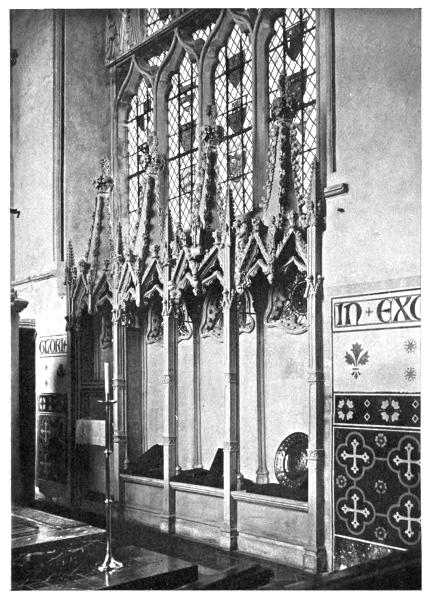
SEDILIA, DORCHESTER ABBEY.
The cathedral that once stood here was that of the great bishopric of Dorchester, founded in A.D. 635 by Birinus, who had been sent by the Pope, Honorius, the year before, to preach Christianity to the Saxons. The see of Dorchester lasted, with some intermissions, until 1086, and comprised the greater part of England, including what are now the bishoprics of Winchester, Salisbury, Exeter, Bath and Wells, Lichfield, Hereford, Worcester, and Oxford.
A few traces remain of that abandoned Saxon cathedral, but they are such that only expert archæologists can point them out; and of the Early English Abbey church begun by the Augustine monks to whom it had then been granted, in 1140, the nave alone is left. The nave in an ordinary building would be an important item, but the Abbey church of Dorchester is an extraordinary structure, and of such a plan that the architectural features of its nave cannot well be very striking. The building was originally without aisles. It adjoined the Abbey cloisters, which were situated on the north side, and consequently the north wall of the nave has few openings. The choir was rebuilt grandly, in the Decorated style, about 1330; and at a slightly earlier date a north aisle had been added to it, circa 1280. In 1300 a south-choir aisle was built, and twenty years later, a south-nave aisle. To this was added the Perpendicular porch. The tower was constructed about 1680, in a debased manner.
Thus the northern wall, from end to end, is largely blank, and the architectural graces of the building are reserved chiefly for the south aspect. The remarkable east end is built upon ground abruptly sloping to the east, and is, moreover, closely set about with trees.
The choir is the most notable portion, containing finely-carved stone sedilia, with small spherical triangular windows at the back, filled with twelfth- and fourteenth-century stained glass, setting forth the story of St. Birinus. The arrangement of these sedilia and the shape and design of these windows, profusely decorated with the “ball-flower” ornament, form probably an unique architectural composition. The great east window, for beauty easily in the front rank among elaborately-designed windows, is as remarkable as it is beautiful, being intricately traceried in its entire length, instead of, in the usual way, plainly mullioned for two-thirds of its height, with the enrichment confined to the head. The surpassing beauty of this design is perhaps even thrown into more prominent relief by the stark ugliness of the bare stone pillar dividing it in half. It seems probable that in olden times this was filled with a Crucifixion. The presence of this undesirable feature is a structural necessity. It is, in fact, a buttress, necessitated by the sharp fall in the ground outside. There is no excuse, however, for the stupidity which has caused some hangings to be erected at the back of the altar, by which a portion of the window is obscured.
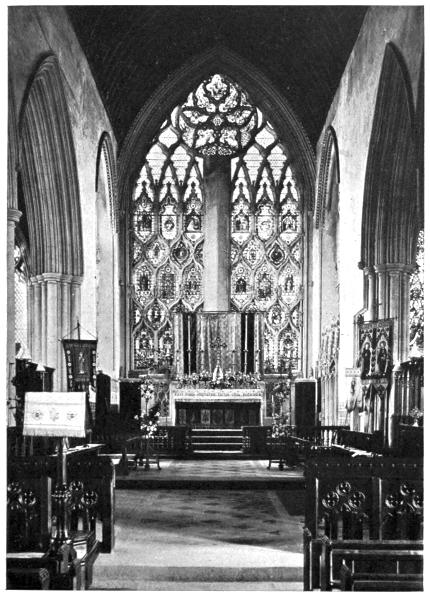
THE EAST WINDOW, DORCHESTER ABBEY.
But certainly the most extraordinary and interesting of windows is that on the north side of the choir, immediately adjoining the east window. It is the famous “Jesse Window,” of which the centre mullion represents the genealogical tree of Jesse, whose figure, in a reclining posture, is seen below. From the centre mullion spring branches at regular intervals on either side, worked decoratively in stone. Twenty-seven little figures, also carved in stone, represent the various personages of the House of David, and sixteen others are in stained glass. The exterior of this remarkable window is extraordinarily mean and thin, and gives no hint of the beauty of the interior.
Some altar-tombs and brasses remain, sadly mutilated, and the west end of the church is more or less of a stone-heap, where many fragments of the building are preserved. The chapel at the east end of the south choir-aisle was rebuilt by Sir Gilbert Scott. The work was largely a conjectural reconstruction, a type of undertaking Scott above all things delighted to engage upon, generally with results far from satisfactory; but in this case it is an unquestioned artistic success. It may, however, be observed that the constructional part of it is poor, for it is bodily subsiding into the deep gully that runs past the east end; and must soon be underpinned, or heavily buttressed, if it is not to fall into ruin.
The Norman font is of lead; a very fine example, exhibiting, within arcading, seated figures of the twelve apostles, in high relief. Another leaden[268] font, greatly resembling that at Wittenham, is at Warborough, two miles distant.
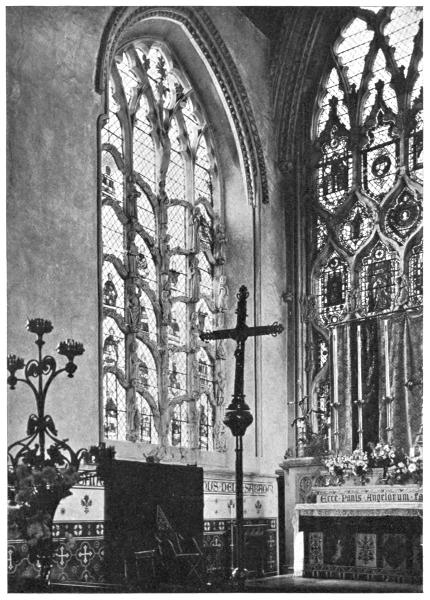
THE JESSE WINDOW (ON THE LEFT), DORCHESTER ABBEY.
Between Dorchester and Wallingford, whether we proceed by the Oxfordshire side of the river or the Berkshire, we are in a level district of many springs, to which the place-names of the villages numerously bear witness. Thus in Berkshire there are the two conjoined delightful villages of Brightwell and Sotwell, where a little rill goes rippling by, until early summer dries it up. The name “Brightwell” thus speaks for itself. Sotwell, I presume, means “sweet well.” And in Oxfordshire, beyond the scope of these pages, is another Brightwell, with the family name of “Salome” added to it; while the name of Ewelme, a beautiful and historic village near by, means simply “wells.” Just beyond Wallingford, too, is Mongewell. The river runs between, with the beautiful stone bridge of Shillingford, and the water-side village of Benson on the way: Benson, by common consent lopped of much of its name, being really “Bensington.” So unanimously has the locality agreed upon the shorter form, and for such a length of time, that even map-makers have adopted it. Of the clan of Bensings, whose chief settlement this was, we can know nothing; and the later conflicts between the Saxon kingdoms of Wessex and Mercia, in which Bensington changed hands with great frequency, until Mercia at length assimilated it, are such far-off, remote doings that it is perhaps a little difficult to take even a languid interest in them. Even the old coaching days seem remote, although large and imposing specimens of[271] English coaching hostelries stand in the crooked street of Benson, a little dazed by motor-cars and the noise and the stink of them, wondering whither have gone the mails and the stages of yore.
WALLINGFORD—GORING
And so we come, past the pretty Oxfordshire hamlet of Preston Crowmarsh, into the good old Berkshire town of Wallingford.
Wallingford town has been thrust aside by modern circumstances and altogether deposed from its ancient importance. If we look at large maps, and thereby see how several great roads here converge and cross the Thames, the reason of this former importance will be at once manifest, and likewise the existence of the great castle of Wallingford will be explained. Wallingford derives its name from “Wealinga-ford,” a Saxon term by which the ford of the Wealings—that is to say the British, or the Welsh, whom the Saxons were gradually displacing—was meant.
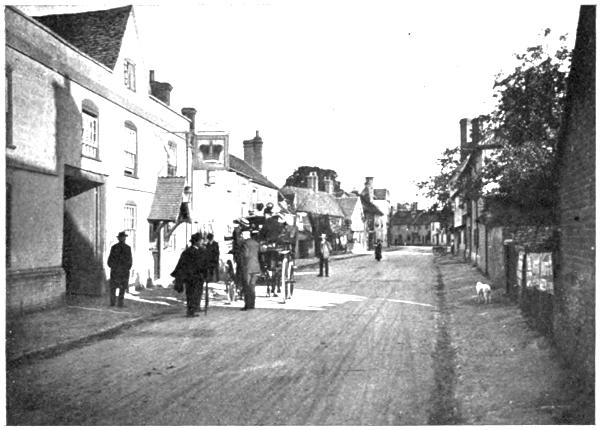
DORCHESTER.
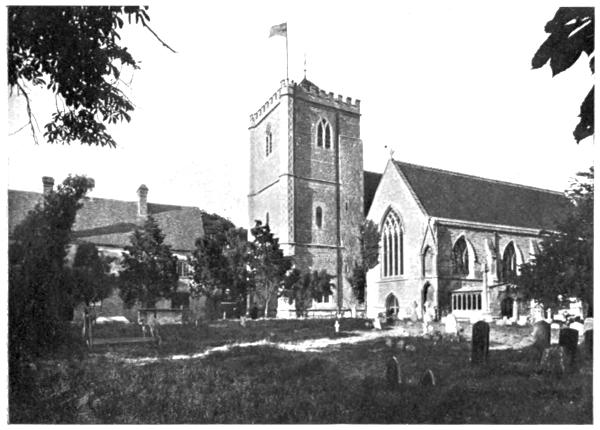
DORCHESTER ABBEY.
How they held the fort here in those dim times before the Norman came and built his great stone castle—and before even the Saxon came—we may perhaps see in the remarkable earthworks that still form three sides of a square enclosure: the river itself forming the natural defence of the fourth side. No stranger whose eye lights upon those ancient dykes in the Kine Croft can fail to notice them, nor help speculating for what purpose they were made. No facts are, or will ever be, available; but it does not require much penetration to reconstruct[275] the needs of that primeval community protected within these earthworks, not in themselves a sufficient protection, but easily defensible in that age when they formed—as they doubtless did—the foundation for a wooden stockade.
At that time, when William the Conqueror had descended upon England and fought the battle of Hastings, there lived and ruled in Wallingford a Saxon thane, by name Wygod, who, noting the caution which forbade the Conqueror to advance directly upon London and caused him to make a circuitous march, invited him to cross the Thames here, which he accordingly did, at this place receiving the homage of the chief Saxon notables. Was Wygod, then, a traitor, or was he merely a level-headed opportunist who saw that all was lost, and sought to moderate strife by wise action? We are not in full possession of the facts, and therefore cannot tell whether to praise or blame him. But the results show that he did well: did, perhaps, better than he knew at the time of doing; for he thus—and also in giving his daughter Edith in marriage to Robert D’Oyley, one of the Conqueror’s knights—helped in the great work of bringing about the settlement of the realm and the eventual merging of the Norman and the Anglo-Saxon races. And by so much those who fell at Hastings, fighting for their country, had died in vain.
It was not very long before the great castle of Wallingford was put to proof as a fortress, for it played an important part in the wars between the Empress Maud and King Stephen. The Empress,[276] sorely beset in the castle of Oxford, escaped thence through the snow of one December night, covered with a sheet; and by favour of that covering entirely escaped observation, and came safely to Wallingford, whither she was followed after an interval by Stephen, who built a castle at Crowmarsh, on the Oxfordshire side of the river, to keep her in check. She then escaped to Gloucester, while her trusty partisan, Brian Fitzcount, held out for years: until, indeed, Stephen was wearied, with the result that the long civil war was at last concluded by the treaty of Wallingford, effecting the compromise by which Stephen was to reign for his life, and Henry, son of the Empress Maud, was to succeed him: which, in the fulness of time, he accordingly did; and reigned, and misgoverned sometimes, and at others governed well, as Henry the Second, in a truly Norman way, for thirty-five years.
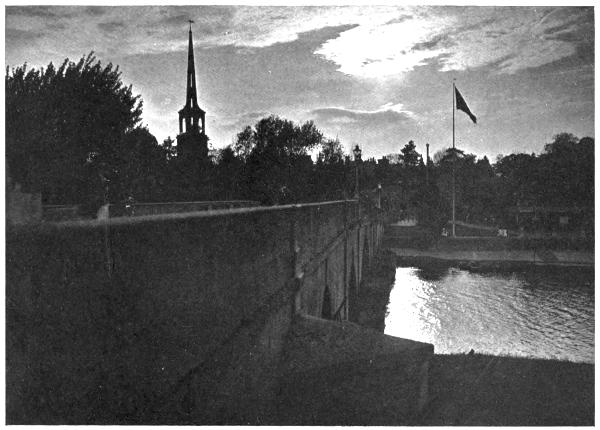
WALLINGFORD.
Wallingford was in after-centuries frequently a royal residence; chiefly, it is true, for royal widows and other such extinct volcanoes, Have Beens, and back-numbers; but by the sixteenth century the castle appears to have become dilapidated. Leland, for example, declared it in his time “sore yn ruine”; but Camden, coming after him, said its size and magnificence were amazing to him, as a young man. “My fer-ends, what is ter-ewth?” as Chadband despairingly asked. Perhaps Leland’s capacity for amazement was less than that owned by Camden. After Leland’s time, it must surely have been repaired; or how else could the sixty-five days’ siege have been withstood by the gallant Royalist[279] governor, Blagge, in 1646? I pause for a reply, without, however, in the least expecting one. Six years later, the cautious Parliament caused this stronghold to be blown up, and now all we can see are some rude fragments of walls in the large and beautiful grounds of a private residence, courteously opened on summer afternoons.
Its curious privileges also mark the antiquity of Wallingford. Among them is the nine o’clock curfew, instead of at eight o’clock: said to have been granted as a special favour by William the Conqueror, in recognition of his friendly reception here. The curfew-bell still sounds from the tower of St. Mary-le-More every evening at nine o’clock.
The native-born burghers of Wallingford had the immemorial right (perhaps they have it now, for what it may be worth) of claiming, when tried for a first offence against the criminal law, that, instead of being put to death, they should have their eyes put out and be otherwise mutilated. Those lenient, soft-hearted, sentimental ways of dealing with crime have ever been the curse of the country! At Wallingford, Thomas Tusser, author of Five Hundred Points of Good Husbandry, who was born about 1524 and died 1580, began his career as a chorister in the castle chapel, and appears to have had a sorry time of it here, according to his reminiscent verses,
Reason sufficient, it would seem, by those eloquent lines!
There were of old fourteen churches in Wallingford; but the town suffered so greatly in the plague of 1343, and then from the Black Death, that the population dwindled away to almost nothing, and most of the churches fell into ruin, so that three only remain: St. Mary-the-More, St. Leonard, and St. Peter’s; and even those were greatly battered during the siege. The last named is that whose fantastic white masonry steeple is prominently seen from the river. It was built, together with the body of the church, in 1769. In its churchyard lies Sir William Blackstone (died 1780), Lord Chief Justice, and author of the most famous Commentaries since Julius Caesar. But Blackstone’s work is of quite another kind than that of the “noblest Roman of them all.” It is, of course, a work of legal erudition.
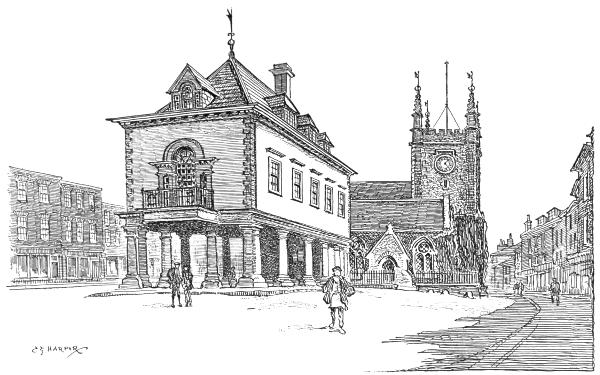
WALLINGFORD: TOWN HALL, AND CHURCH OF ST. MARY-THE-MORE.
St. Mary-the-More, whose name carries with it allusion to another St. Mary’s—St. Mary-the-Less, united with St. Peter, so long ago as 1374, is in the market-place, grouping finely with the curious seventeenth-century Town Hall that stands supported on an open arcade, affording space for the market. It is so fine and so entirely satisfactory a Town Hall, and so imbued with architectural grace and distinction, that no one will be in the least surprised to see it some day improved off the face of the earth, in the usual manner of provincial authorities with such. The prominent gallery above was, and is, used for proclaiming public events, from the accession[283] of a Sovereign down to the result of a municipal election.
For the rest, Wallingford is a quiet town, with a workhouse and the gasworks as the chief architectural features of one end; and a very fine stone bridge of fourteen arches, rebuilt in 1809, at the other. Some solid, comfortable-looking seventeenth- and eighteenth-century residences somewhat ennoble the quiet streets, and the George Inn is picturesque.
Crowmarsh Gifford is a little village on the Oxfordshire side of the river.
Newnham Murren stands beside a steep and exquisitely-wooded road that leads on past Mongewell, where it loses that lovely woodland character and goes undulating over chalky switchbacks to come eventually to North Stoke, South Stoke, and Goring.
Mongewell church stands in a beautifully-wooded park, on a lawn-like expanse close to the river bank. It has, unfortunately, been entirely rebuilt. Shute Barrington, Bishop-Palatine of Durham, who possessed a country residence here, and died in London in 1826, aged ninety-three, is buried in the building.
North Stoke is just the matter of a few farms and a rustic church, but South Stoke is a considerable village, lying between the river and the Great Western Railway on its way from Goring to Cholsey. It is, perhaps, a thought too much obsessed by the railway, for the embankment of it, not at all masked by trees, looks starkly down upon village street and church. Here, too, the church has been restored[284] and rendered uninteresting, except for its old wrought-iron hour-glass stand.
And so we come into Goring, and to its strangely-named inn, the “Miller of Mansfield”; its sign, painted by Marcus Stone, R.A., with a scene from the old legend, and a quotation from it; “Here,” quoth the Miller, “goode fellowe, I drink to thee.” The sign is strangely out of its geographical setting, for the neighbourhood of Mansfield, in Nottinghamshire, is a far cry from Goring. The legend tells how Henry the Second, lost while hunting in Sherwood Forest, sought shelter of the miller, who gave him half a bed with his son Richard, and fed him well on venison; “only,” said he, “you must not let the King know I poach it.” The King (always according to the legend) gave the miller a pension of a thousand marks yearly, for life. His name, it appears, was Job Cockle, and the King created him “Sir John,” and made him ranger of the forest; and perhaps, on the well-proved principle of “set a thief to catch a thief,” he served well to preserve the royal game.
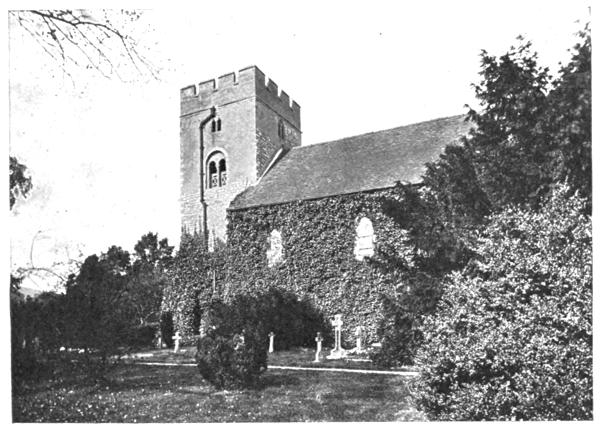
GORING CHURCH.
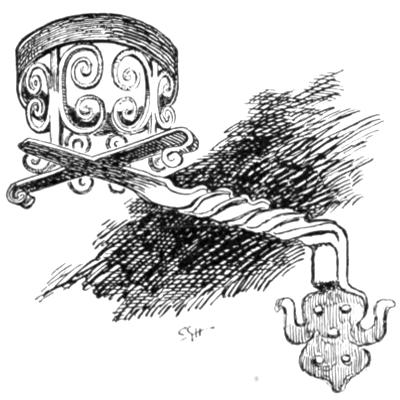
HOUR-GLASS STAND, SOUTH STOKE.
Goring (“Garinges” in Domesday), whose name means “the meadow on the edge,” or margin—i.e. on the shores of the Thames—is a Thames-side village improved utterly out of its olden country style. It is still a village, just as one may truly say that a commoner created a peer is still a man; but it is a village almost wholly composed of stylish up-river residences; and those few shops, a hotel or two, and a scanty sprinkling of cottages that exist here, do so only by way of ministering to the[287] villa-residents. It is extremely difficult to come to the river banks here, except at the picturesque bridge that joins Goring with Streatley, on the opposite shore, for every piece of land and every access are jealously guarded, and there are not a few rights-of-way that may be observed by the observant to be artfully masked with hedges and screened by gates, or even decorated with lying “Private Road,” and “Trespassers will be Prosecuted” notices. The stranger who desires to wander at will is well-advised to disregard all such. The same new tale is told from the river, for boating-parties nowadays proceed up-stream or down between endless notices displayed on inviting riverside lawns and at seductive side-channels, to the effect that this, that, and the other are “Private”; “No Landing,” or “Private Backwater,” and the like.
Amid all these modern developments, the ancient Norman parish church of St. Thomas à Becket stands, not so greatly altered. Even tyros in the understanding of architecture can tell at a glance that its tower is of that period, and some heavy cylindrical columns within proclaim the same age; but the “Norman” semicircular apse is a modern rebuilding of the original, destroyed long ago.
The evident ancient importance, ecclesiastically, of Goring is due to the existence of an Augustinian convent here, from the time of Henry the Second; but its secular importance was of far remoter date, for this was the place where that immemorial British track, the Icknield Way, crossed the Thames, on its course from Icklingham, the capital of the Iceni,[288] out of Suffolk and through Essex, Buckinghamshire, and Oxfordshire, to climb the Berkshire downs, and so continuing into the West of England. The Romans found Goring as useful a strategic point as did those early British peoples; and must, if the evidences of coins, and foundations of buildings, and mosaic pavements discovered here are worth anything, have made it almost as favourite a residence in the more settled years of their occupation of Britain as it is in our own era. Streatley, on the Berkshire bank, in its name, the “street meadow,” alludes to the passing through it of this ancient street, or road.
There are a few unimportant brasses and other memorials to the Whistler and other families in Goring church. Among these is a Latin inscription to “Helinor and Margaret Whistler,” which is rendered into English thus:
“This Helinor Whistler, a pious, beautiful, and modest virgin, lies with her sister Margaret in the tomb. These, whom love and one spirit united, are enshrined together in bronze by their only brother. She was wont to weep ever, seldom to smile; for a season, vows, prayers, and tears were her meat and drink. She seemed to outlive her two sisters in actual existence, yet to them it was as if she were dead, though living; and after they were ashes she, fed by the fear of God, did not touch bread and drink for seven years. The vows and prayers of the poor of Goring and the neighbourhood and the muse of Oxford forbid her to die; and, being dead, she still lives.”
Fortunately for the gaiety of nations, we may say with conviction that this remarkable person is exceptional.
Goring was the scene of a sad happening in 1674, by which “about” sixty persons were drowned. This is related in a scarce pamphlet of the time, called
Sad and Deplorable News
from
OXford-sheir & BArk-sheir
being a lamentable and true
RELATION
of the drowning of about sixty persons, Men, Women, and Children, in the lock near Goring in Oxfordsheir as they were passing by water from Goring-Feast to Stately in Barksheir.
London:
Printed for R. Vaughan in the Little Old Bailey.
1674.
“a punctual account of a most true and unparalleled Disaster which happened at Goring Lock, going to Stately on Monday the 6th of this instant July 1674 about 7 aclock at night, where about 50 or 60 persons, of Men, Women, and Children, with one Mare crossing the water together in a boat from Oxfordsheir to Barksheir by the watermen’s imprudently rowing too neer the shore of the Lock they were by the force of the water drawn down the Lock, where their boat being presently overwhelmed[290] they were all turned into the Pool except fourteen or fifteen (who had been all there at the Feast at Goring) were all unfortunately drowned, and to show how vain all human aid is when Destiny interposes, this happened in the view of hundreds of people, then met at the same feast, near this fatal Lock, who found the exercise of their pastime disturbed, and their Jollity dashed by this mournful Disaster, of which they were helpless—but I hope not fruitless—spectators.”
This calamity so impressed the pamphleteer that he drew from it the conclusion the end of the world was at hand; but he appears to have been quite as eager to sell his pamphlet as though the world were good enough to last all his time. That is over two hundred and thirty years ago, and the old globe still spins in space.
The white-painted wooden toll-bridge that carries the road across the river to Streatley gives the wayfarer the best views. From it you see to greatest advantage the foaming weir, the green backwaters, and the mill. Let us cross this bridge to Streatley, avoiding the fearful hill that leads past the hamlet of Gathampton, circuitously up to Goring Heath, and then alarmingly down to Whitchurch. Streatley we shall find much smaller and simpler than Goring. There, to one side of the bridge, is the mill, with the neatest of lawns, decorated with brilliant flowers, giving upon the water; while on the other is the waterside Swan inn, greatly resembling some ancient private residence, also with its lawns and with a full supply of the easiest chairs, wherein to do that most difficult of things—nothing.
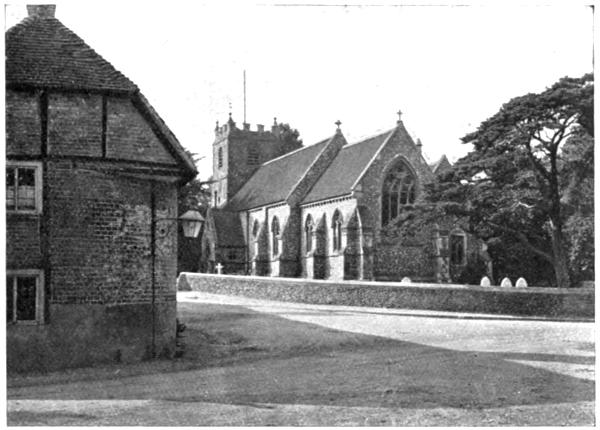
PANGBOURNE CHURCH.
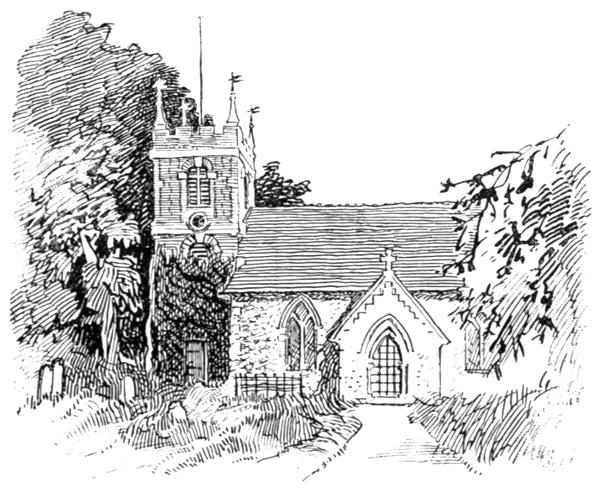
BASILDON CHURCH.
STREATLEY—BASILDON—PANGBOURNE—MAPLEDURHAM—PURLEY
Beside the long rustic street of Streatley is the restored—nay, the rebuilt—church, with a new font and almost everything else new. The old font has been walled into the masonry at the junction of nave and chancel.
The street goes mounting towards the broad high road that runs closely neighbouring the river on this Berkshire side, between Wallingford and Reading. Between this and Wallingford we have only the two villages of Moulsford and Cholsey, and they lack interest. Cholsey is the “Celsea” of Domesday. Boating-men know Moulsford only as that place where the old waterside inn, the Beetle and Wedge, is situated. The queer sign has puzzled many town dwellers, but it presents no difficulties to country folk, for a “beetle” is well known to them as a heavy wooden mallet, used in splitting timber, and the “wedge” is the iron wedge inserted in the timber and struck by the “beetle.” The inn has, like most other Thames-side inns, been largely added to and altered; but old frequenters of the river have ardent memories of it and their morning “rum-and-milk.”
Does any one in these latter days take that old traditional Thames-side morning drink, “rum-and-milk,” that once most favoured of all up-river restoratives? Have we not, in “those dear dead days beyond recall,” as we lay in our more or less lavender-scented beds in some old-world waterside hostelry, been awakened by the clink of a trayful of glasses and heard a knock at the door, with the call, “Your rum-and-milk, sir”?
We had not ordered rum-and-milk at that untimeous hour, but as this was obviously the proper thing to be done, the custom of the country, so to say, we drank that strange drink—rather a heady and heavy drink, without question—and were promptly sent off to sleep again by it.
The charms of Streatley and of Streatley Hill have been sung by Mr. Ashby-Sterry, who is a kind of picnic and banjo poet-laureate of the Thames as it was in those famous riverside years, the ’eighties, when the charms of the river had not long since been discovered, and commercialism had not yet begun its reign: the years when Molloy and Cotsford Dick, and Marzials had just entered upon their song-writing and composing. Mr. Ashby-Sterry is not a Tennyson, but one cherishes an endearing picture of him, clothed in boating-flannels and a “blazer,” laurelled—if one may express it so—with bulrushes, and discovered seated in company with some cooling tipple, gently but firmly declining to perform any physical exertion: least of all that involved in climbing Streatley Hill, which is indeed a “breather.” Perhaps he is not even a[295] little bit like that, really; but his writings are responsible for such a mental picture:
But to have done with all this, and to make our way to Basildon, which, although it is divided into Upper and Lower, is in the total of those parts but a small place. I do not know (nor apparently does any one else) from what Basil or Basileus—what leader of men—Basildon takes its name. That, like so much else, is lost among unrecorded things, but the world knows a something else more immediately to the point; and that is the fact that Charles Morrison of Basildon Park died in the early part of 1909, worth about six millions and three-quarters sterling. The estate was later sworn for probate at the remarkable figure of £6,666,666; an extraordinary array of numerals, almost exactly the Number of the Beast, “six hundred threescore and six,” mentioned in the thirteenth chapter of Revelation, multiplied by ten thousand.
The ornate gates of the noble demesne of Basildon Park look upon the road, and are very florid, with stone gate-piers surmounted by urns filled to overflowing with stony representations of most of the kindly fruits of the earth, and upheld by cupids.[296] Basildon church, with a farm or two and the parsonage, lies down near the river in a tongue of meadow-land so cut off by the river on its north side and the railway on the south that it is, in effect, much more remote than many places hundreds of miles away. The high-road, like the railway, cuts across the base of this piece of land; and as only a narrow lane runs through it and simply ends at the church, there is no inducement for the ordinary wayfarer to venture this way. Strangers are rare down by that nook where Basildon church stands, almost hidden by trees, and I should not be surprised to learn that the few people who live there mark those days as special, and keep them in memory, when they chance to see a strange face. There are many remote corners along the shores of the winding Thames, but none more secluded than this of Basildon.
It is a small church that serves for the place, and the body of it appears to have been wholly rebuilt of late years. The tower, an eighteenth-century red-brick affair, is an almost exact counterpart, on a smaller scale, of the tower of Pangbourne church. Beside the massive polished granite tomb of the Morrisons stands a sculptured group of two boys represented as bathers standing on a rushy river-bank. This is the pathetic memorial of Ernest and Edward Deverell, aged sixteen and fifteen, who were drowned while bathing in the Thames, June 26, 1886.
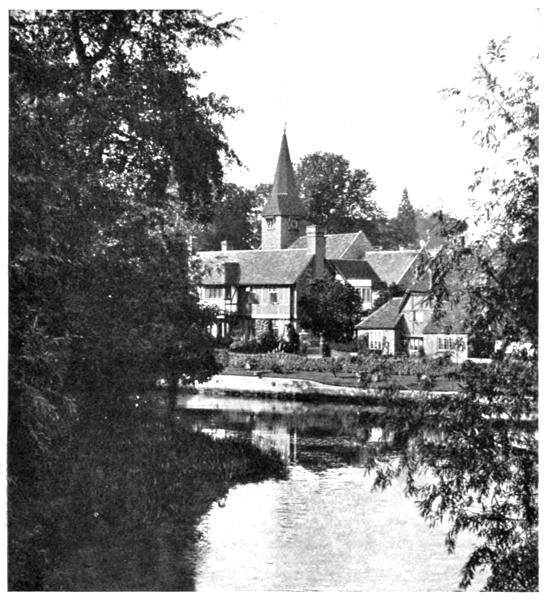
WHITCHURCH.
The road on to Pangbourne gradually nears the river again, and touches it at what was until some twenty years since one of the loveliest reaches of[299] the Thames, for here the stream is bordered by a long ridge of chalk hill, broken here and there into cliffs that used to shine whitely into the water. Keeley Halswelle painted an exquisite picture of this scene, and it was hung in the Royal Academy; and that is now the only thing left of it, for Shooter’s Hill—the name of this ridge—has been purchased by a highly-successful trader in what is satirically known as the “rag trade” (why is it that the drapery trade is so greatly affected by Welshmen?) who has not only set up for something in the way of a country gentleman here, with his ornate house and picture-gallery, and his gardens and hot-houses, but has, in addition, quite in the way of the businessman, made the purchase an investment by scooping out nine or ten sites from those wild riverside chalk-cliffs, and building on them a series of villas, described in the guide-books as “bijou residences.” So the quiet, ancient beauty of Pangbourne Reach is now a thing of the past, and instead of the white cliffs, the stream reflects red-brick.
Something has already been said, in the opening pages of this book, respecting the recent spoiling of Pangbourne village by the overbuilding in it: all brought about by the convenience of a main-line railway-station in the very midst of the place; and therefore nothing more may be written. The same remarks apply in degree to Whitchurch, at the other end of the long bridge that here joins the two banks.
There is a dull high road out of Pangbourne, and there is a delightful towing-path, crossing the[300] mouth of the little Pang bourne, and going with a fine view across river to Hardwicke House, amid its beautiful lawns on the Oxfordshire side, and presently to Mapledurham Lock. Hardwicke House has associations with the troubles of Charles the First, and was greatly injured during the fighting about Reading.
Although there is no public ferry at Mapledurham Lock, boats there afford an opportunity of crossing the river; greatly, no doubt, to the chagrin of the Blounts, who own Mapledurham, and have not only distinguished themselves in modern times by seeking the aid of the law-courts to forbid fishing in the river at this point, but have so arranged that there is no inn at Mapledurham, and have placed every conceivable obstacle in the way of any one save themselves enjoying the scene. Notice-boards informing the stranger that this, that, and the other are “Private” start out at unexpected corners; and there is only wanting one touch to make this attitude thorough. The suggestion is hereby offered that, for thoroughly scaring away those insistent persons who do not entirely believe in such notices, there should be added to them, more Americano! “This means YOU.”
But there is reason in most things, and the reason for this uncompromising attitude is found, according to rumour, in the nearness of Mapledurham to Reading, which sends out numerous boating-parties at holiday times; and such parties, we all know, are not always discreet, either in word or deed.
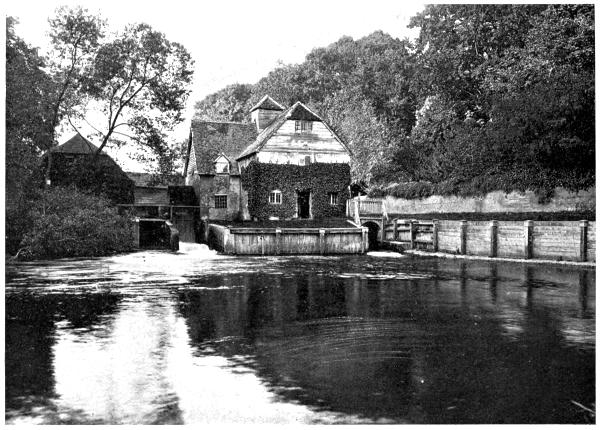
MAPLEDURHAM MILL.
The old mill of Mapledurham is, now that Iffley[303] Mill has become a thing of the past, the most picturesque on the Thames. Near by it stands the humble little church, amid tall elms, with monuments of the Blounts and others, secluded from lesser folk in a side chapel. A curious small mural monument, with the representation of a dropped curtain, is to be seen here, to the memory of Captain Adrian Rose, born 1878, died 1908. He served in the Boer War.
The beautiful late Tudor mansion of the exclusive Blounts, built by Sir Michael Blount, Lieutenant of the Tower in 1581, stands a little way back from the river, and turns its front away from it. Like so many Elizabethan manor-houses, its plan is that of an elongated capital letter E, the upper and lower projecting limbs formed by the wings; the middle being the entrance. The view of it at some little distance down the mile-long avenue of stately elms is delightful, whether you see it under the mid-day sun, or by the mellow romantic afterglow of a summer evening. At either time the richness in colour of its old red-brick front, patterned in lozenge shapes by vitrified bricks of a darker hue, is evident. It is a house of some romance. Legends tell that on the death of a Blount, or prophetically before such an event—it is not quite clear which—an elm of the long avenue falls; by which it would seem that the owner of this avenue of many trees, a large proportion of them past their prime and prone (as elms especially are) to fall suddenly and without apparent cause, must sometimes receive a shock to his nerves, especially if he be superstitious; and as the Blounts[304] have ever been Roman Catholics, it seems safe enough to deduce superstition in many of them.
The family have been seated here some four hundred years, and are kin of that Sir Walter Blount who was slain at Shrewsbury fight, in 1403; cut down by Douglas, who mistook him for King Henry. “A gallant knight he was,” says Hotspur, pointing out to Douglas his mistake, “his name was Blunt, semblably furnished like the King himself.”
As popish recusants, and as Royalists in the civil war, the Blounts have suffered sequestration, and have seen hostile soldiers quartered in their old house, and the Sir Charles Blount of that time was slain in the service of the King at Oxford in 1644.
A literary association illuminates their annals at a later period, the spinster Martha Blount, having been Pope’s “Stella” or “Patty,” a constant friend and correspondent, and the recipient at the poet’s death of his books, his plate, and £1,000. That Pope was not in sympathy with the rural surroundings of Mapledurham seems evident from his lines upon Miss Martha on one occasion returning hither
But then, that was the approved eighteenth-century way!
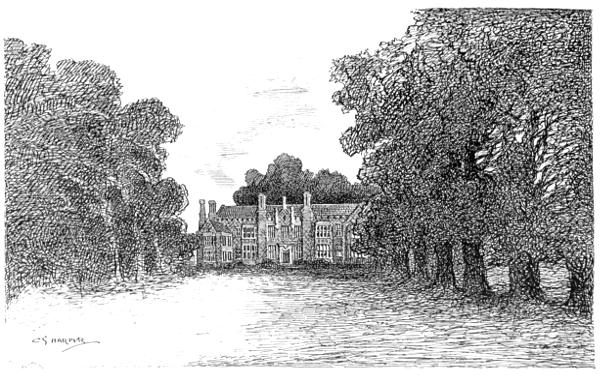
MAPLEDURHAM HOUSE.
A long three miles leads direct from Mapledurham to Reading—a lovely road through woodlands, by way of Caversham; but Caversham spoils it all, at the end: Caversham, the cross-river suburb of[307] Reading, where the new streets impinge upon the fair face of the country, and where the gasworks and the destructors, and suchlike evidences of civilisation abound, and crying children and angry mothers cry and spank. If I were a Blount and owned Mapledurham, I would not journey from it by way of Caversham, that is quite certain! The best way is undoubtedly by river, past delightful Purley; or by the road along the Berkshire bank, through Upper Purley, and past Tilehurst railway station.
Purley might well be thought to lie outside the strife of the wicked world. The “lea” down in which the village lies is so secluded that none others than those who live here, or have business in the place, ever come into it—unless they be stalwart or inquisitive explorers of the calibre—shall it be said?—of the present writer. The “village,” of a few rustic cottages, lies down below the high road, between the tall embankment of the Great Western Railway and the river. You may hear the trains numerously rushing by, swishing with a curious sound past the dense trees that fill this little nook and flourish upon the embankment itself, but you cannot well see them: only the arm of a tall signal-post wagging continually between the signal to proceed or to stop. The trains tell the villagers, plainly enough, that there is a busy world; and they can see it, plainly enough, when they go for their weekly marketing to Reading; but the business of it all passes by, out of sight, in the manner typified by those swiftly-moving trains.
There should be no ill in this place; but since they are human beings that live here, and not angels, there has been of late a good deal of trouble, well-known to local people in what was styled by the Berkshire newspapers of 1907-8 “The Purley Scandal.”
There need have been no scandal, so far as the outer world was concerned, had it not been for the action of the rector of the parish.
But let a summary of the case, extracted from one of the newspapers, here be given:
“A Mrs. Moule had been head mistress of the Purley Church of England school for twelve years, and had conducted it during that time efficiently, with nothing to be urged either against her abilities or her character. But Mrs. Moule had a daughter who loved not wisely but too well. The result was that the girl had to get married hastily. She left the village until the child was born; then she went to stay with her mother for a few days. The rector of the parish—one of those nice, charitable Christian gentlemen with whom our readers are by this time well acquainted—demanded that Mrs. Moule should turn her daughter out of doors for at least six months. The mother refused, her ‘conduct’ was brought to the notice of the school managers by the holy man aforesaid, and she was dismissed her employment. The Education Committee of the Berks County Council supported the parson and the managers in their monstrous act of injustice, and tried to burke discussion. The whole question was then raised at a special meeting of the Council, when the[309] decision arrived at was ‘that this Council expresses a wish that the Education Committee will, should opportunity offer, sanction Mrs. Moule’s appointment to a similar post to that which she recently held.’”
Here we see in working that truly British love of compromise, which has been aptly defined as a middle course by which neither party is satisfied.
The church of Purley lies quite remote, at the end of the scattered cottages, and through a woodland path. The body of it has been rebuilt, but the red-brick seventeenth-century tower remains, with a sculptured heraldic shield of the Bolingbrokes on its south face.
Transcriber’s Note: This index originally appeared in Volume II and has been copied here for the convenience of the reader. Only the references within this volume are hyperlinked.
Printed by Hazell, Watson & Viney, Ld., London and Aylesbury.
End of the Project Gutenberg EBook of Thames Valley Villages, Volume 1 (of 2), by
Charles G. Harper
*** END OF THIS PROJECT GUTENBERG EBOOK THAMES VALLEY VILLAGES, VOL 1 ***
***** This file should be named 57365-h.htm or 57365-h.zip *****
This and all associated files of various formats will be found in:
http://www.gutenberg.org/5/7/3/6/57365/
Produced by Chris Curnow and the Online Distributed
Proofreading Team at http://www.pgdp.net (This file was
produced from images generously made available by The
Internet Archive)
Updated editions will replace the previous one--the old editions will
be renamed.
Creating the works from print editions not protected by U.S. copyright
law means that no one owns a United States copyright in these works,
so the Foundation (and you!) can copy and distribute it in the United
States without permission and without paying copyright
royalties. Special rules, set forth in the General Terms of Use part
of this license, apply to copying and distributing Project
Gutenberg-tm electronic works to protect the PROJECT GUTENBERG-tm
concept and trademark. Project Gutenberg is a registered trademark,
and may not be used if you charge for the eBooks, unless you receive
specific permission. If you do not charge anything for copies of this
eBook, complying with the rules is very easy. You may use this eBook
for nearly any purpose such as creation of derivative works, reports,
performances and research. They may be modified and printed and given
away--you may do practically ANYTHING in the United States with eBooks
not protected by U.S. copyright law. Redistribution is subject to the
trademark license, especially commercial redistribution.
START: FULL LICENSE
THE FULL PROJECT GUTENBERG LICENSE
PLEASE READ THIS BEFORE YOU DISTRIBUTE OR USE THIS WORK
To protect the Project Gutenberg-tm mission of promoting the free
distribution of electronic works, by using or distributing this work
(or any other work associated in any way with the phrase "Project
Gutenberg"), you agree to comply with all the terms of the Full
Project Gutenberg-tm License available with this file or online at
www.gutenberg.org/license.
Section 1. General Terms of Use and Redistributing Project
Gutenberg-tm electronic works
1.A. By reading or using any part of this Project Gutenberg-tm
electronic work, you indicate that you have read, understand, agree to
and accept all the terms of this license and intellectual property
(trademark/copyright) agreement. If you do not agree to abide by all
the terms of this agreement, you must cease using and return or
destroy all copies of Project Gutenberg-tm electronic works in your
possession. If you paid a fee for obtaining a copy of or access to a
Project Gutenberg-tm electronic work and you do not agree to be bound
by the terms of this agreement, you may obtain a refund from the
person or entity to whom you paid the fee as set forth in paragraph
1.E.8.
1.B. "Project Gutenberg" is a registered trademark. It may only be
used on or associated in any way with an electronic work by people who
agree to be bound by the terms of this agreement. There are a few
things that you can do with most Project Gutenberg-tm electronic works
even without complying with the full terms of this agreement. See
paragraph 1.C below. There are a lot of things you can do with Project
Gutenberg-tm electronic works if you follow the terms of this
agreement and help preserve free future access to Project Gutenberg-tm
electronic works. See paragraph 1.E below.
1.C. The Project Gutenberg Literary Archive Foundation ("the
Foundation" or PGLAF), owns a compilation copyright in the collection
of Project Gutenberg-tm electronic works. Nearly all the individual
works in the collection are in the public domain in the United
States. If an individual work is unprotected by copyright law in the
United States and you are located in the United States, we do not
claim a right to prevent you from copying, distributing, performing,
displaying or creating derivative works based on the work as long as
all references to Project Gutenberg are removed. Of course, we hope
that you will support the Project Gutenberg-tm mission of promoting
free access to electronic works by freely sharing Project Gutenberg-tm
works in compliance with the terms of this agreement for keeping the
Project Gutenberg-tm name associated with the work. You can easily
comply with the terms of this agreement by keeping this work in the
same format with its attached full Project Gutenberg-tm License when
you share it without charge with others.
1.D. The copyright laws of the place where you are located also govern
what you can do with this work. Copyright laws in most countries are
in a constant state of change. If you are outside the United States,
check the laws of your country in addition to the terms of this
agreement before downloading, copying, displaying, performing,
distributing or creating derivative works based on this work or any
other Project Gutenberg-tm work. The Foundation makes no
representations concerning the copyright status of any work in any
country outside the United States.
1.E. Unless you have removed all references to Project Gutenberg:
1.E.1. The following sentence, with active links to, or other
immediate access to, the full Project Gutenberg-tm License must appear
prominently whenever any copy of a Project Gutenberg-tm work (any work
on which the phrase "Project Gutenberg" appears, or with which the
phrase "Project Gutenberg" is associated) is accessed, displayed,
performed, viewed, copied or distributed:
This eBook is for the use of anyone anywhere in the United States and
most other parts of the world at no cost and with almost no
restrictions whatsoever. You may copy it, give it away or re-use it
under the terms of the Project Gutenberg License included with this
eBook or online at www.gutenberg.org. If you are not located in the
United States, you'll have to check the laws of the country where you
are located before using this ebook.
1.E.2. If an individual Project Gutenberg-tm electronic work is
derived from texts not protected by U.S. copyright law (does not
contain a notice indicating that it is posted with permission of the
copyright holder), the work can be copied and distributed to anyone in
the United States without paying any fees or charges. If you are
redistributing or providing access to a work with the phrase "Project
Gutenberg" associated with or appearing on the work, you must comply
either with the requirements of paragraphs 1.E.1 through 1.E.7 or
obtain permission for the use of the work and the Project Gutenberg-tm
trademark as set forth in paragraphs 1.E.8 or 1.E.9.
1.E.3. If an individual Project Gutenberg-tm electronic work is posted
with the permission of the copyright holder, your use and distribution
must comply with both paragraphs 1.E.1 through 1.E.7 and any
additional terms imposed by the copyright holder. Additional terms
will be linked to the Project Gutenberg-tm License for all works
posted with the permission of the copyright holder found at the
beginning of this work.
1.E.4. Do not unlink or detach or remove the full Project Gutenberg-tm
License terms from this work, or any files containing a part of this
work or any other work associated with Project Gutenberg-tm.
1.E.5. Do not copy, display, perform, distribute or redistribute this
electronic work, or any part of this electronic work, without
prominently displaying the sentence set forth in paragraph 1.E.1 with
active links or immediate access to the full terms of the Project
Gutenberg-tm License.
1.E.6. You may convert to and distribute this work in any binary,
compressed, marked up, nonproprietary or proprietary form, including
any word processing or hypertext form. However, if you provide access
to or distribute copies of a Project Gutenberg-tm work in a format
other than "Plain Vanilla ASCII" or other format used in the official
version posted on the official Project Gutenberg-tm web site
(www.gutenberg.org), you must, at no additional cost, fee or expense
to the user, provide a copy, a means of exporting a copy, or a means
of obtaining a copy upon request, of the work in its original "Plain
Vanilla ASCII" or other form. Any alternate format must include the
full Project Gutenberg-tm License as specified in paragraph 1.E.1.
1.E.7. Do not charge a fee for access to, viewing, displaying,
performing, copying or distributing any Project Gutenberg-tm works
unless you comply with paragraph 1.E.8 or 1.E.9.
1.E.8. You may charge a reasonable fee for copies of or providing
access to or distributing Project Gutenberg-tm electronic works
provided that
* You pay a royalty fee of 20% of the gross profits you derive from
the use of Project Gutenberg-tm works calculated using the method
you already use to calculate your applicable taxes. The fee is owed
to the owner of the Project Gutenberg-tm trademark, but he has
agreed to donate royalties under this paragraph to the Project
Gutenberg Literary Archive Foundation. Royalty payments must be paid
within 60 days following each date on which you prepare (or are
legally required to prepare) your periodic tax returns. Royalty
payments should be clearly marked as such and sent to the Project
Gutenberg Literary Archive Foundation at the address specified in
Section 4, "Information about donations to the Project Gutenberg
Literary Archive Foundation."
* You provide a full refund of any money paid by a user who notifies
you in writing (or by e-mail) within 30 days of receipt that s/he
does not agree to the terms of the full Project Gutenberg-tm
License. You must require such a user to return or destroy all
copies of the works possessed in a physical medium and discontinue
all use of and all access to other copies of Project Gutenberg-tm
works.
* You provide, in accordance with paragraph 1.F.3, a full refund of
any money paid for a work or a replacement copy, if a defect in the
electronic work is discovered and reported to you within 90 days of
receipt of the work.
* You comply with all other terms of this agreement for free
distribution of Project Gutenberg-tm works.
1.E.9. If you wish to charge a fee or distribute a Project
Gutenberg-tm electronic work or group of works on different terms than
are set forth in this agreement, you must obtain permission in writing
from both the Project Gutenberg Literary Archive Foundation and The
Project Gutenberg Trademark LLC, the owner of the Project Gutenberg-tm
trademark. Contact the Foundation as set forth in Section 3 below.
1.F.
1.F.1. Project Gutenberg volunteers and employees expend considerable
effort to identify, do copyright research on, transcribe and proofread
works not protected by U.S. copyright law in creating the Project
Gutenberg-tm collection. Despite these efforts, Project Gutenberg-tm
electronic works, and the medium on which they may be stored, may
contain "Defects," such as, but not limited to, incomplete, inaccurate
or corrupt data, transcription errors, a copyright or other
intellectual property infringement, a defective or damaged disk or
other medium, a computer virus, or computer codes that damage or
cannot be read by your equipment.
1.F.2. LIMITED WARRANTY, DISCLAIMER OF DAMAGES - Except for the "Right
of Replacement or Refund" described in paragraph 1.F.3, the Project
Gutenberg Literary Archive Foundation, the owner of the Project
Gutenberg-tm trademark, and any other party distributing a Project
Gutenberg-tm electronic work under this agreement, disclaim all
liability to you for damages, costs and expenses, including legal
fees. YOU AGREE THAT YOU HAVE NO REMEDIES FOR NEGLIGENCE, STRICT
LIABILITY, BREACH OF WARRANTY OR BREACH OF CONTRACT EXCEPT THOSE
PROVIDED IN PARAGRAPH 1.F.3. YOU AGREE THAT THE FOUNDATION, THE
TRADEMARK OWNER, AND ANY DISTRIBUTOR UNDER THIS AGREEMENT WILL NOT BE
LIABLE TO YOU FOR ACTUAL, DIRECT, INDIRECT, CONSEQUENTIAL, PUNITIVE OR
INCIDENTAL DAMAGES EVEN IF YOU GIVE NOTICE OF THE POSSIBILITY OF SUCH
DAMAGE.
1.F.3. LIMITED RIGHT OF REPLACEMENT OR REFUND - If you discover a
defect in this electronic work within 90 days of receiving it, you can
receive a refund of the money (if any) you paid for it by sending a
written explanation to the person you received the work from. If you
received the work on a physical medium, you must return the medium
with your written explanation. The person or entity that provided you
with the defective work may elect to provide a replacement copy in
lieu of a refund. If you received the work electronically, the person
or entity providing it to you may choose to give you a second
opportunity to receive the work electronically in lieu of a refund. If
the second copy is also defective, you may demand a refund in writing
without further opportunities to fix the problem.
1.F.4. Except for the limited right of replacement or refund set forth
in paragraph 1.F.3, this work is provided to you 'AS-IS', WITH NO
OTHER WARRANTIES OF ANY KIND, EXPRESS OR IMPLIED, INCLUDING BUT NOT
LIMITED TO WARRANTIES OF MERCHANTABILITY OR FITNESS FOR ANY PURPOSE.
1.F.5. Some states do not allow disclaimers of certain implied
warranties or the exclusion or limitation of certain types of
damages. If any disclaimer or limitation set forth in this agreement
violates the law of the state applicable to this agreement, the
agreement shall be interpreted to make the maximum disclaimer or
limitation permitted by the applicable state law. The invalidity or
unenforceability of any provision of this agreement shall not void the
remaining provisions.
1.F.6. INDEMNITY - You agree to indemnify and hold the Foundation, the
trademark owner, any agent or employee of the Foundation, anyone
providing copies of Project Gutenberg-tm electronic works in
accordance with this agreement, and any volunteers associated with the
production, promotion and distribution of Project Gutenberg-tm
electronic works, harmless from all liability, costs and expenses,
including legal fees, that arise directly or indirectly from any of
the following which you do or cause to occur: (a) distribution of this
or any Project Gutenberg-tm work, (b) alteration, modification, or
additions or deletions to any Project Gutenberg-tm work, and (c) any
Defect you cause.
Section 2. Information about the Mission of Project Gutenberg-tm
Project Gutenberg-tm is synonymous with the free distribution of
electronic works in formats readable by the widest variety of
computers including obsolete, old, middle-aged and new computers. It
exists because of the efforts of hundreds of volunteers and donations
from people in all walks of life.
Volunteers and financial support to provide volunteers with the
assistance they need are critical to reaching Project Gutenberg-tm's
goals and ensuring that the Project Gutenberg-tm collection will
remain freely available for generations to come. In 2001, the Project
Gutenberg Literary Archive Foundation was created to provide a secure
and permanent future for Project Gutenberg-tm and future
generations. To learn more about the Project Gutenberg Literary
Archive Foundation and how your efforts and donations can help, see
Sections 3 and 4 and the Foundation information page at
www.gutenberg.org
Section 3. Information about the Project Gutenberg Literary Archive Foundation
The Project Gutenberg Literary Archive Foundation is a non profit
501(c)(3) educational corporation organized under the laws of the
state of Mississippi and granted tax exempt status by the Internal
Revenue Service. The Foundation's EIN or federal tax identification
number is 64-6221541. Contributions to the Project Gutenberg Literary
Archive Foundation are tax deductible to the full extent permitted by
U.S. federal laws and your state's laws.
The Foundation's principal office is in Fairbanks, Alaska, with the
mailing address: PO Box 750175, Fairbanks, AK 99775, but its
volunteers and employees are scattered throughout numerous
locations. Its business office is located at 809 North 1500 West, Salt
Lake City, UT 84116, (801) 596-1887. Email contact links and up to
date contact information can be found at the Foundation's web site and
official page at www.gutenberg.org/contact
For additional contact information:
Dr. Gregory B. Newby
Chief Executive and Director
gbnewby@pglaf.org
Section 4. Information about Donations to the Project Gutenberg
Literary Archive Foundation
Project Gutenberg-tm depends upon and cannot survive without wide
spread public support and donations to carry out its mission of
increasing the number of public domain and licensed works that can be
freely distributed in machine readable form accessible by the widest
array of equipment including outdated equipment. Many small donations
($1 to $5,000) are particularly important to maintaining tax exempt
status with the IRS.
The Foundation is committed to complying with the laws regulating
charities and charitable donations in all 50 states of the United
States. Compliance requirements are not uniform and it takes a
considerable effort, much paperwork and many fees to meet and keep up
with these requirements. We do not solicit donations in locations
where we have not received written confirmation of compliance. To SEND
DONATIONS or determine the status of compliance for any particular
state visit www.gutenberg.org/donate
While we cannot and do not solicit contributions from states where we
have not met the solicitation requirements, we know of no prohibition
against accepting unsolicited donations from donors in such states who
approach us with offers to donate.
International donations are gratefully accepted, but we cannot make
any statements concerning tax treatment of donations received from
outside the United States. U.S. laws alone swamp our small staff.
Please check the Project Gutenberg Web pages for current donation
methods and addresses. Donations are accepted in a number of other
ways including checks, online payments and credit card donations. To
donate, please visit: www.gutenberg.org/donate
Section 5. General Information About Project Gutenberg-tm electronic works.
Professor Michael S. Hart was the originator of the Project
Gutenberg-tm concept of a library of electronic works that could be
freely shared with anyone. For forty years, he produced and
distributed Project Gutenberg-tm eBooks with only a loose network of
volunteer support.
Project Gutenberg-tm eBooks are often created from several printed
editions, all of which are confirmed as not protected by copyright in
the U.S. unless a copyright notice is included. Thus, we do not
necessarily keep eBooks in compliance with any particular paper
edition.
Most people start at our Web site which has the main PG search
facility: www.gutenberg.org
This Web site includes information about Project Gutenberg-tm,
including how to make donations to the Project Gutenberg Literary
Archive Foundation, how to help produce our new eBooks, and how to
subscribe to our email newsletter to hear about new eBooks.